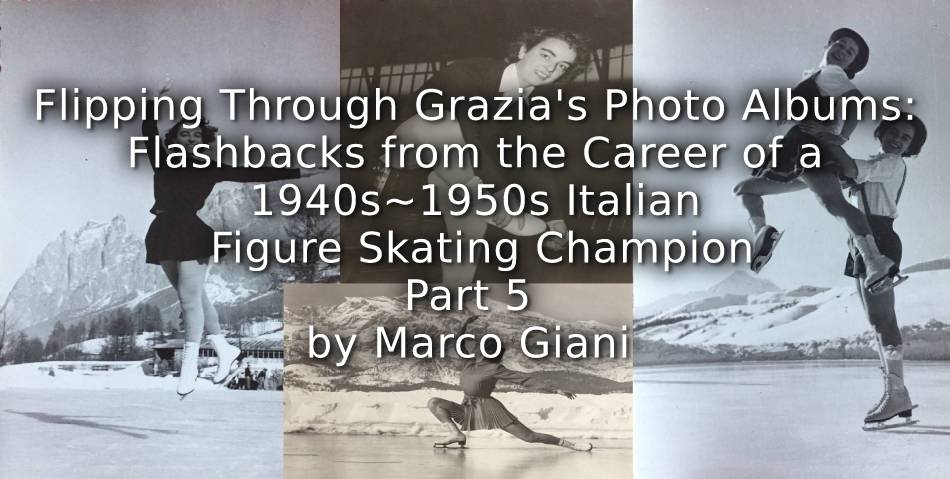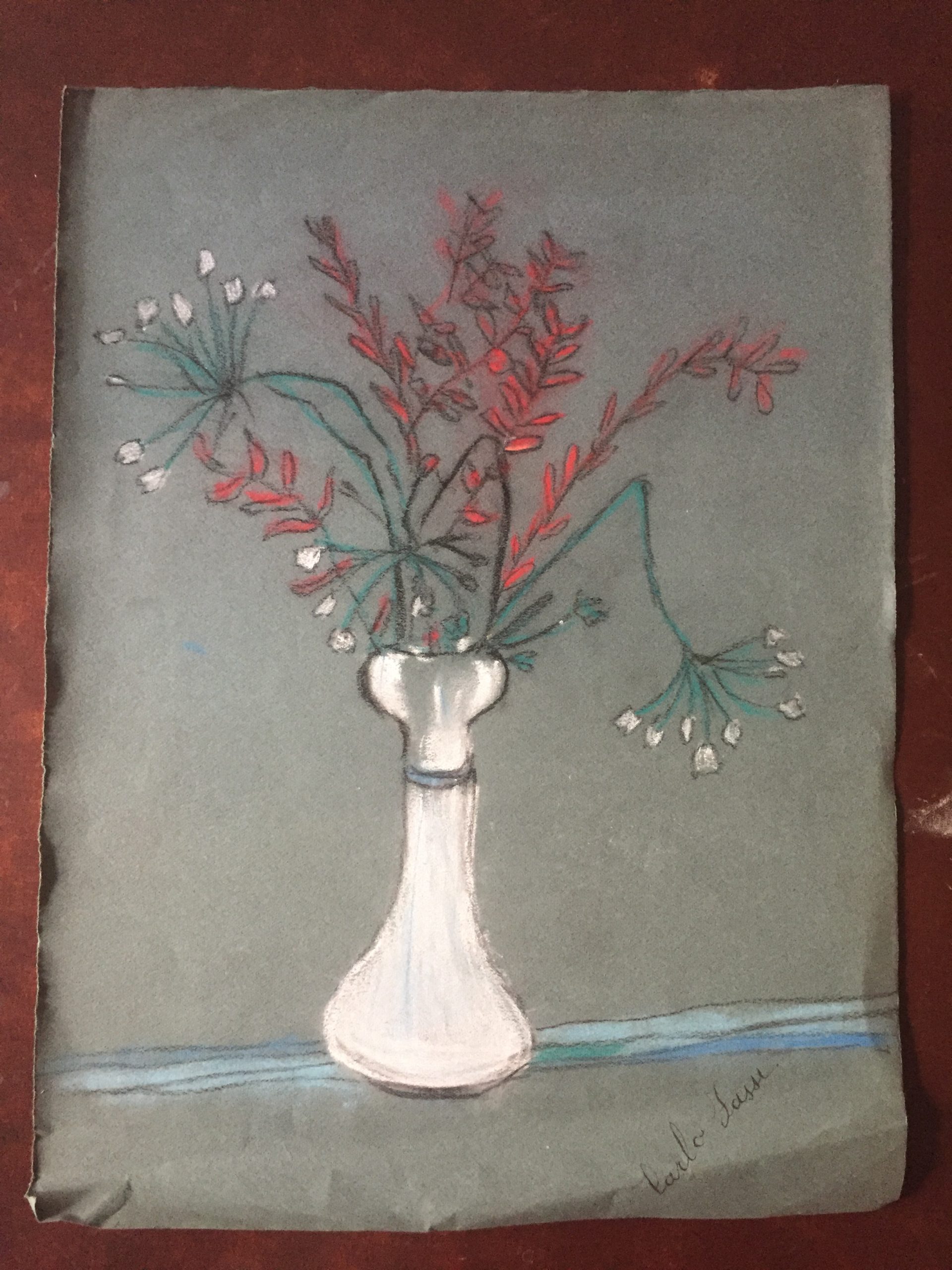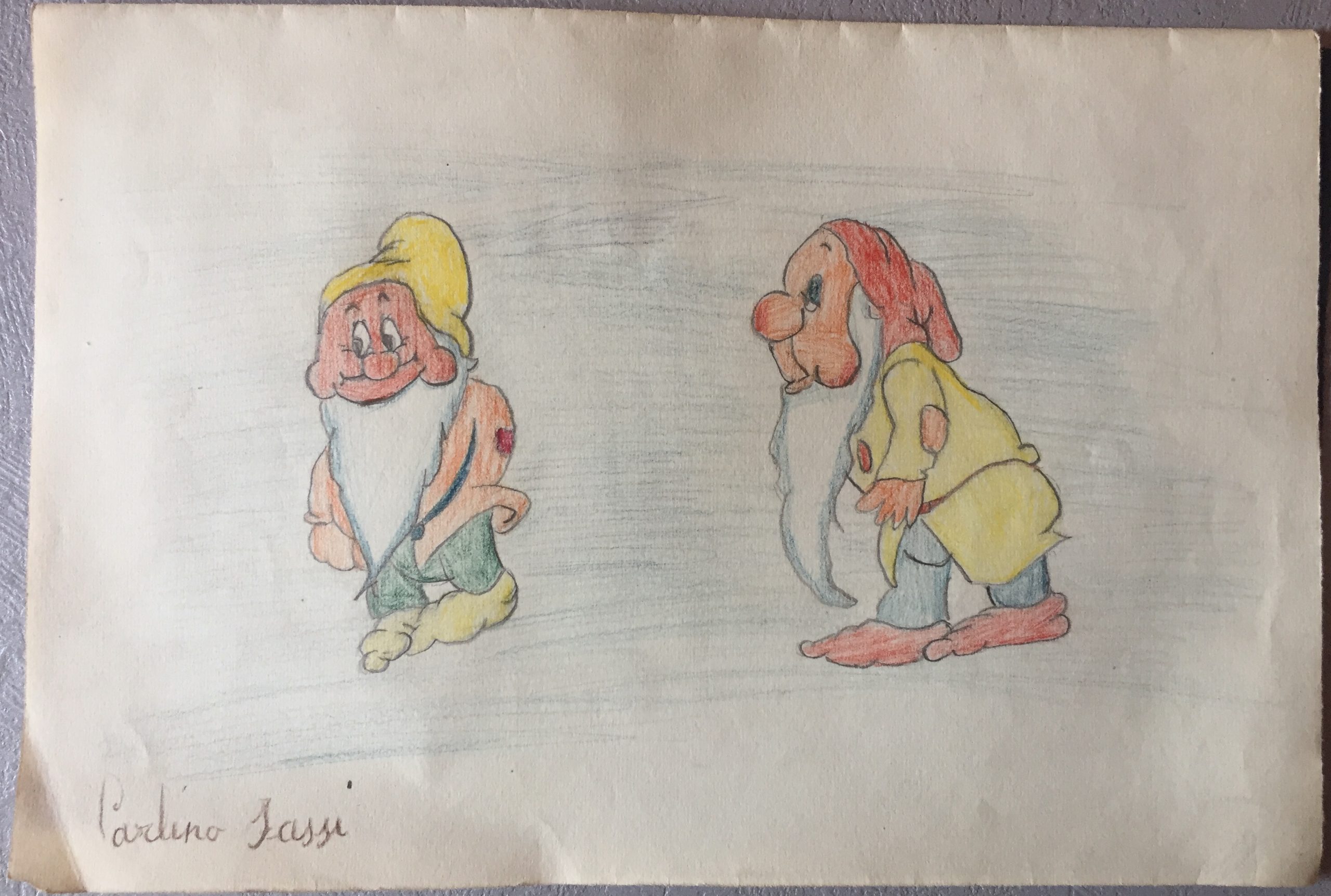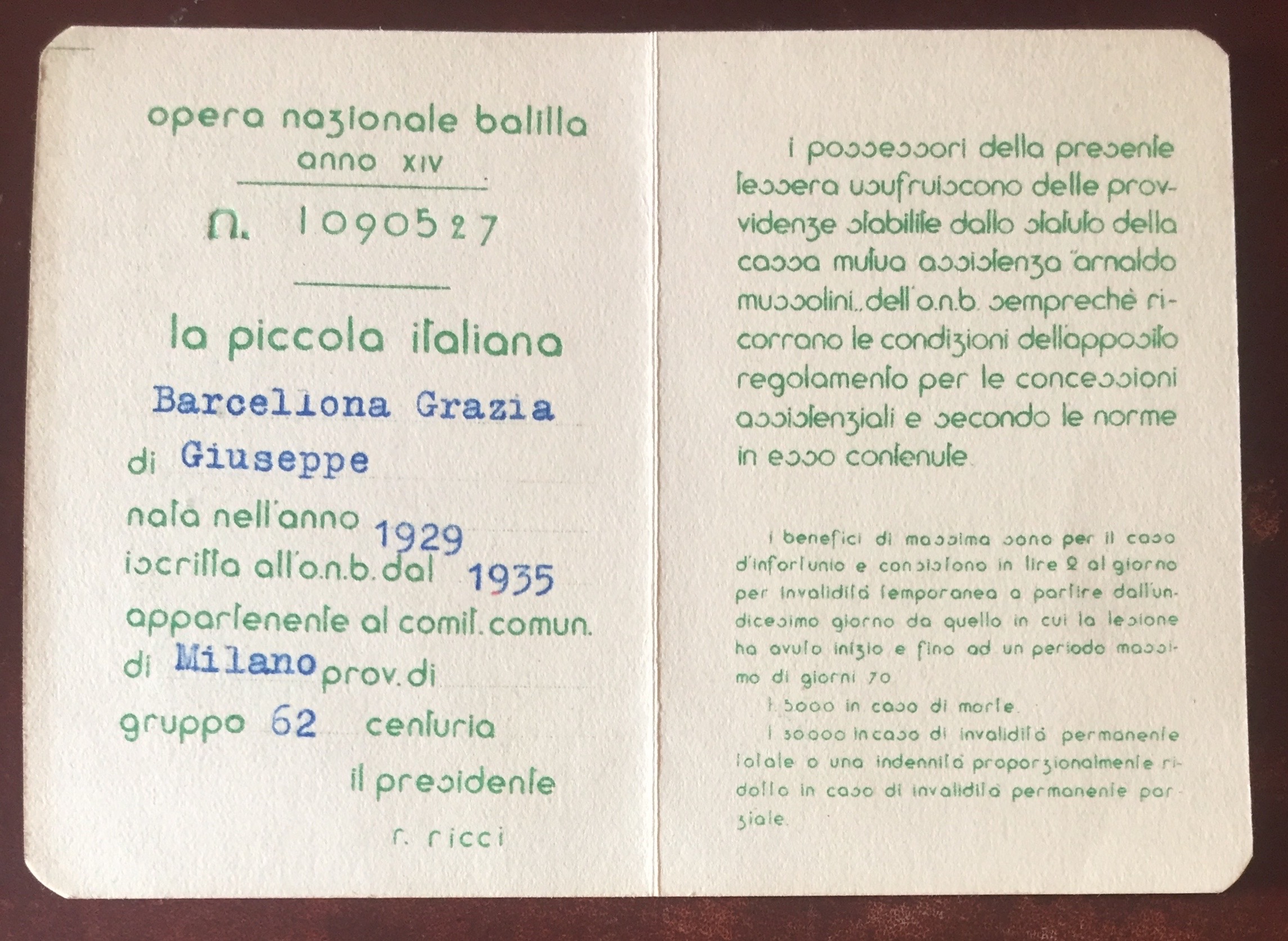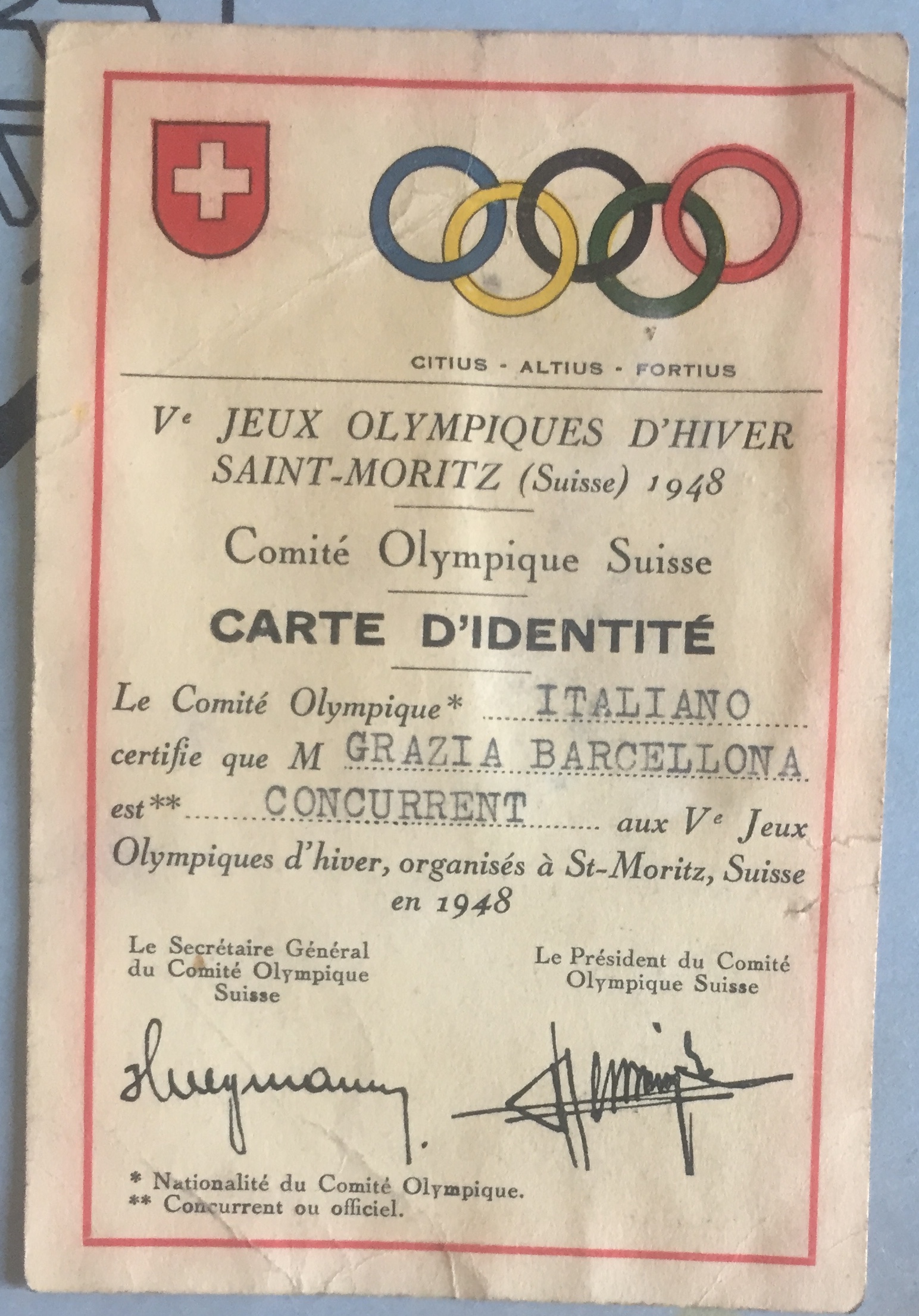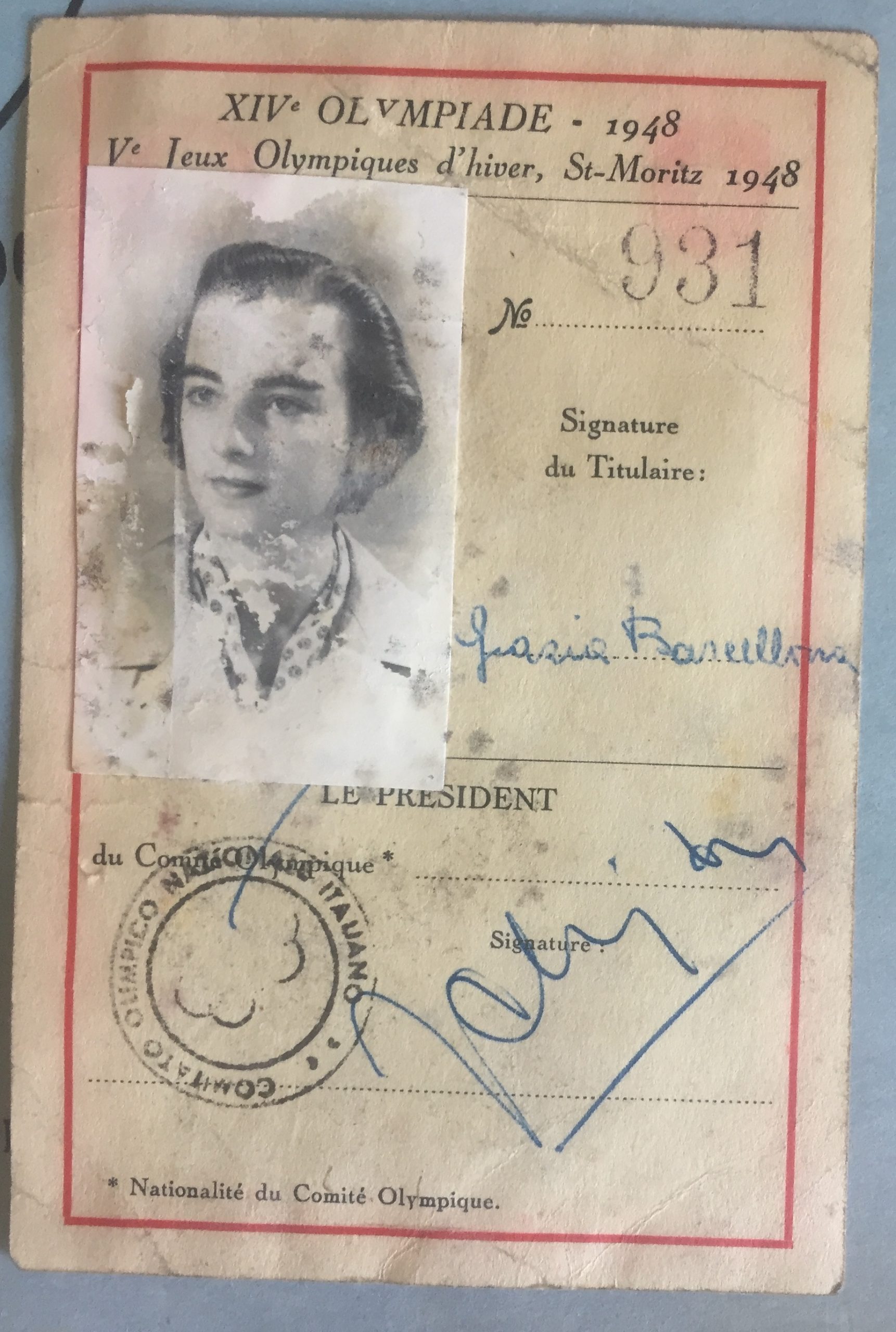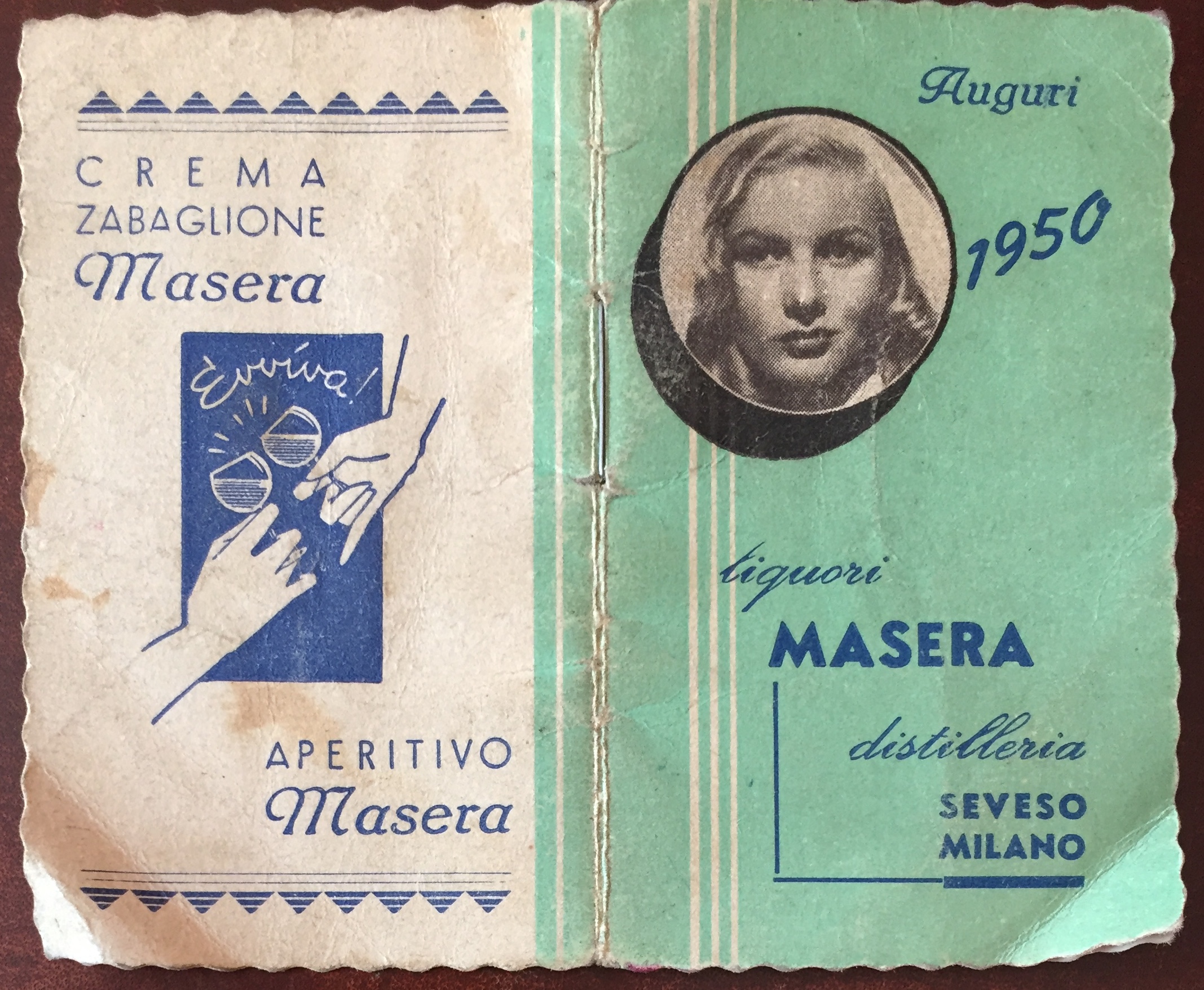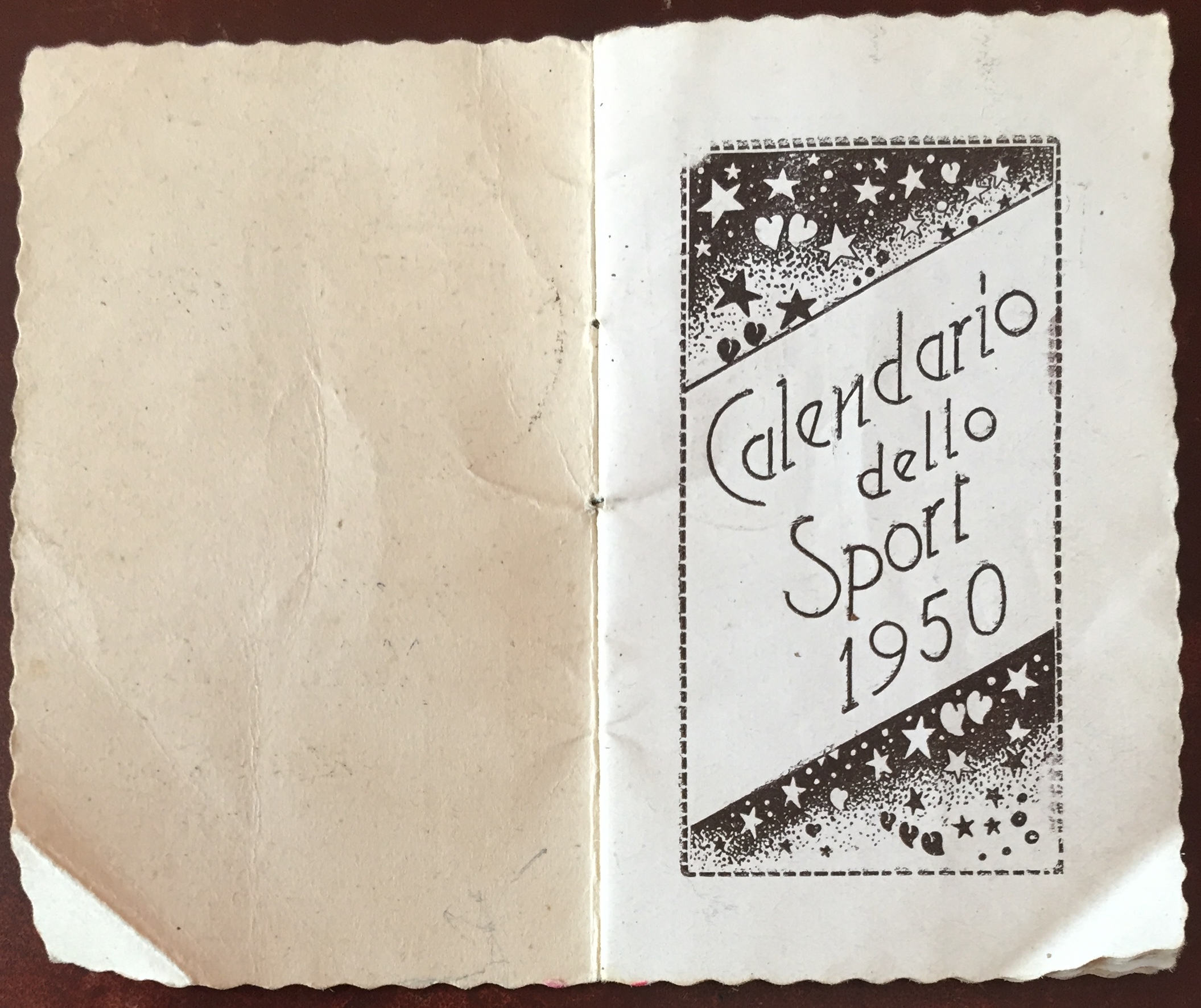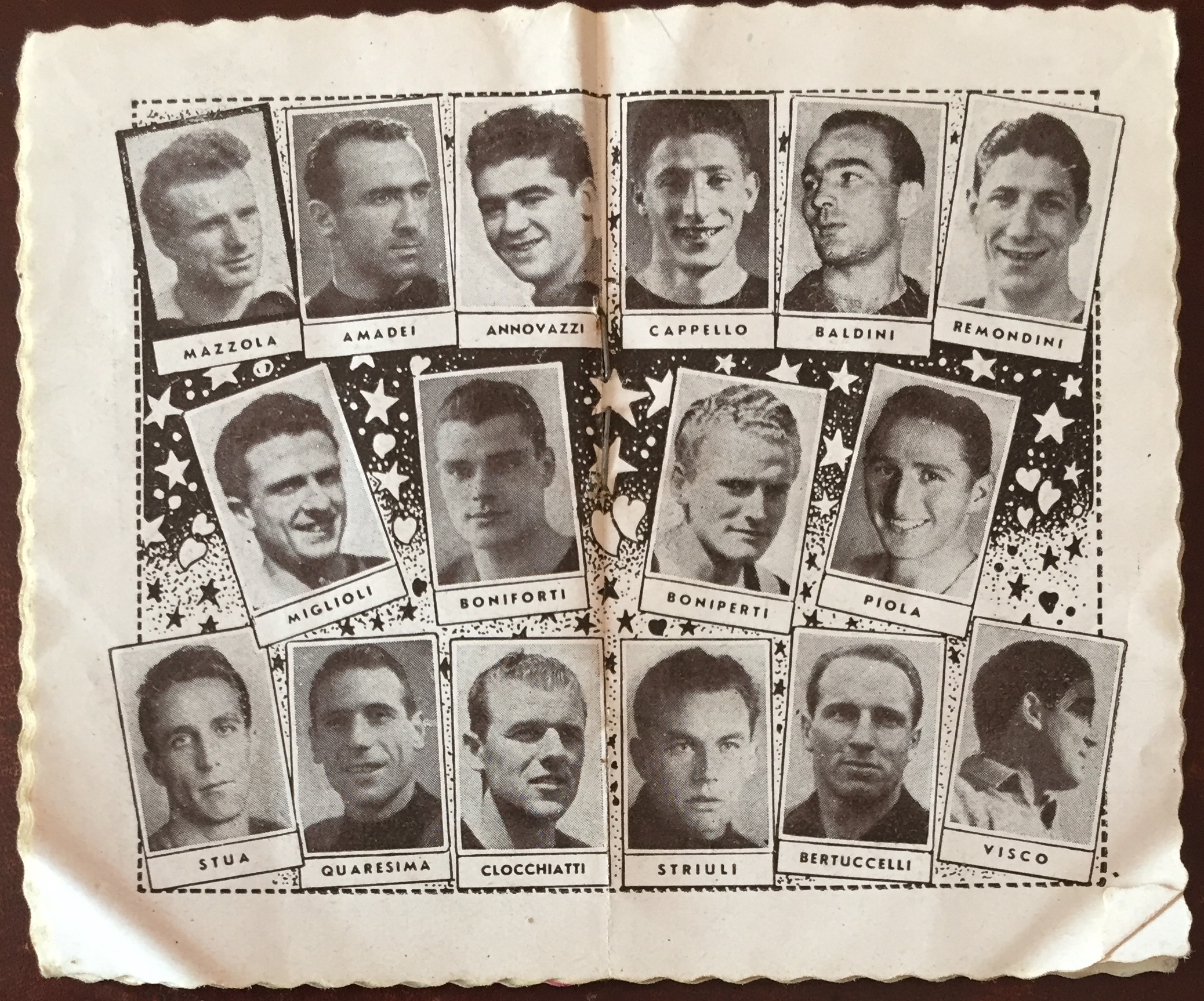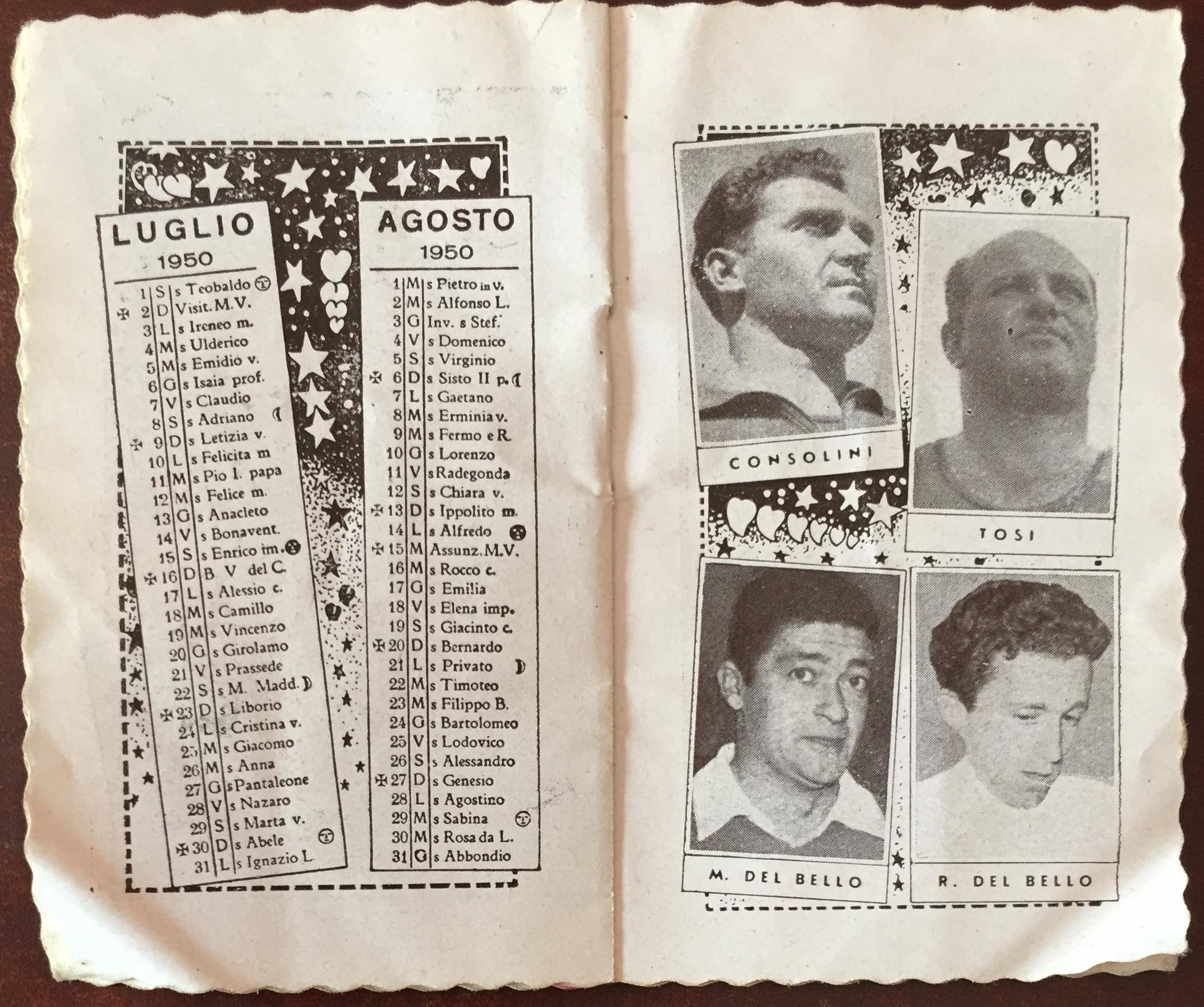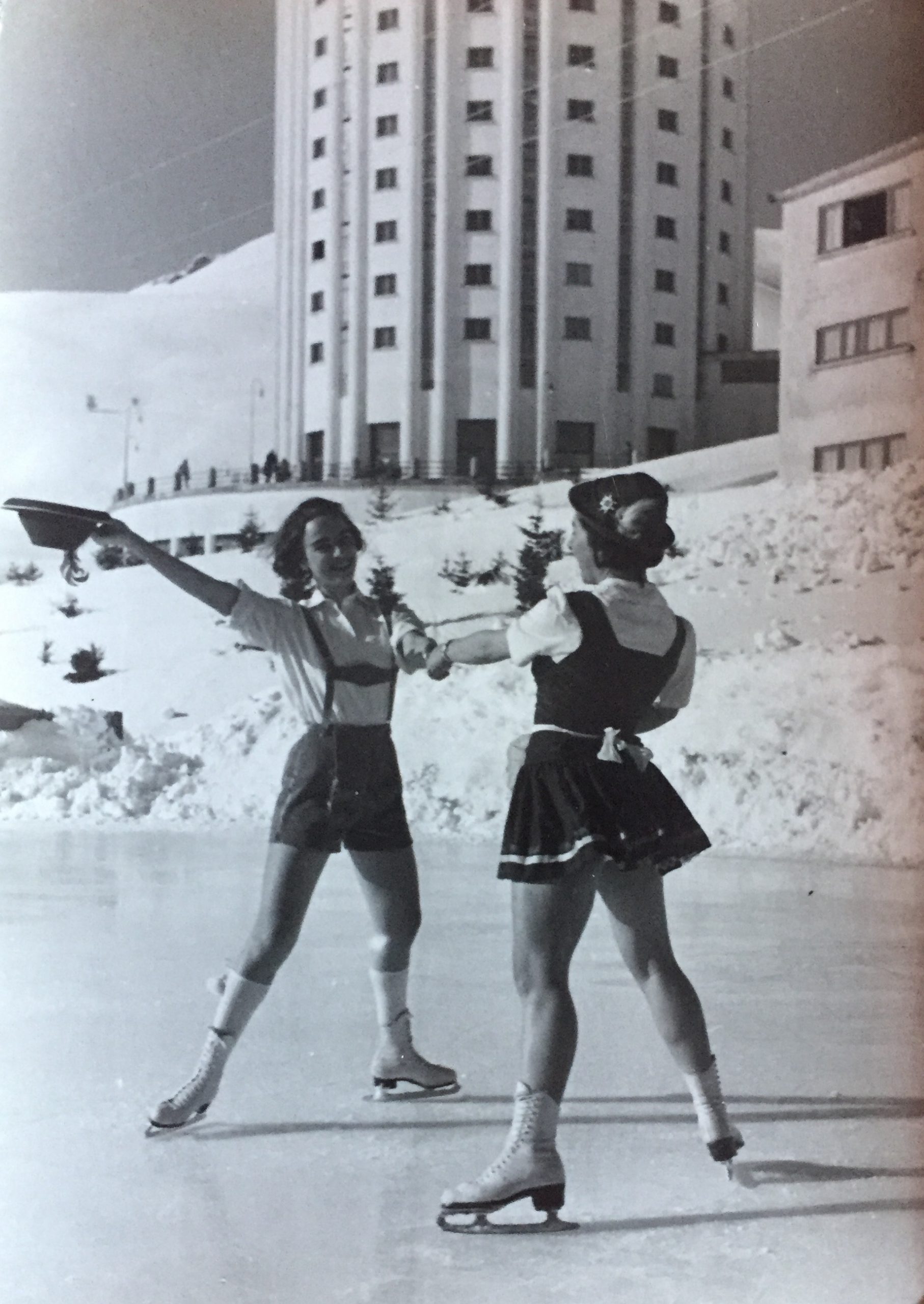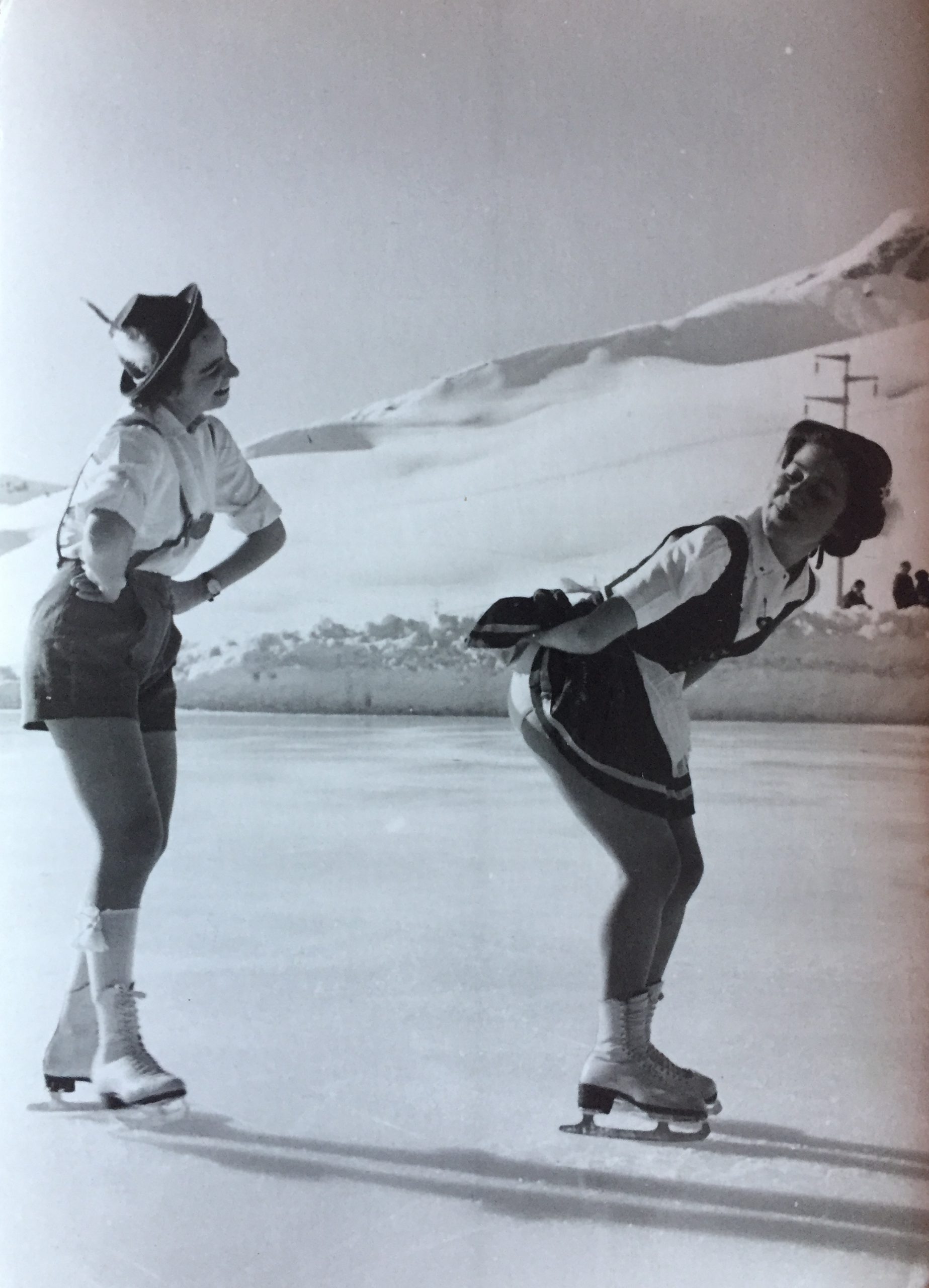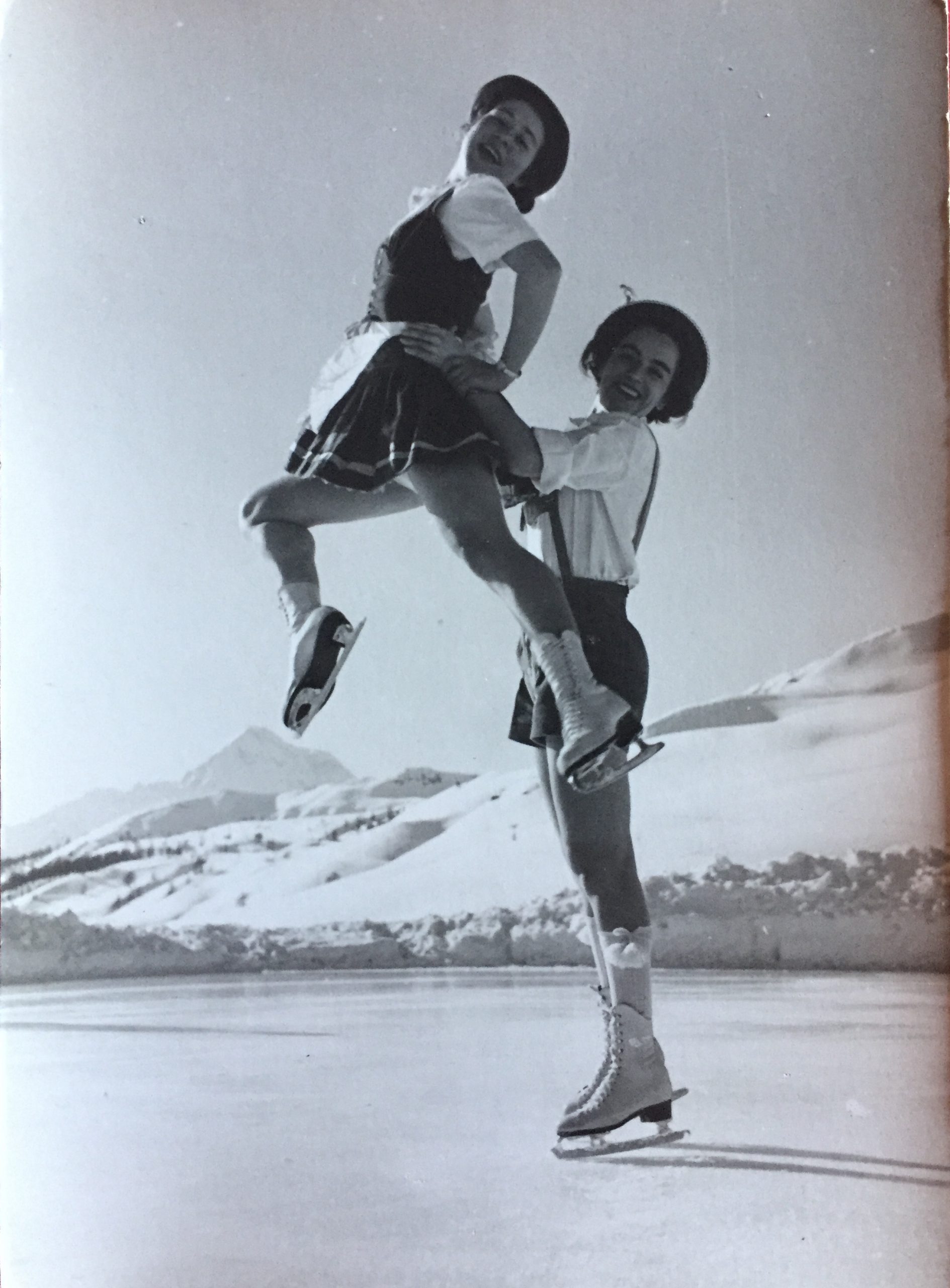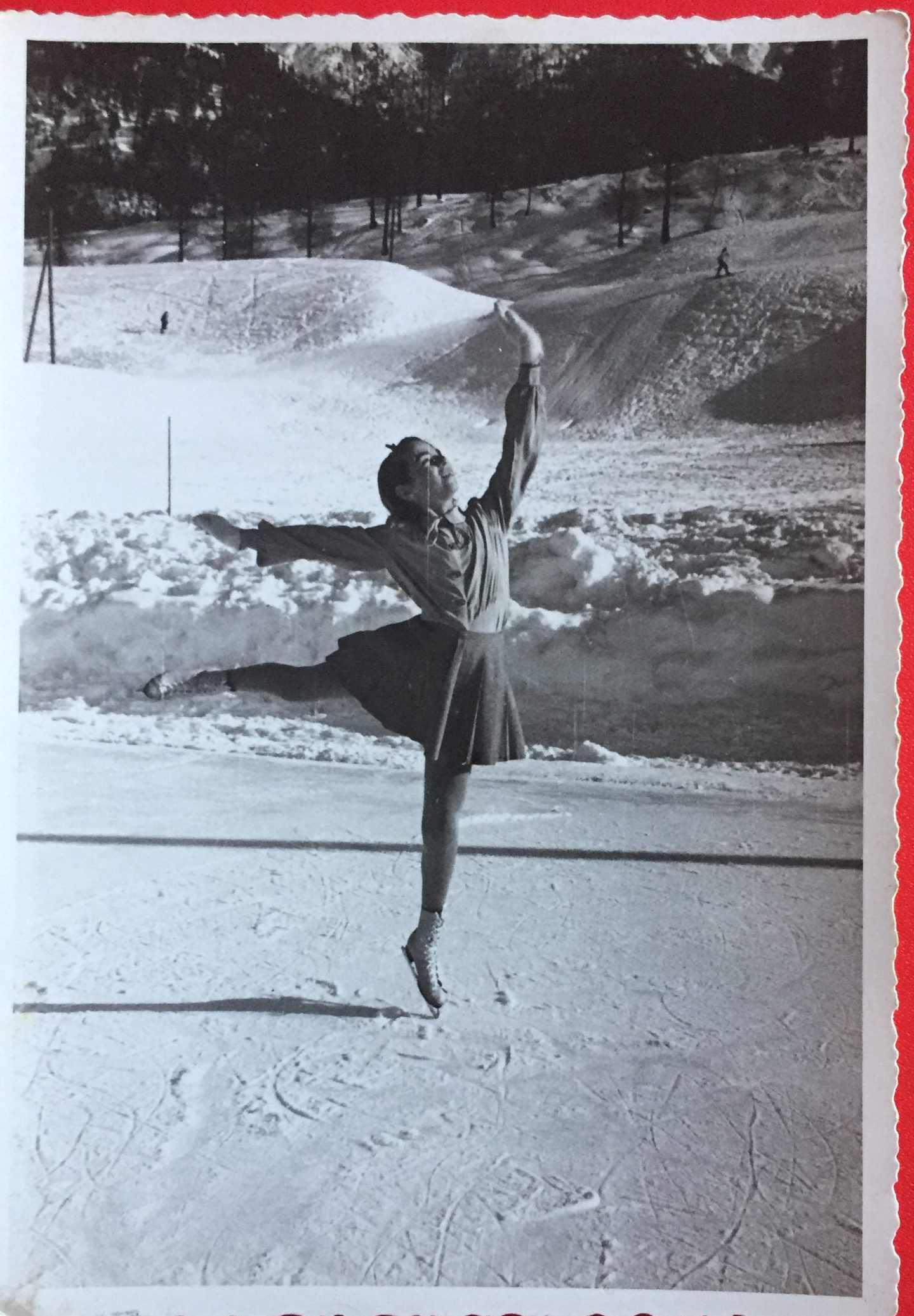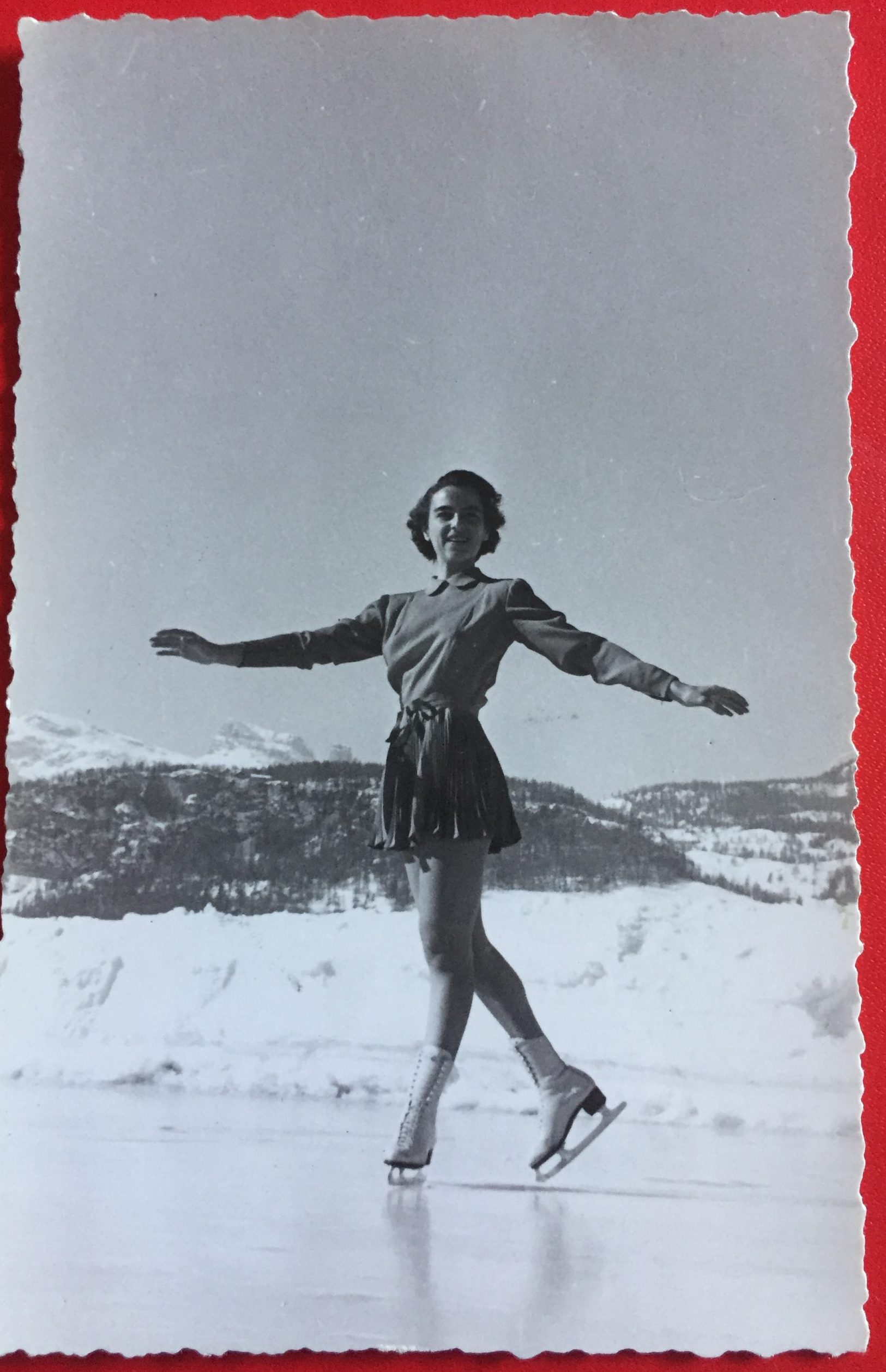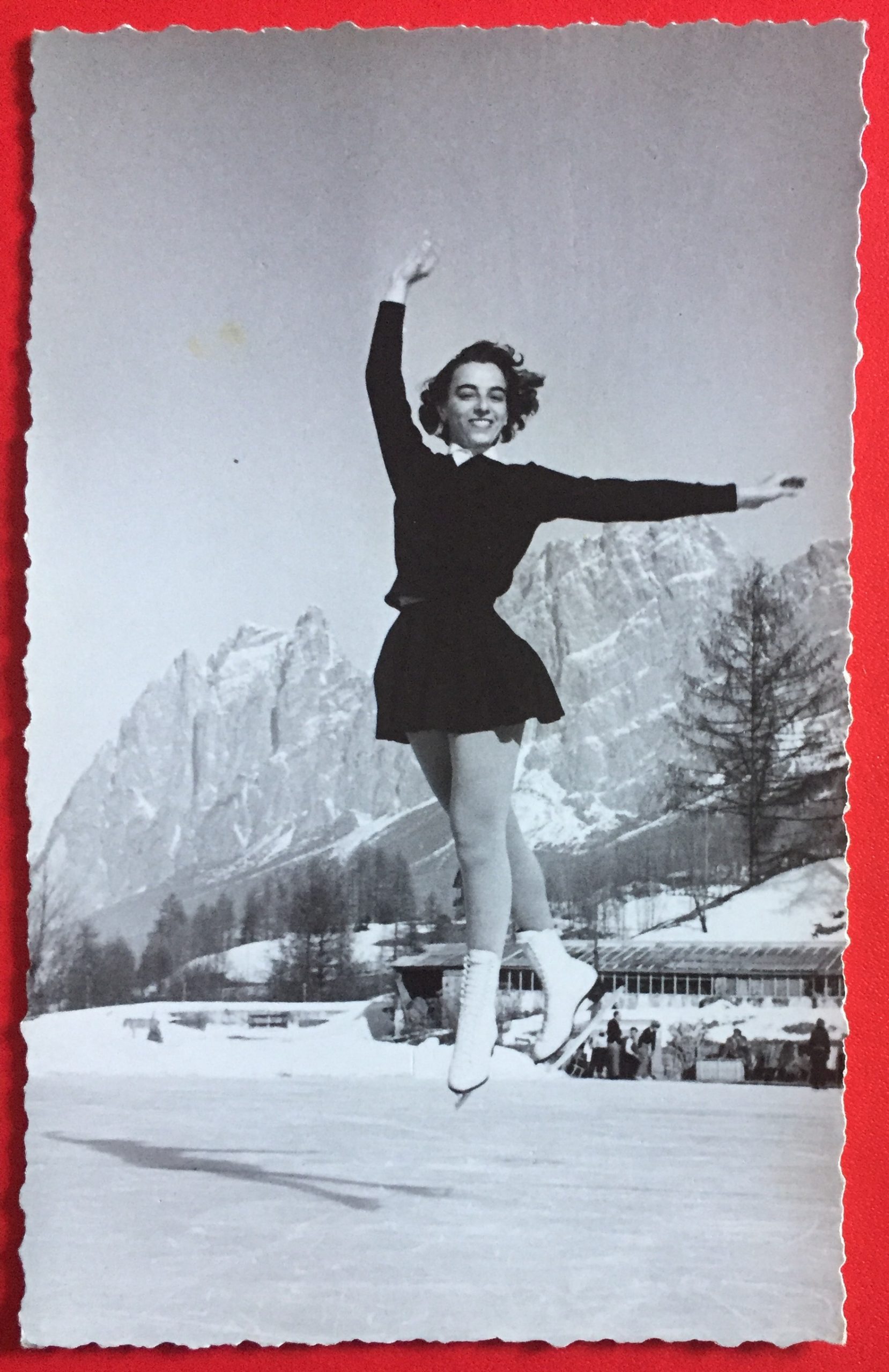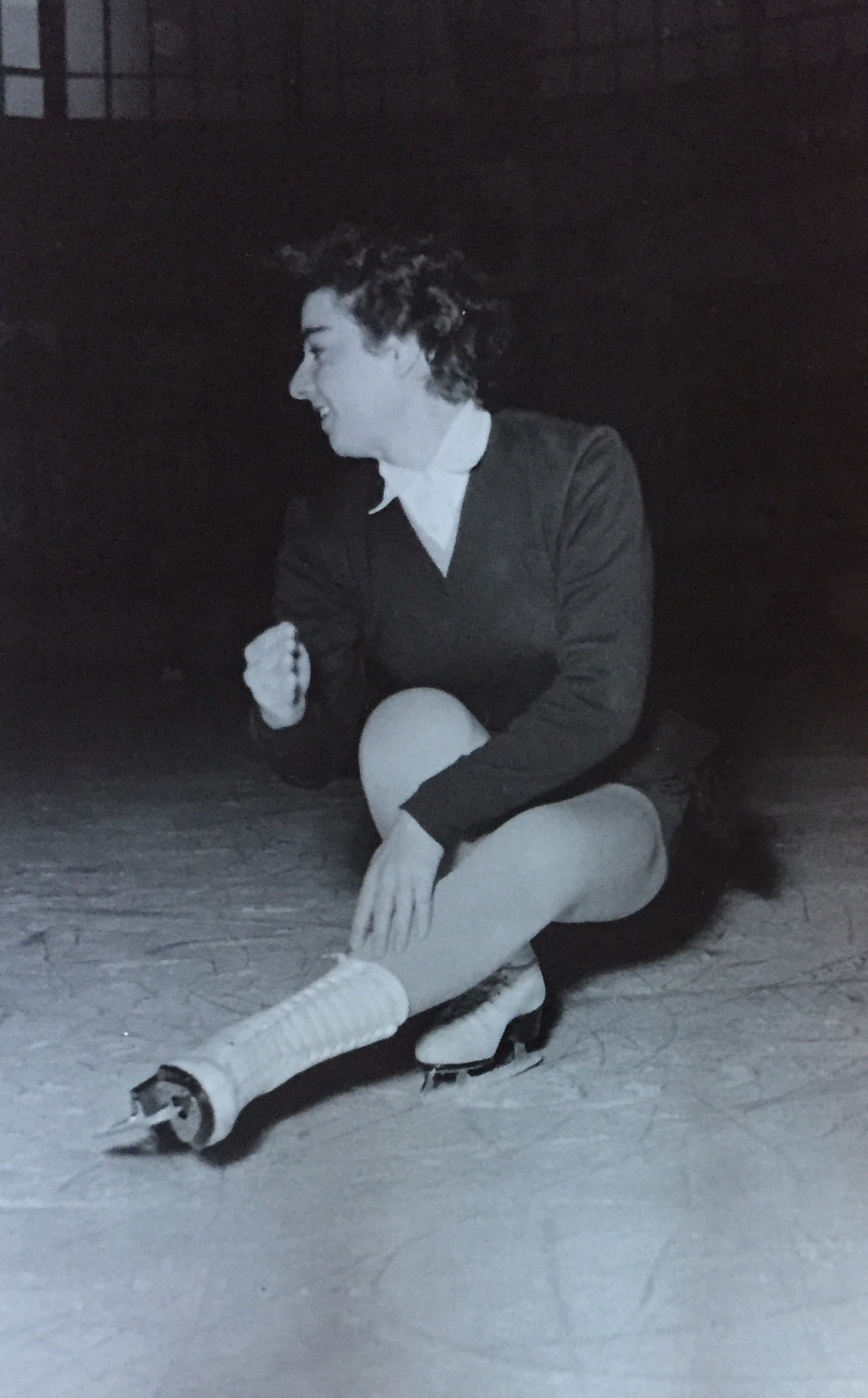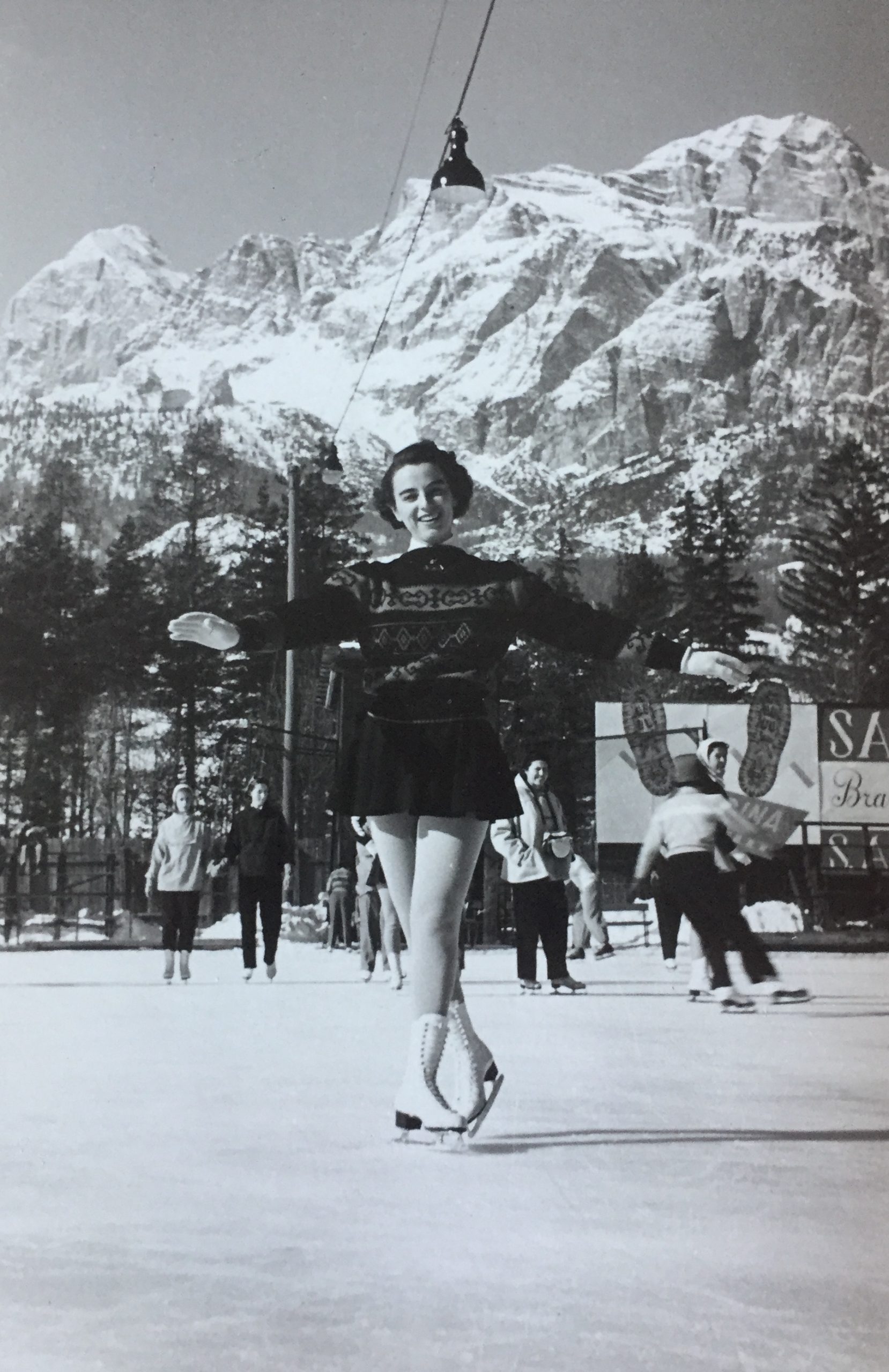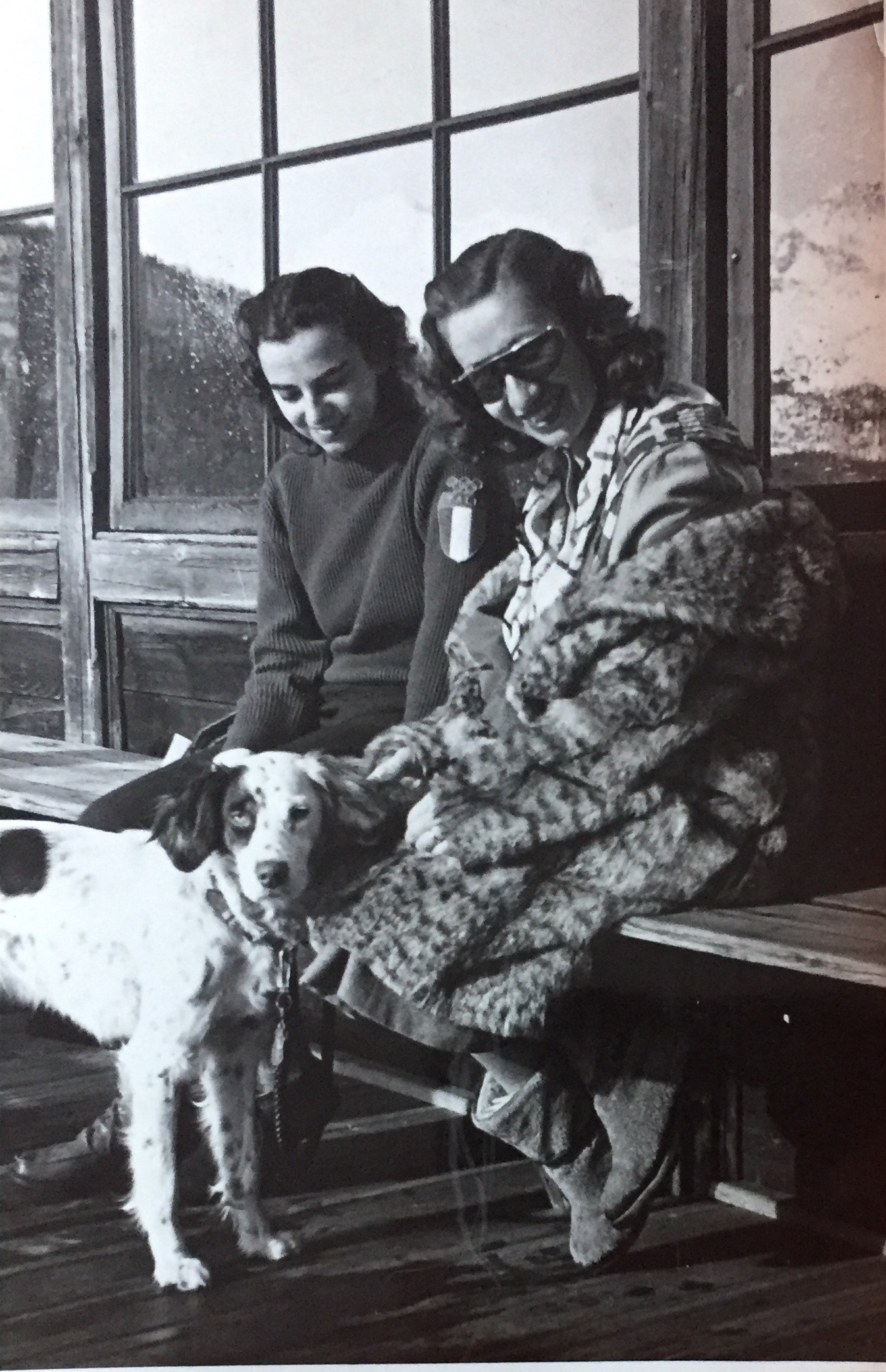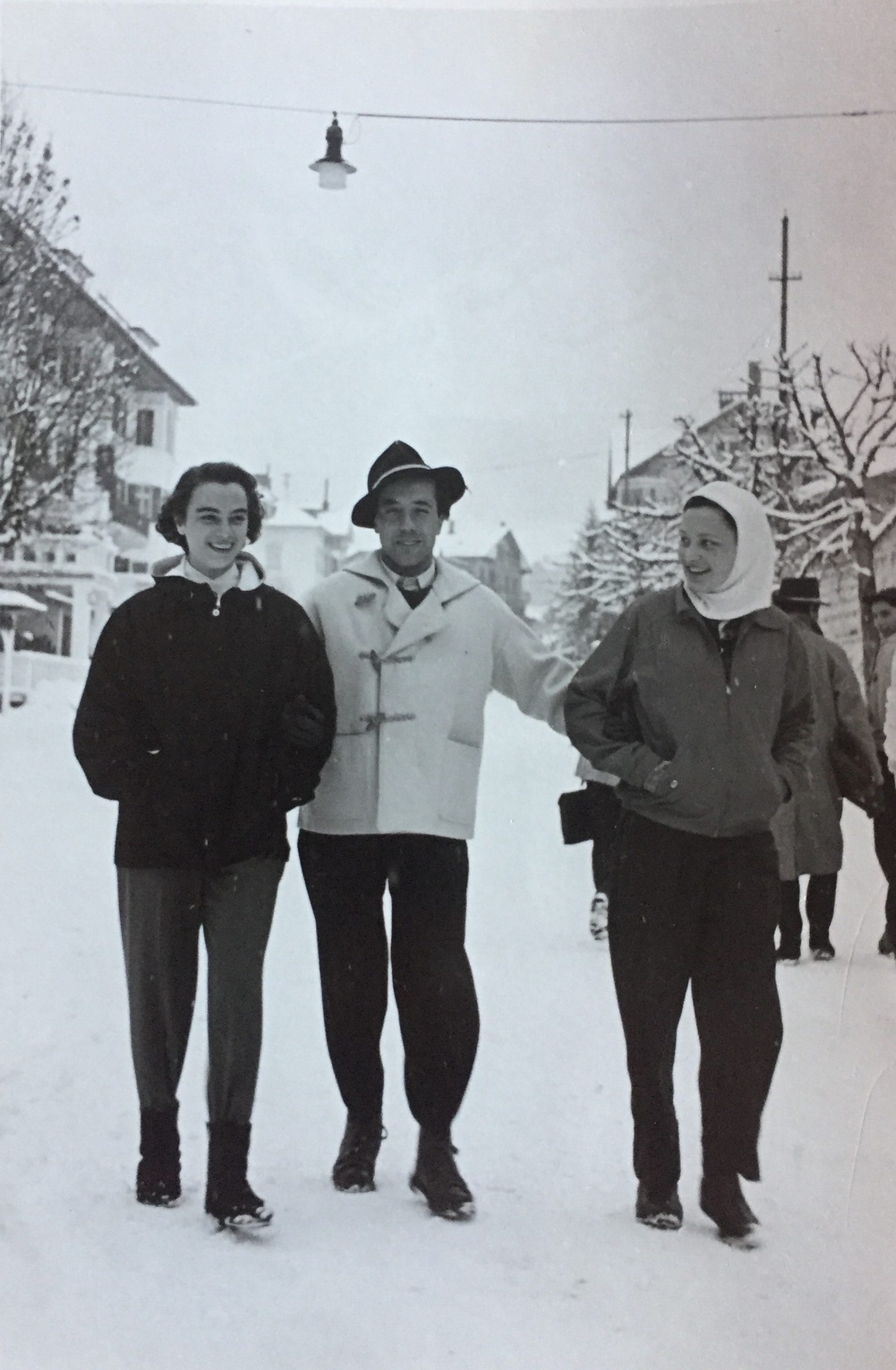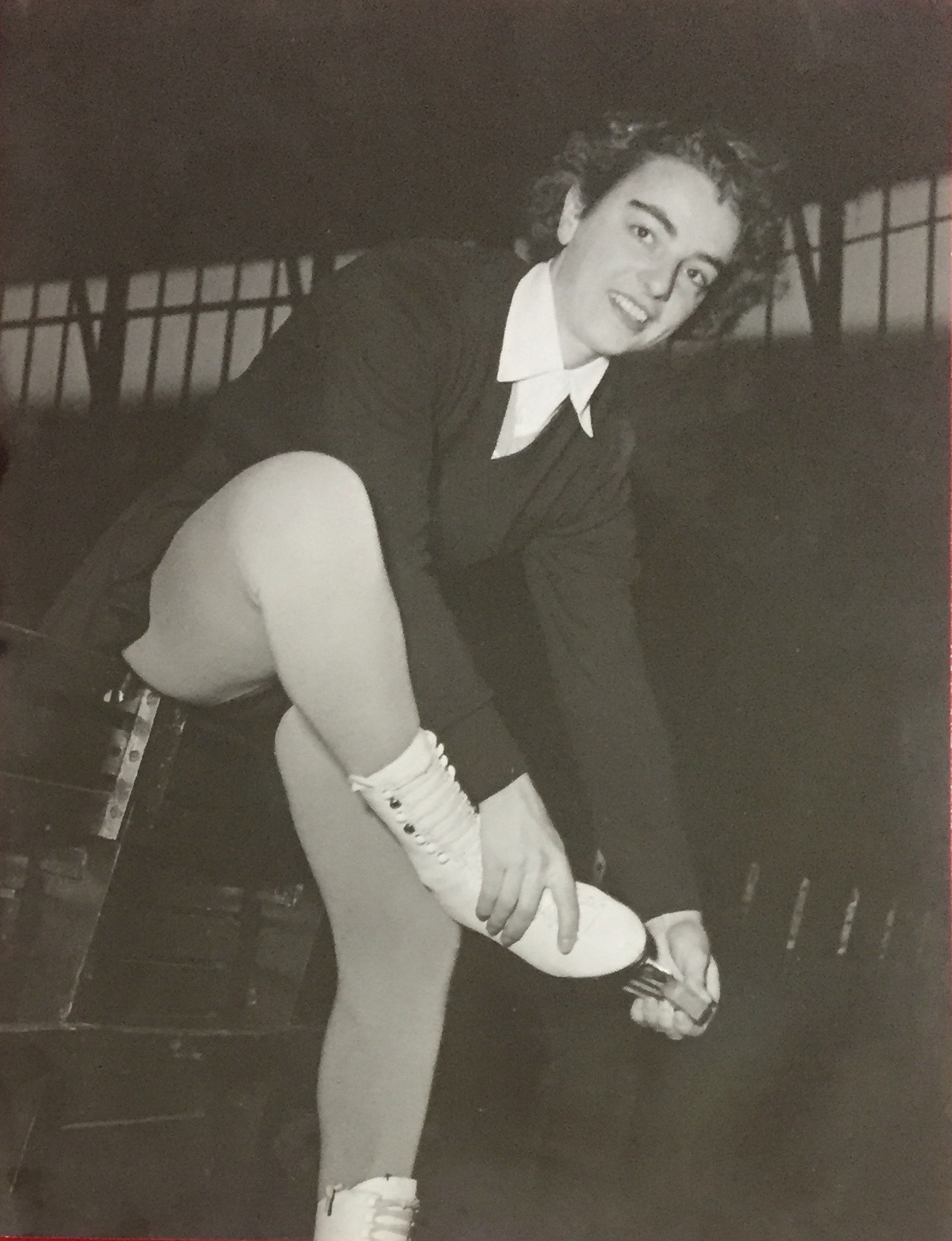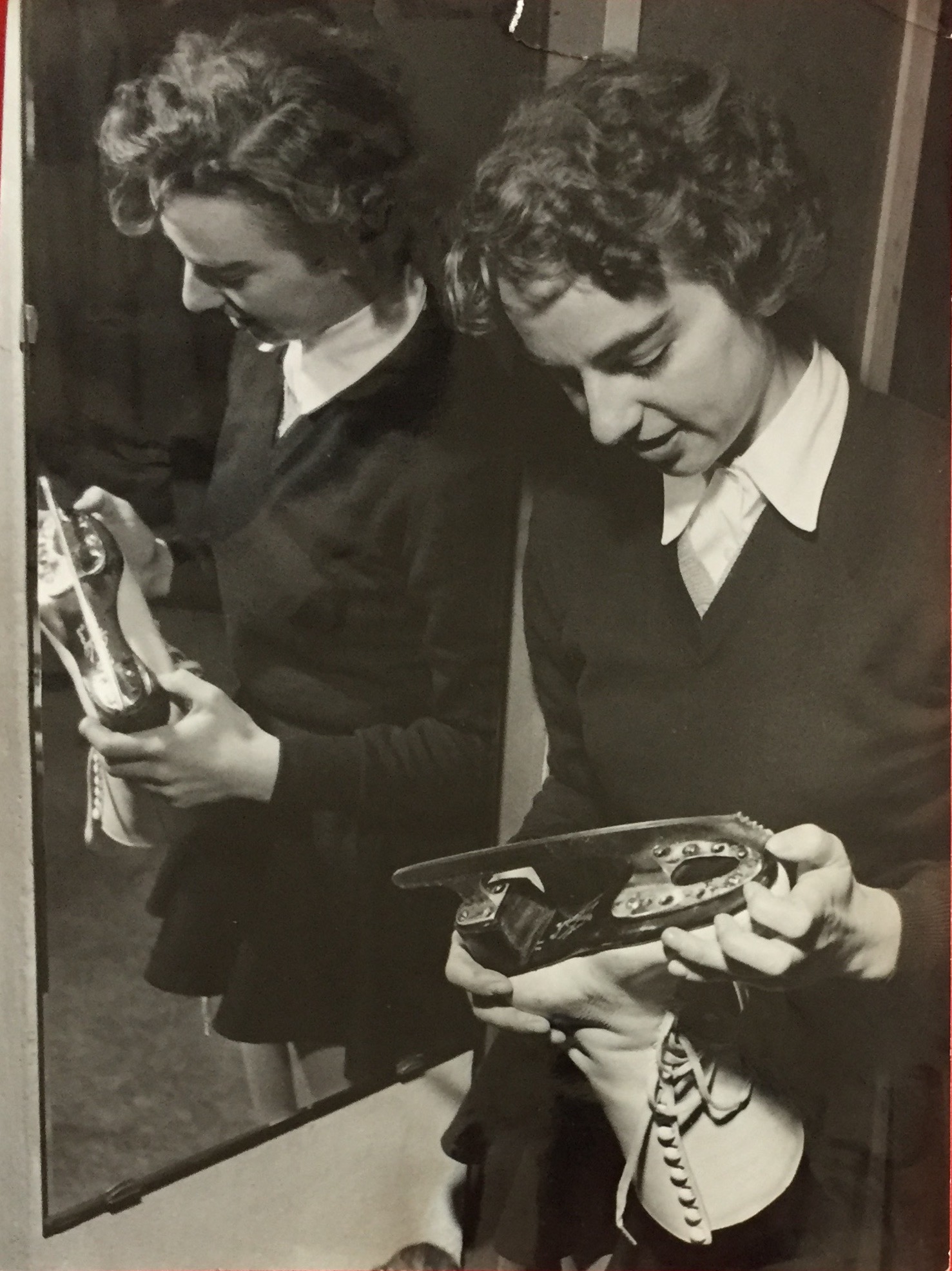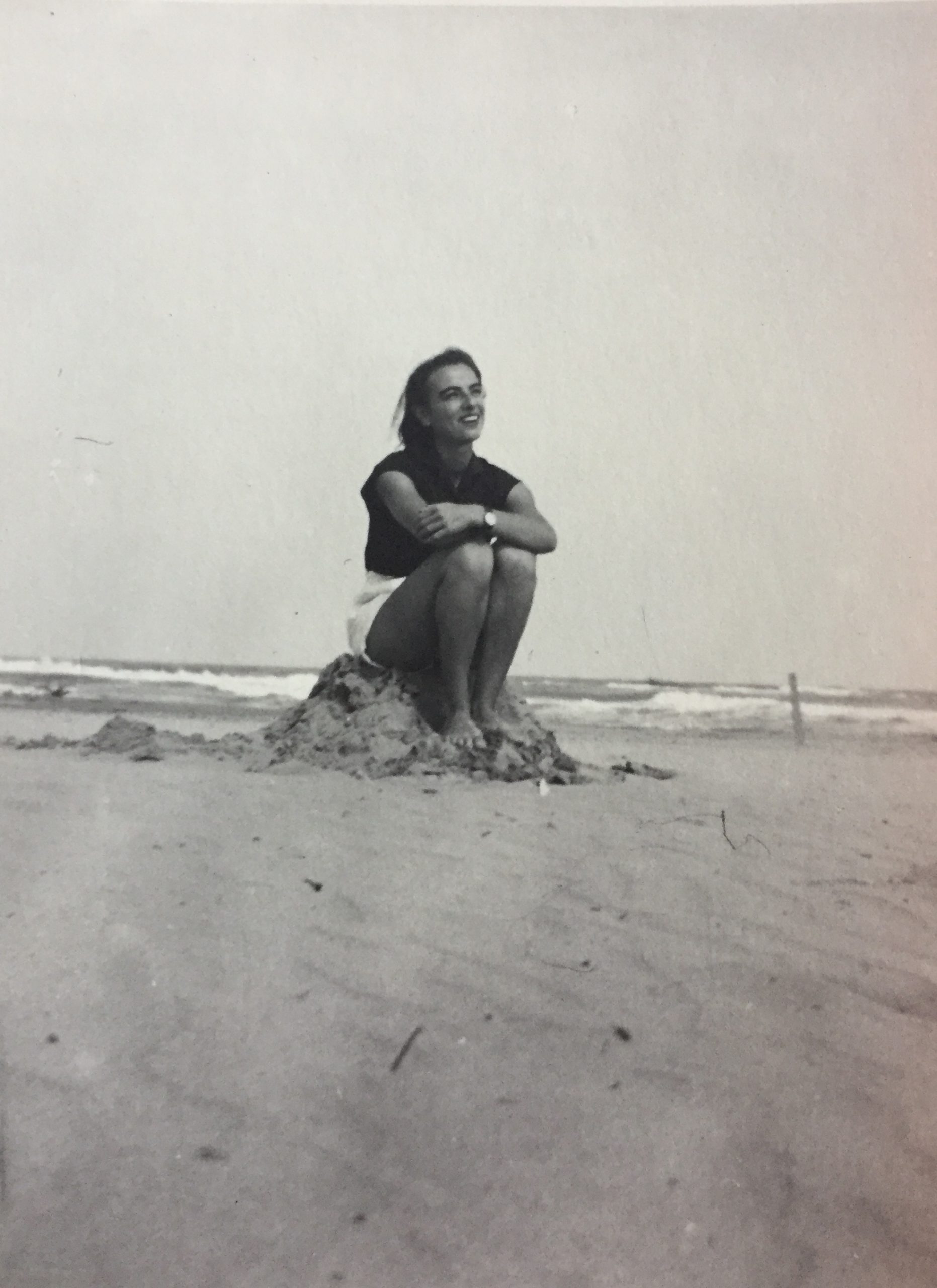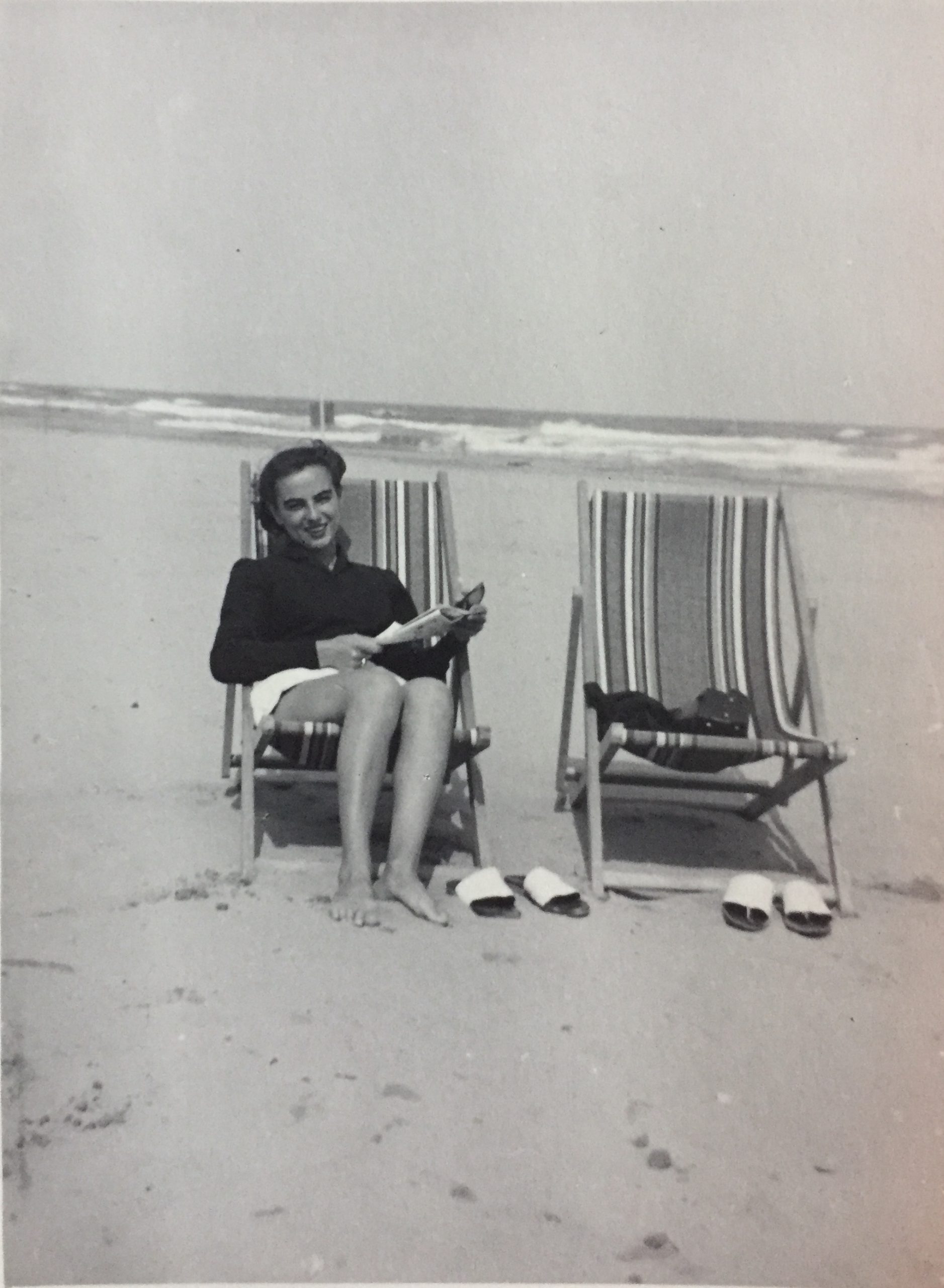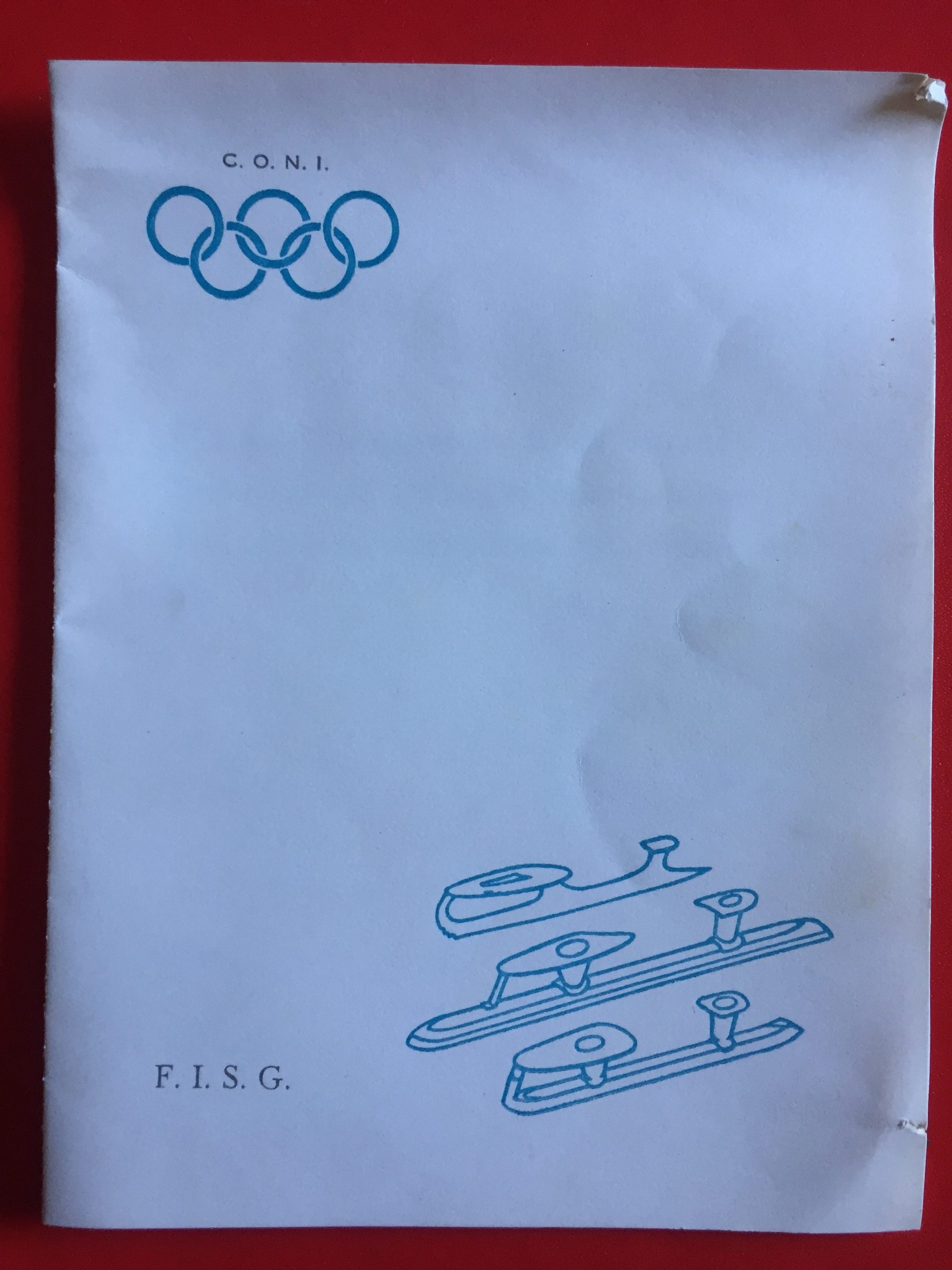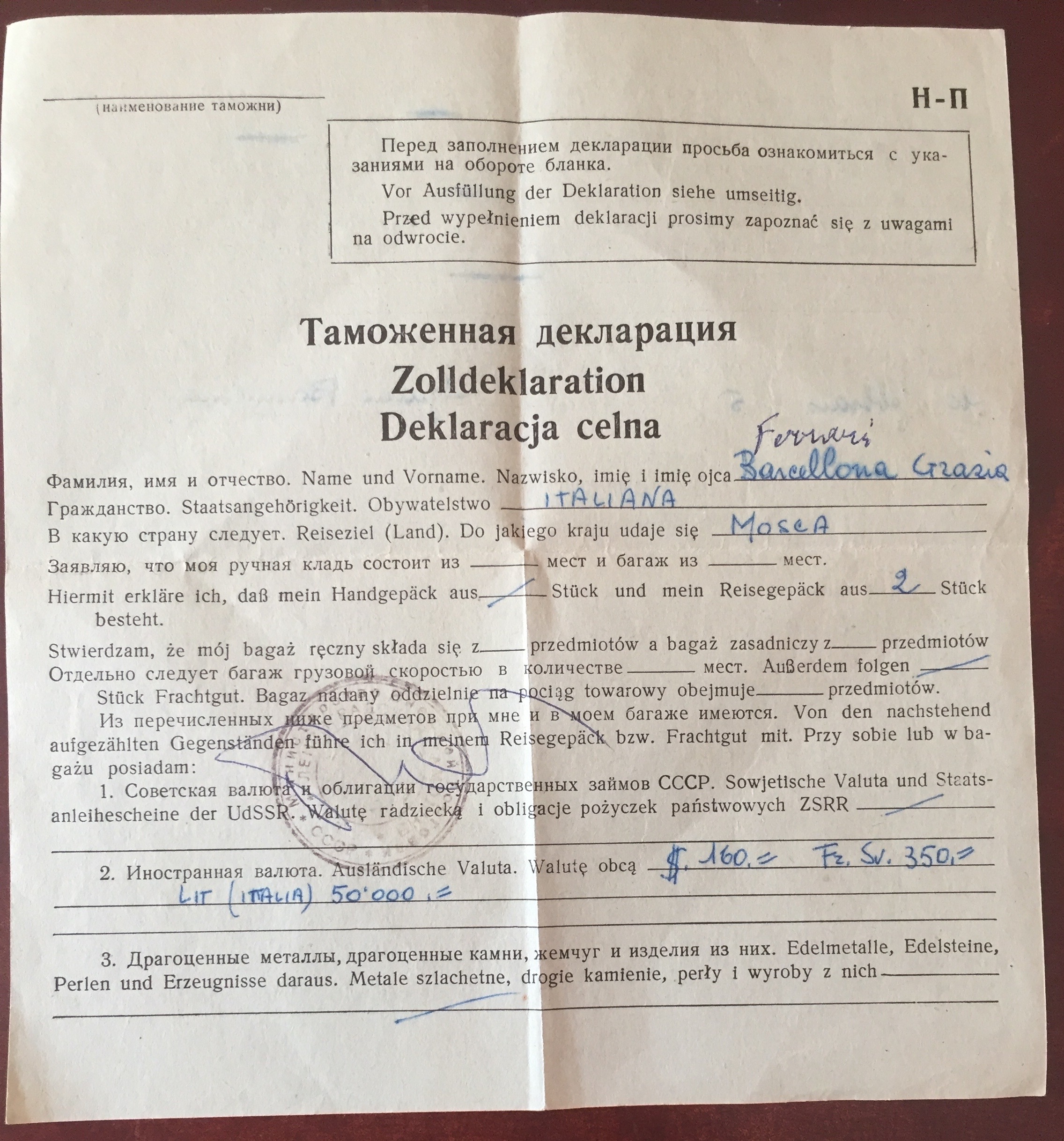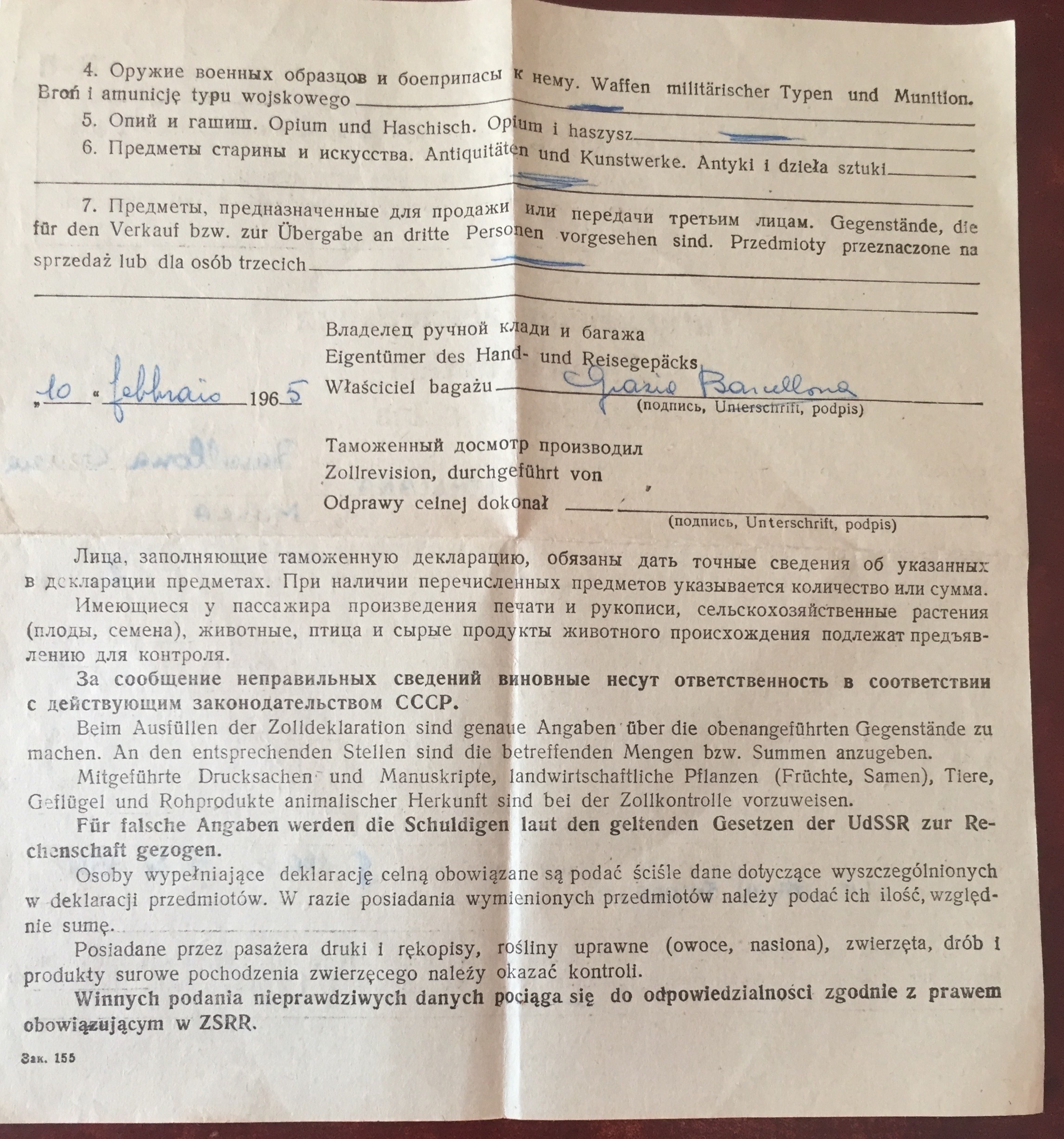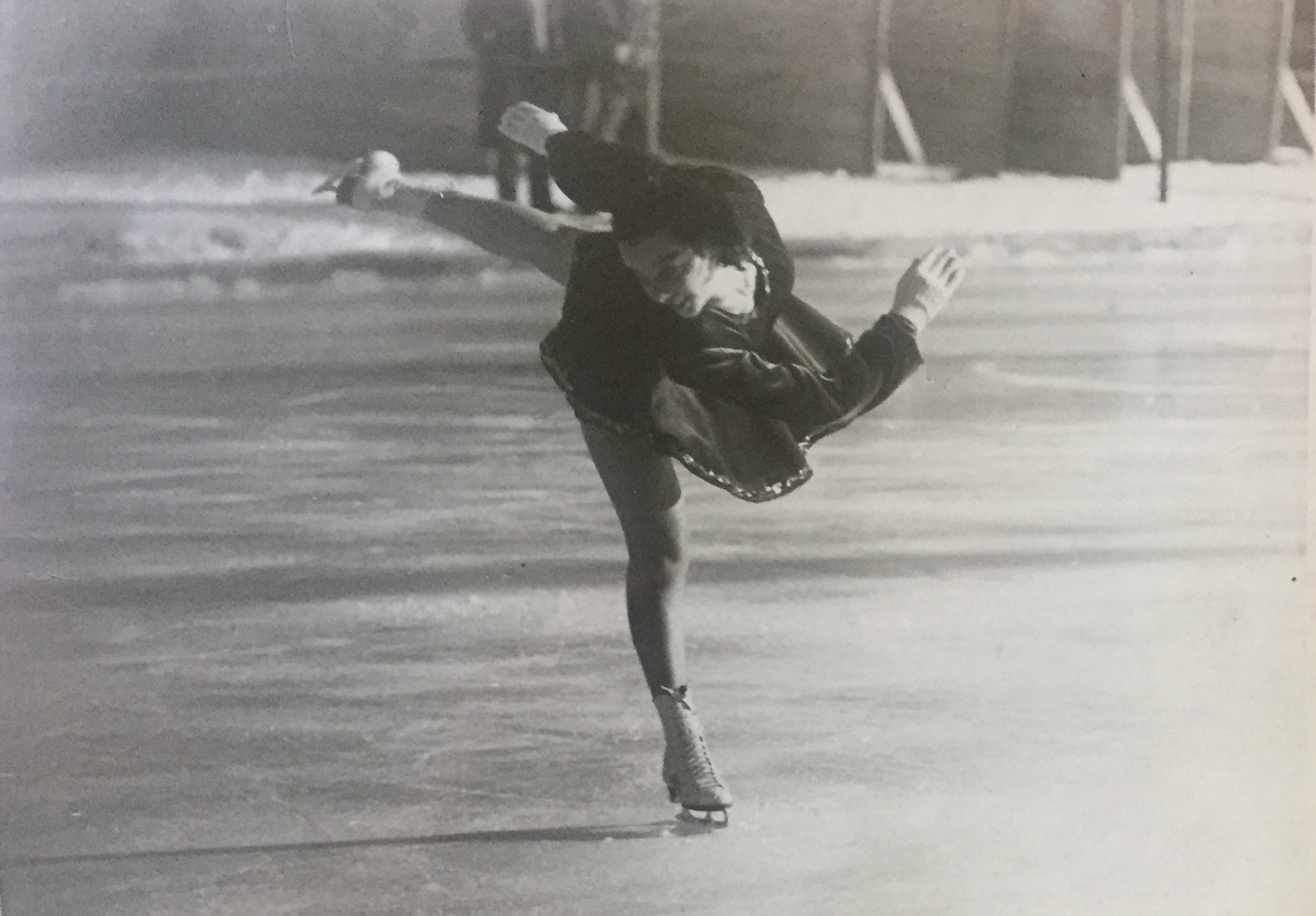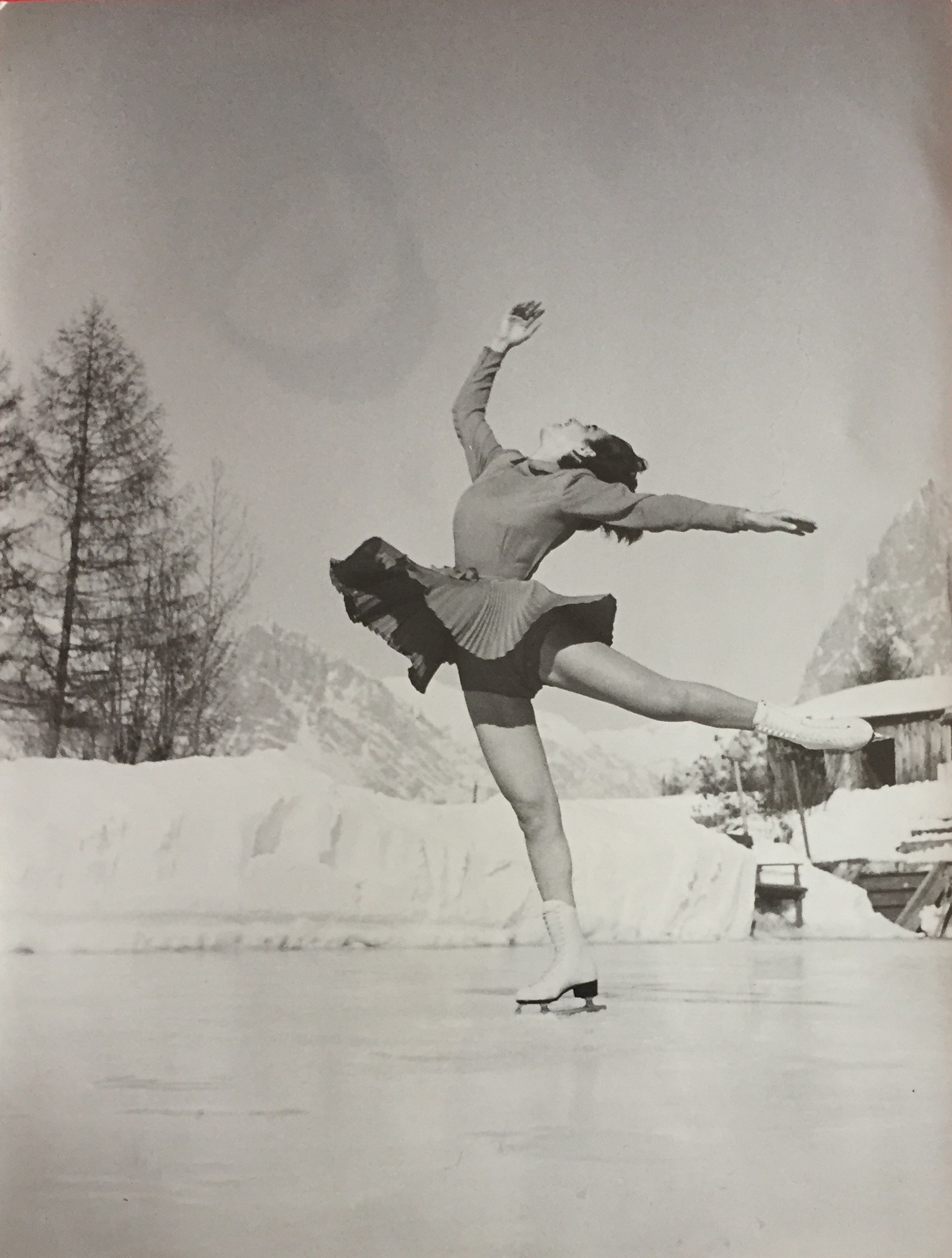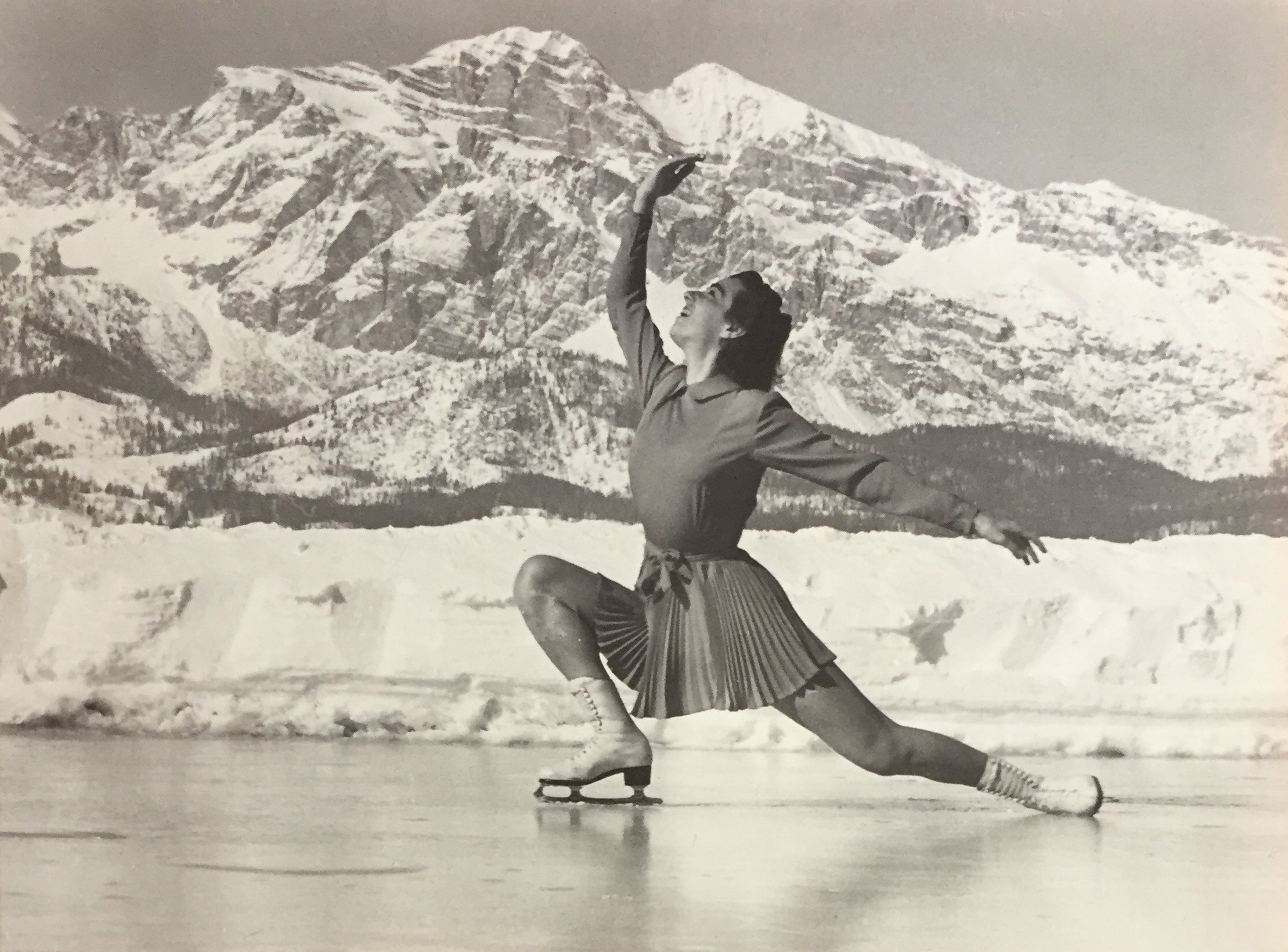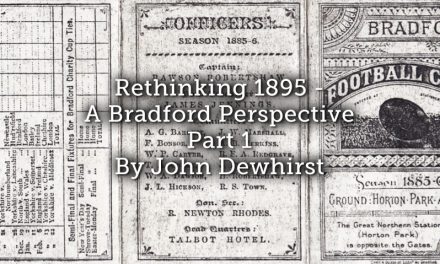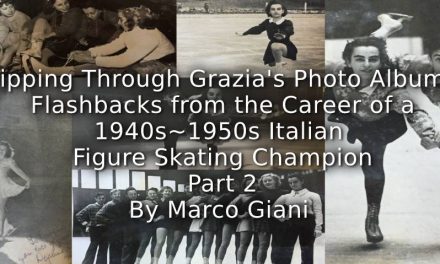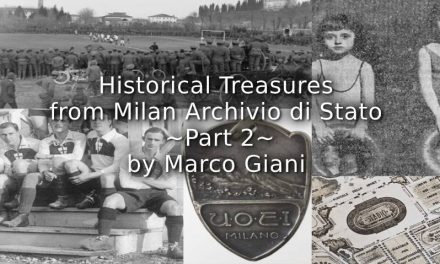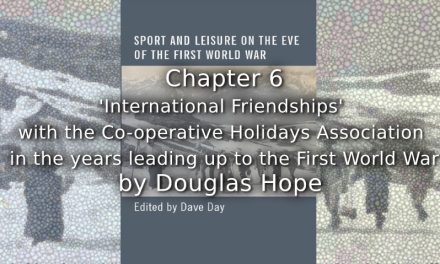All images are taken from Archivio personale Giovanna Boccalini Barcellona (except where noted), and reproduced her with the kind permission of Luigi and Francesco Ferrari.
PLEASE NOTE – Express permission is required to reproduce ANY of the images taken from these personal archives – please contact Playing Pasts or the author for more details.
To read earlier episodes of this series
Part 1 HERE , Part 2 HERE , Part 3 HERE , Part 4 HERE
The discovering of Giovanna Boccalini Barcellona’s personal archive in Summer 2020 (see https://bit.ly/2Z4GRCj ) is very important not only for the historical reconstruction of the women’s football movement in 1930s’ Italy: Giovanna was not only the team manager of her sisters’ football team but also the mother of Grazia Barcellona Ferrari (1929-2020), the figure skater who Playing Pasts readers have already learnt about in the first 4 parts of this series. Sadly Grazia, who was still alive when these parts were published in Summer 2019, sadly passed away, on 2 October 2019 at the grand age of 90 years old; nevertheless, documents and photos discovered in her mother’s archive and a recent interview to her eldest daughter Cristina Ferrari (b. 1962) gives us access to new elements of Grazia’s story.
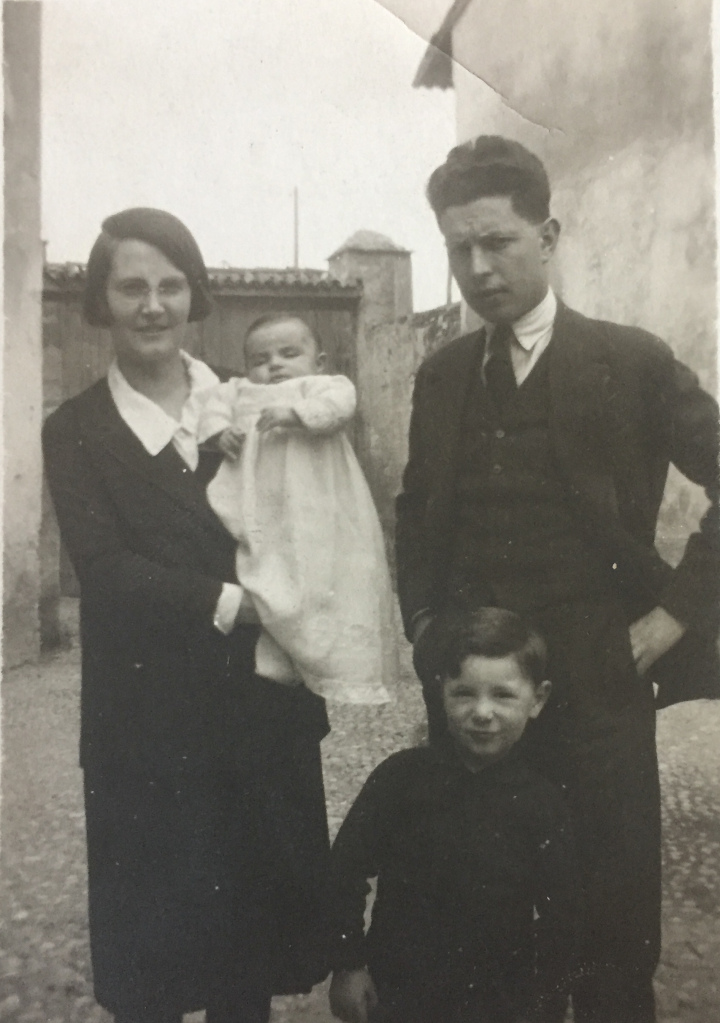
Giovanna Boccalini Barcellona holding the newly born Grazia; Giuseppe Barcellona; their 1st born Giacomo “Popi” Barcellona
Although the family had already moved to Milan, this 1929 photo was taken in Lodi, the hometown of Boccalini’s family.
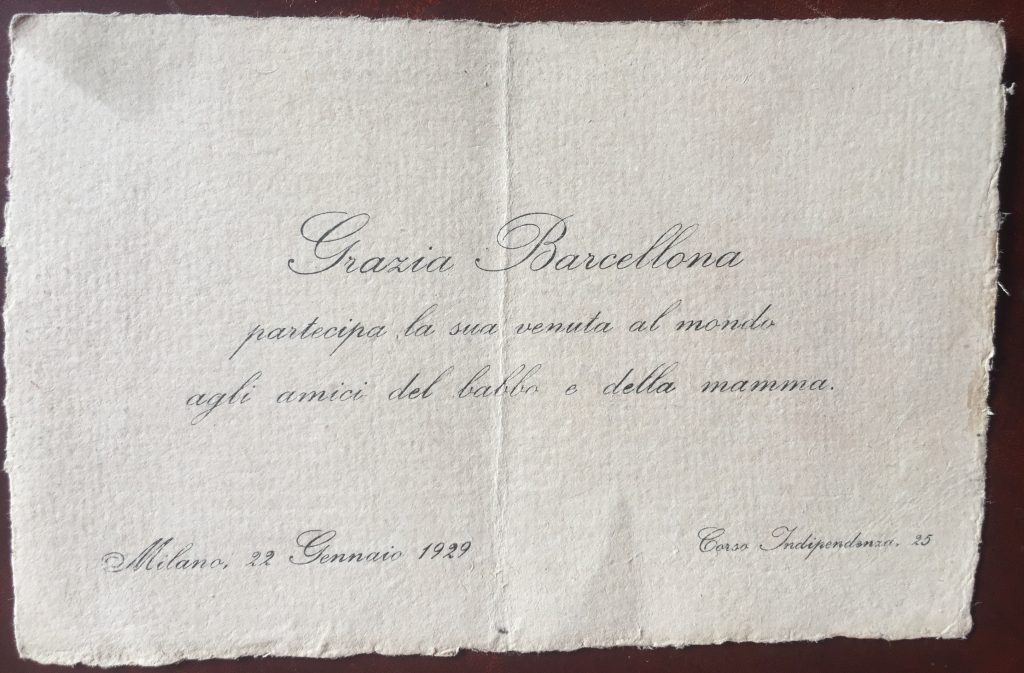
The card containing public announcement of Grazia’s birth, in 1929.
Grazia grew up in a family where sports was a shared passion: her parents were big football fans, and they also took part in skiing and trekking. Most of all, Giuseppe and Giovanna raised both Giacomo and Grazia with the same positive view of sports: this gender-equal treatment was not normally granted in a country where most girls were told that sports were for their brothers, but not for them.
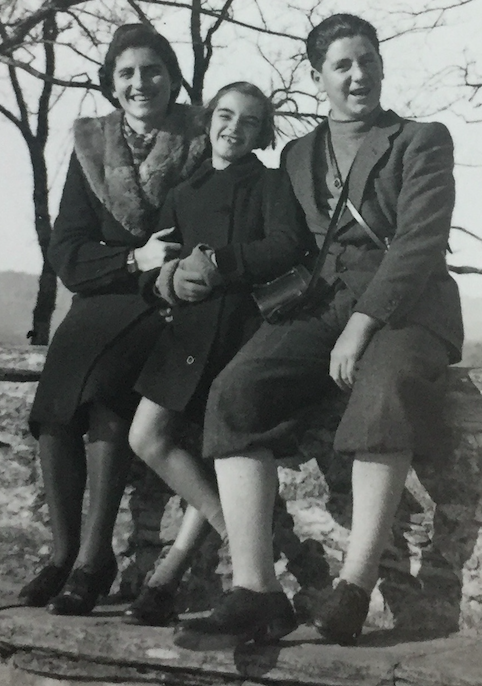
Former women’s football player Rosetta Boccalini (23) with her neice and nephew Grazia (10) and Giacomo “Popi” (13) during holidays in Montallegro, a mountain sanctuary over Chiavari, Liguria, in 1939
In letter from May 1934 Giovanna describes her sister bringing both Giacomo and Grazia to an amateur football match (see http://bit.ly/3a8bNrH )
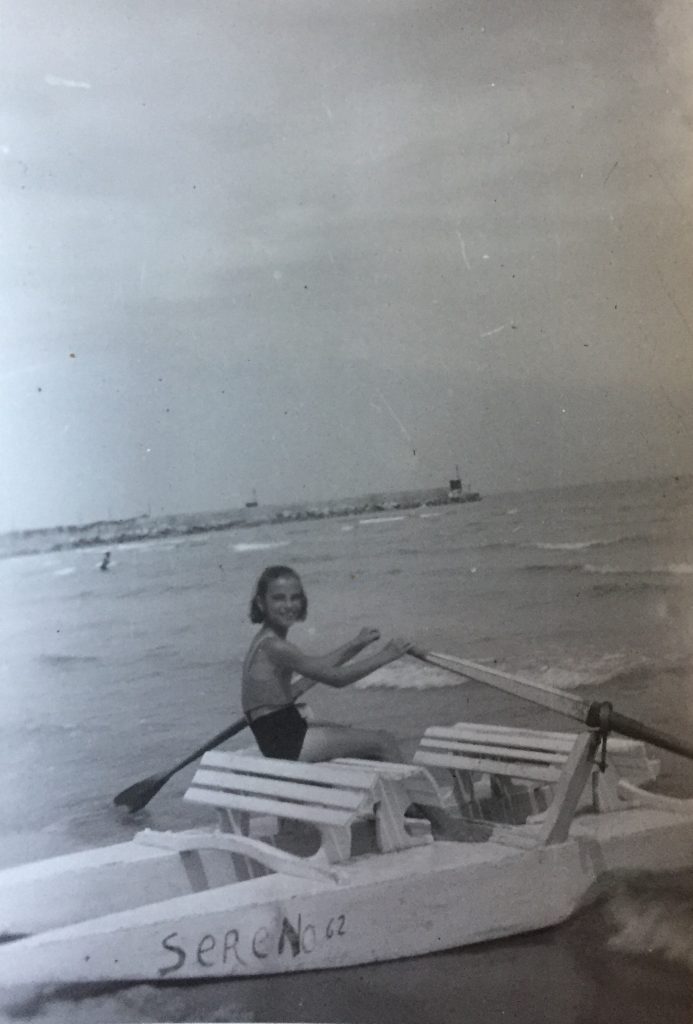
Grazia playing at being a rower, in late Thirties, during the summer holidays in the Romagna Riviera.
As a little girl, Grazia suffered from sinusitis, and was too skinny: she should practice some outdoor sports: Ettore Archinti, the Socialist sculptor friend of Boccalini family (see https://bit.ly/30YWk8i ), suggested that Giovanna should take her daughter ice skating, which he used to practice in Palazzo del Ghiaccio, the Milanese ice rink that was near to Barcellona-Boccalini house … only 10 minutes by foot! Such coincidences matters, in history …
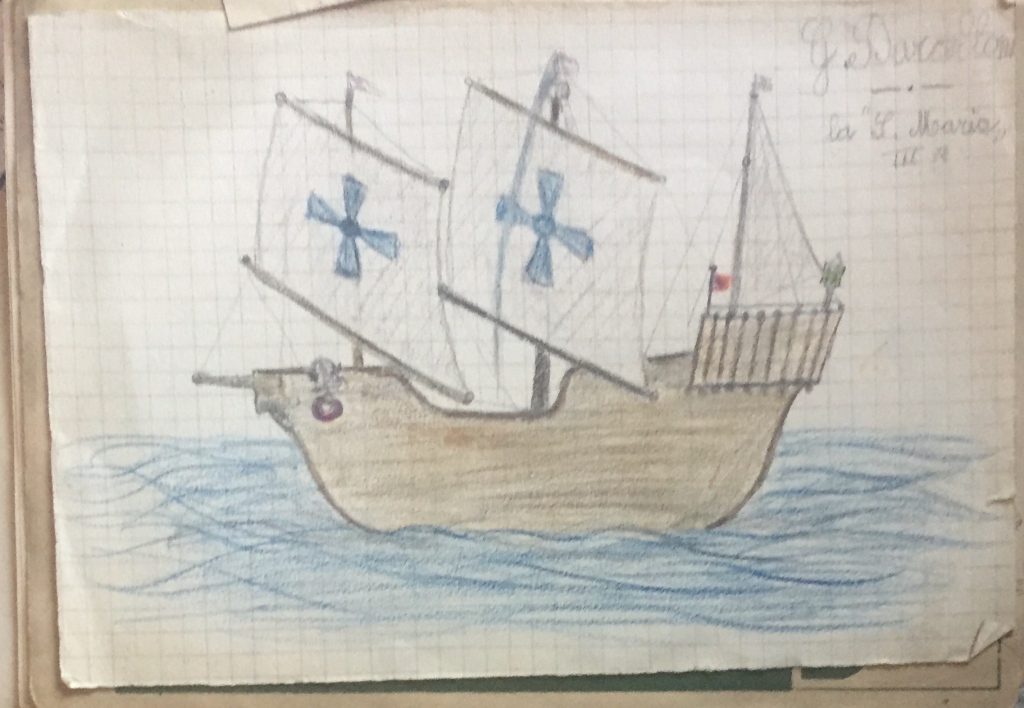
Christopher Columbus’ Santa María ship: a picture drawn by 5-year old Grazia in June 1934.
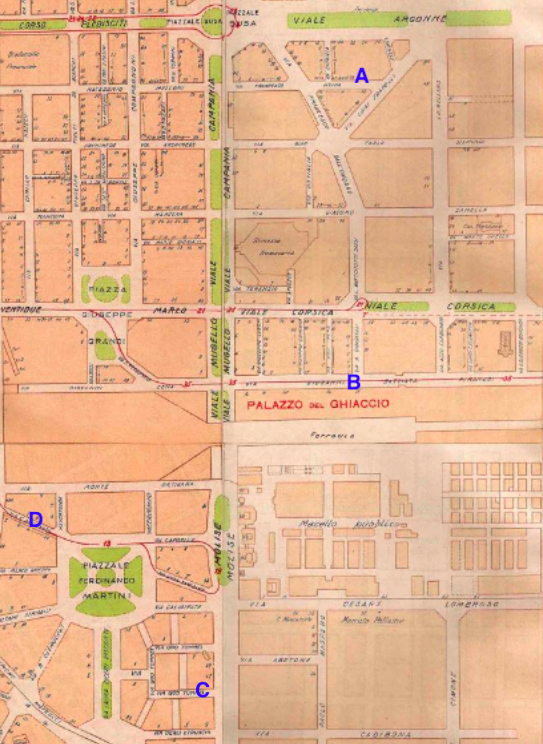
(A) Barcellona-Boccalini’s family house, in Via Francesco Reina
(B) Palazzo del Ghiaccio, in via Piranesi
(C) Rosetta and Marta Boccalini’s house, in Via Ugo Tommei
Some years before, in the same quarter, in via Costanza Arconati (D), Giuseppe Meazza (b. 1910) was raised by his mother, after his father’s death
Also in the area was the football pitch where Costanza, his first team played
With thanks to Alberto Schiavi for this information
Source of the original 1933 map: http://bit.ly/3iiagBm
The first photo of Grazia skating was taken in 1938: in 1939, she started executing her first jumps (see bit.ly/33kXjz4) She didn’t practice alone: firstly, there was her classmate, Franca Re, who would be Grazia’s life-long colleague and personal friend, as remembered by Grazia’s daughter Cristina. This old friendship is demonstrated by … a drawing too: we should remember that they were very little girls when they started to skate!
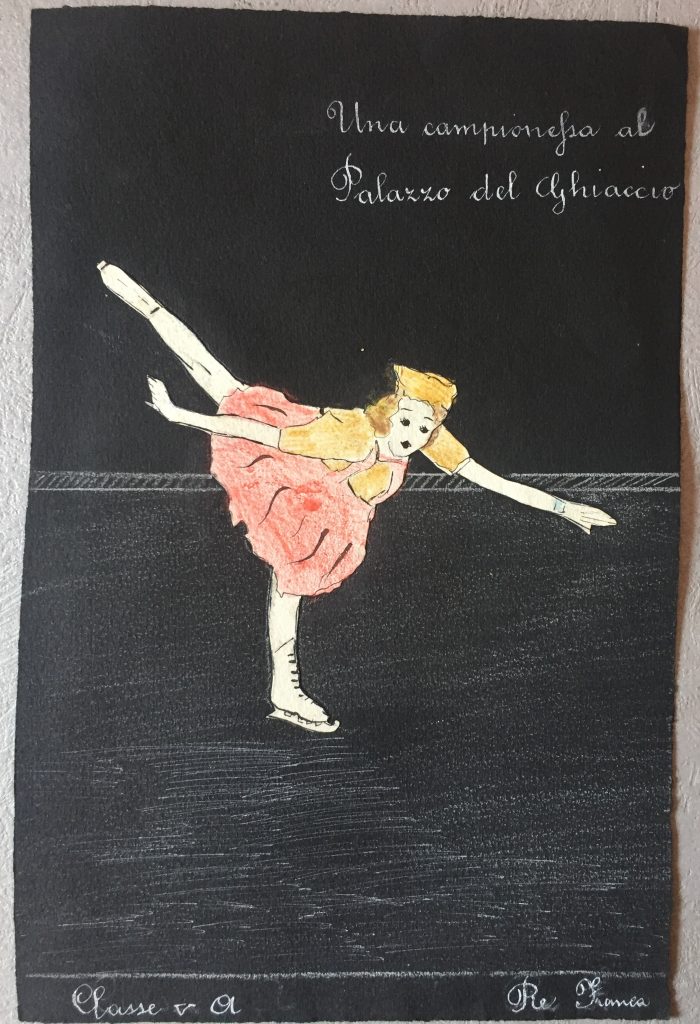
A skater (Grazia, or the painter herself?) at the Palazzo del Ghiaccio, by 10-years old Franca Re (she attended the 5th-grade elementary school, as noted at the bottom)
Franca was born in 1929 as was Grazia and she drew this in 1939.
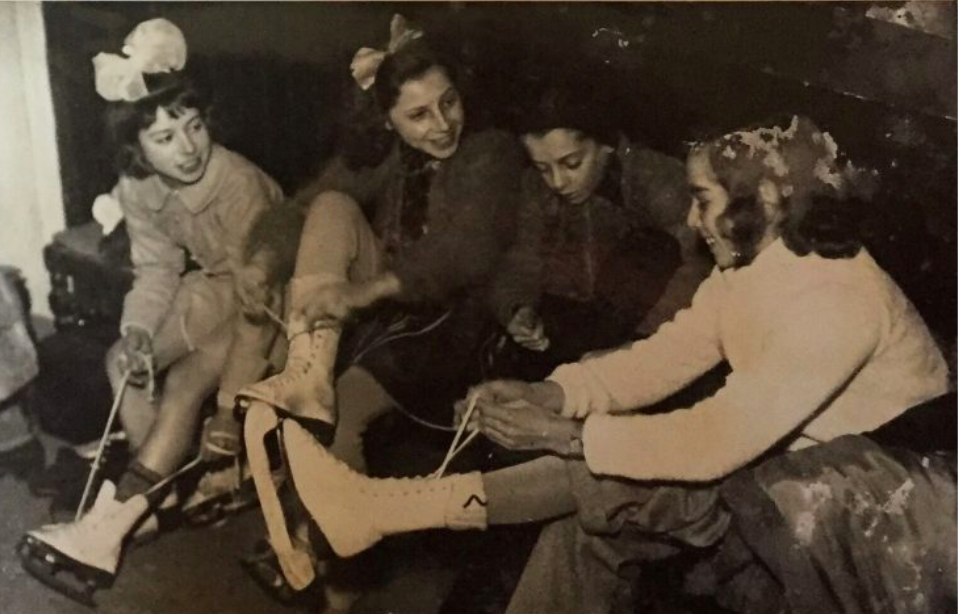
Ice skaters putting on their skates in Turin (1942)
Franca Re is on the left and Grazia the right, they were 13 years-old
Source: Archivio privato Grazia Barcellona.
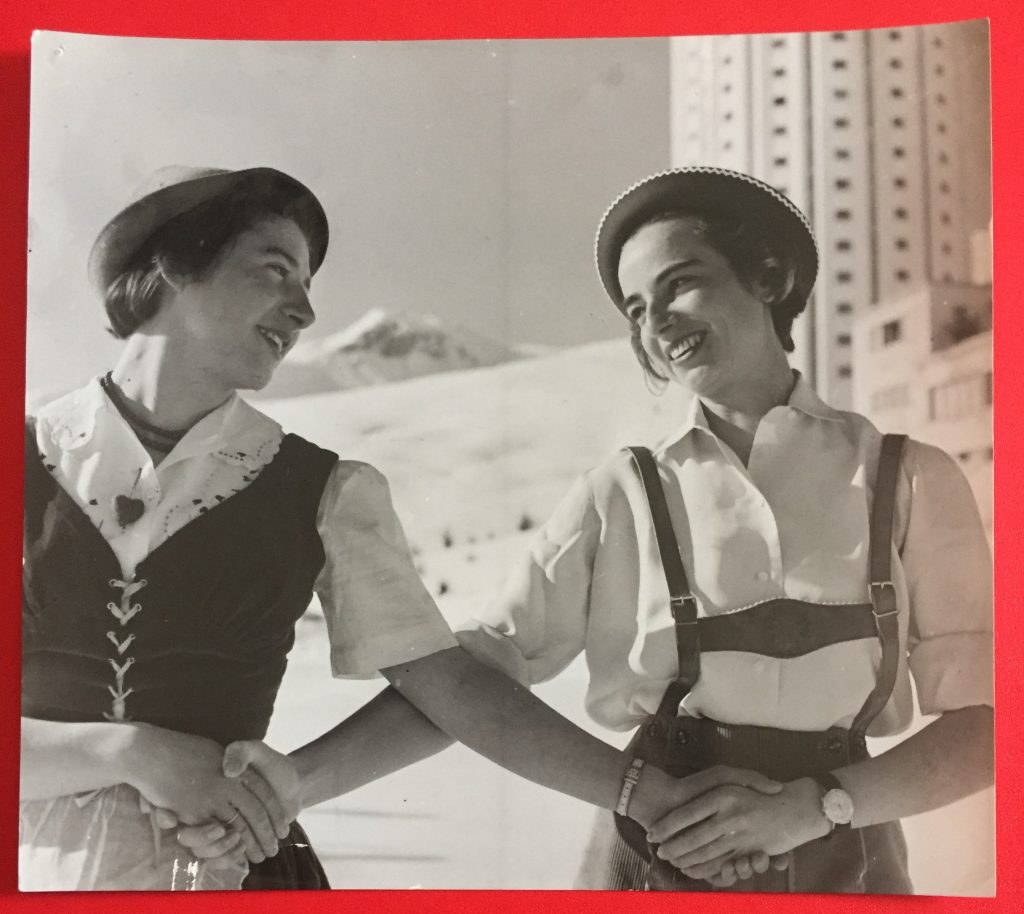
Franca and Grazia skating in Tirolese dress in Sestriere (1951).
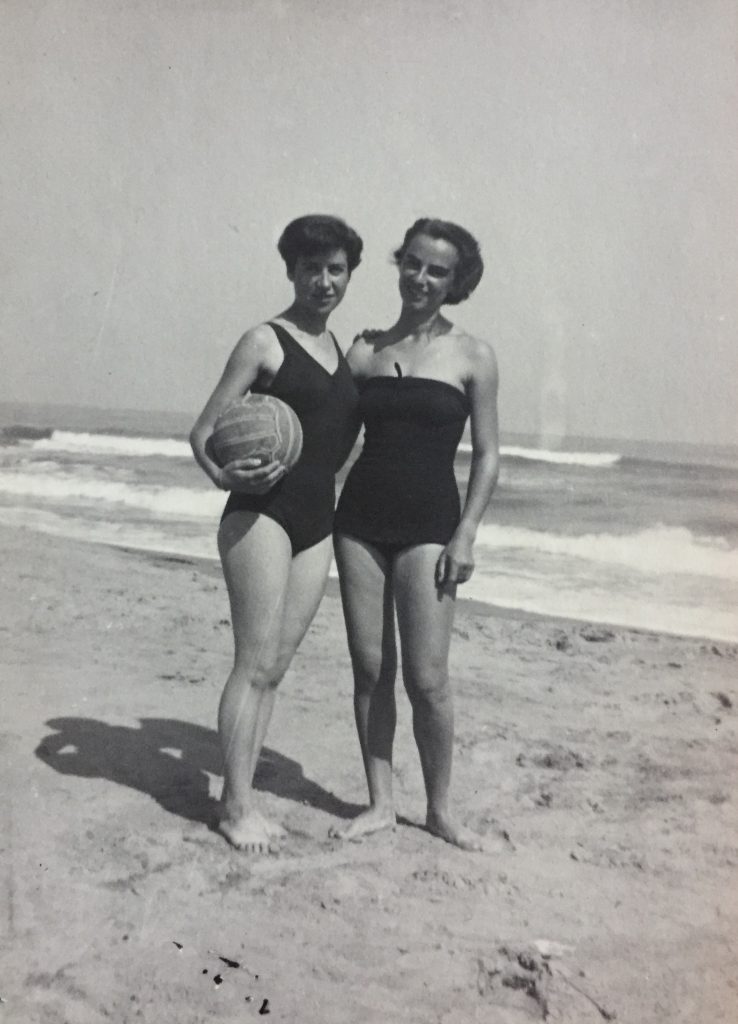
Some years later, Franca and Grazia during their summer holidays.
Two further pictures were drawn by Carlo “Carlino” Fassi, the only-ever partner of Grazia in pair skating: they shared a lot of time during those years, training and competing in skating events: in 1942 they won their first Italian pairs title. A journalist from La Sera newspaper had the chance to watch them training at the Palazzo del Ghiaccio before that event. After praising their skill, the journalist introduced the adults who surrounded Grazia and Carlo: their teacher Harry Burghardt (see bit.ly/325Zh4R ), Mrs. Cattaneo (head of the skating school), Remo Vigorelli (president of Circolo Pattinatori Artistici, their skating club).
-
Two pictures drawn by young Carlo Fassi: his signature “Carlino”, a nickname meaning “little Carlo”
As written in 1953 article published by Il Vittorioso weekly
Carlo started to skate when he was 7 (1935) because his grandfather, head electrician of Palazzo del Ghiaccio, gave him a pair of skates as a birthday present, a second hand pair not used anymore by a rich kid …
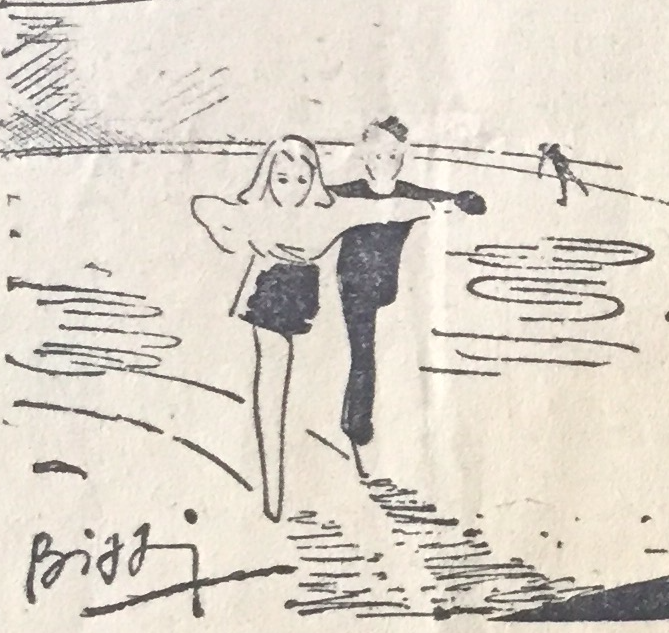
An illustration of Grazia and Carlino skating together, at Milan ice rink
Source: La Sera, 17 gennaio 1942.
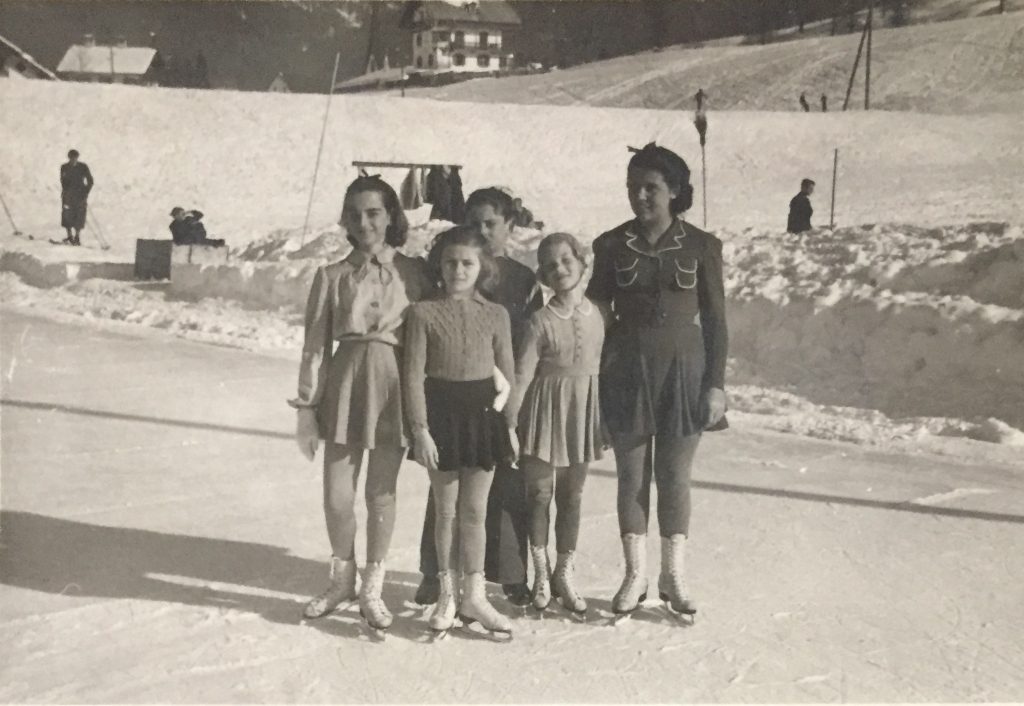
Grazia (1st left), two little girls and Ciacia Vigorelli, and Carlo Fassi on the back row
After Giuseppe’s return from his confinement on the Tremiti Islands in November 1934, he and his wife Giovanna decided to keep a low-profile, in order to survive in Fascist Italy despite their personal Socialist political faith. Since he couldn’t work anymore in his previous role for the Tax Office, Giuseppe had to search for a new job in a private accounting firm; Giovanna was a teacher in a public elementary school. Due to their position, the couple were compelled, socially, to enrol their children in the Opera Nazionale Balilla (ONB), the Fascist Youth Association – then, from 1937, Gioventù Italiana del Littorio (GIL)? No, of course not. It was a very important decision for Grazia’s career: as already explained in Part 2 (see bit.ly/325Zh4R ), being enrolled in GIL was the only way to compete in any sports national championships, in early 1940s’ Italy …
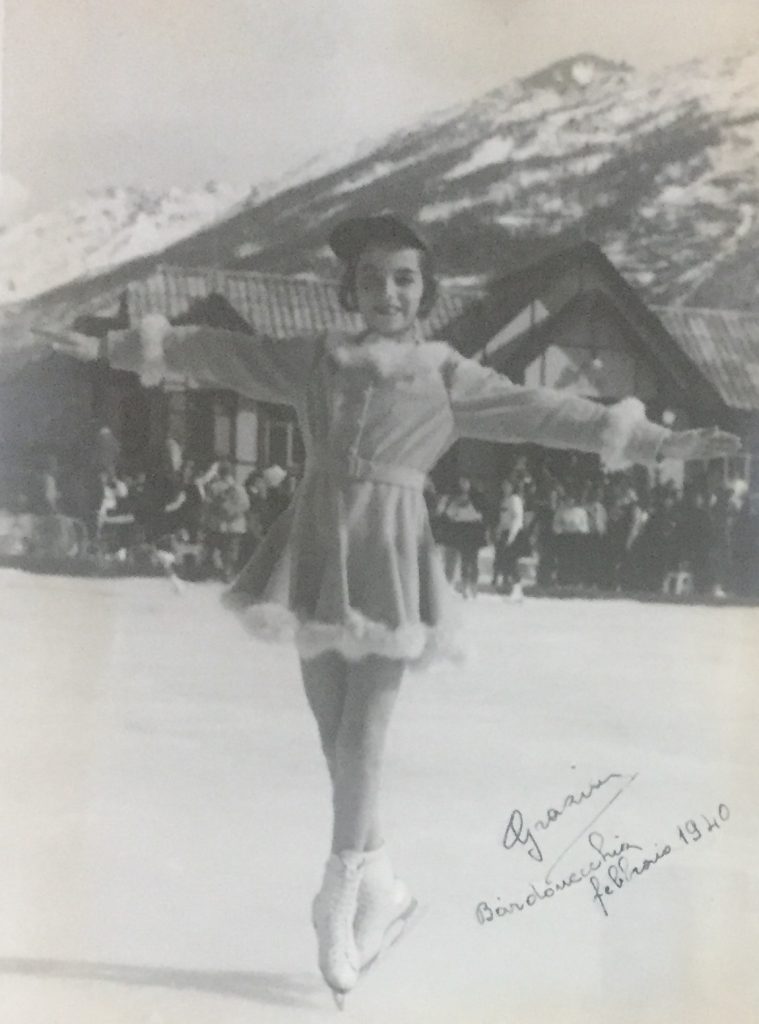
Grazia skating in Bardonecchia (February 1940)
Grazia’s 1st card as Piccola Italiana, the 1st step of female ONB (1935). The card was very useful because it brought many benefits, such as injury insurance (contemporary professional sportswomen are still fighting for it, asking the Italian Parliament to ensure it with a law that is still missing …).
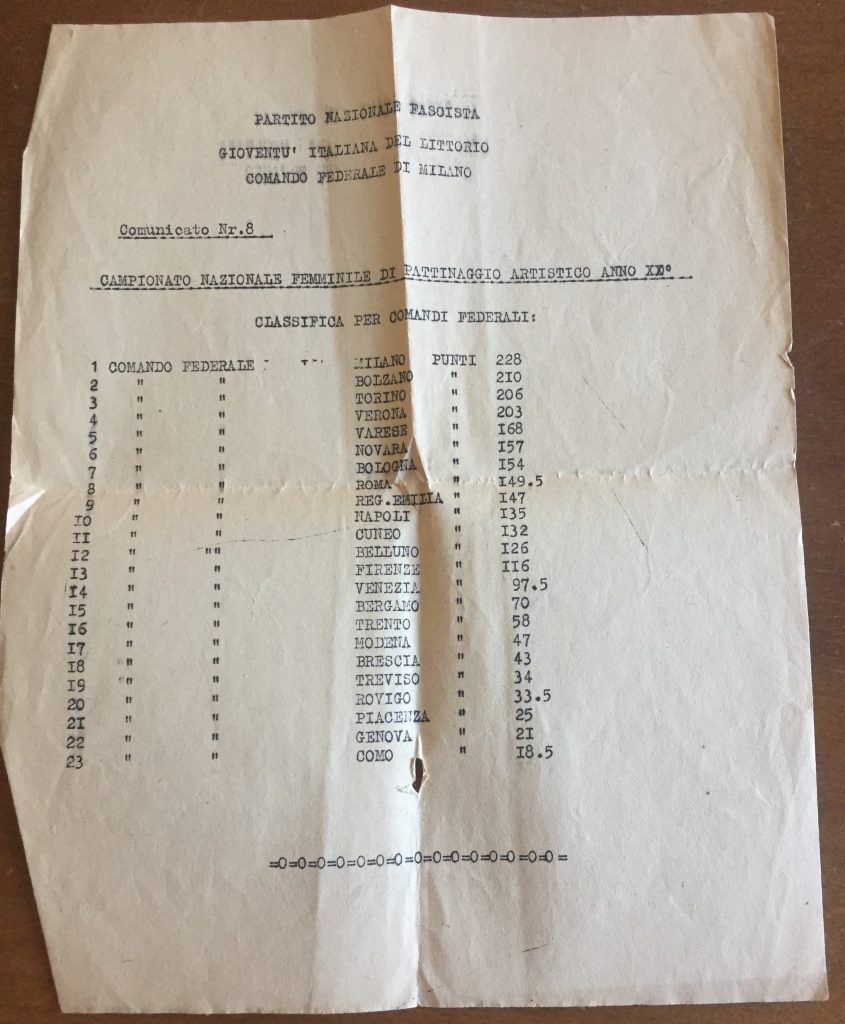
The results of Figure Skating National Women’s Championship, organized by the GIL in March 1942
Since the year (‘XX’) is in Era Fascista ‘Fascist Age’ style (which started from 28 October 1922, the day of Mussolini coup on Rome), it was from 28 October 1941 to 27 October 1942
The Milan team was 1st, with almost 20 points more than the 2nd team (Bozen/Bolzano), and Milanese skaters took the first 4 positions: Fedora Nuremberg (77 points), Carla Fontana (76), Grazia Barcellona (75) and Franca Re (74)
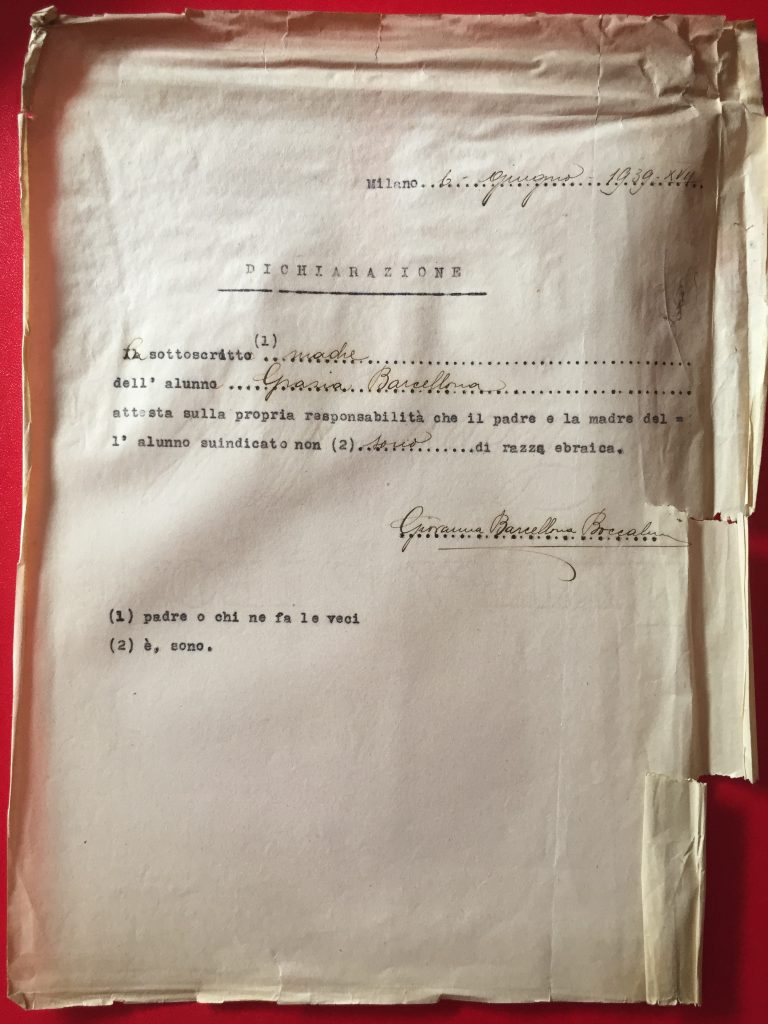
Due to the Italian racial laws, in June 1939 Giovanna had to sign this paper, ensuring that she and her husband Giuseppe, parents of Grazia Barcellona, “are not of the Jewish-race”
What about the war? Grazia and Carlo won their first National title in 1942, the last year when the Axis could believe in a final victory. As already explained in Part 2, they were both sent to Croatia to compete in an event with the Italian National skating team.
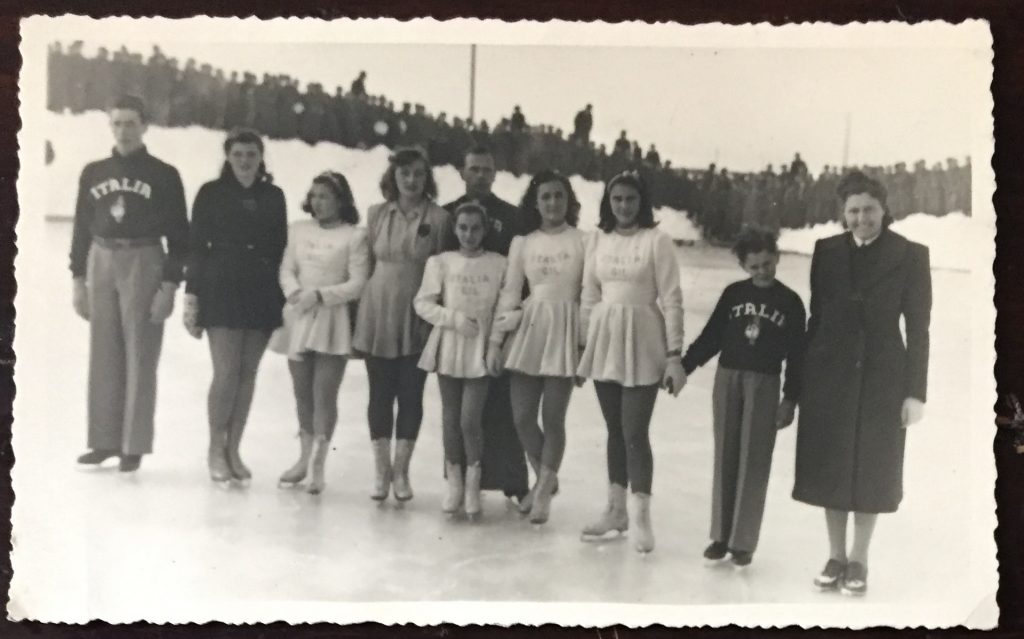
Grazia and Carlo (the shortest ones) with the Italy team in Karlovac, Croatia
After looking at the photos of this trip published in Part 2, the Uppsala Universitet researcher Goran Miljan wrote revealing that it was actually an event between GIL and the Ustasha Youth
One of the men depicted in the photos taken in Zagabria is Ivan Oršanić, Administrative Commander of the Ustasha Youth, together with sport commissioner Zebić.
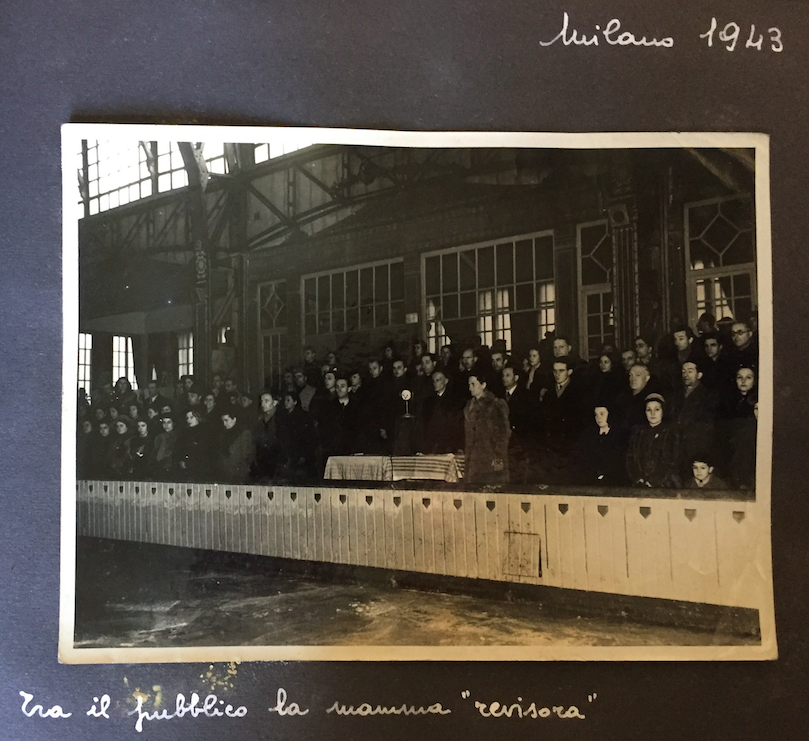
Giovanna watching Grazia skating, at Palazzo del Ghiaccio (1943)
Source: Grazia Barcellona’s Album 1
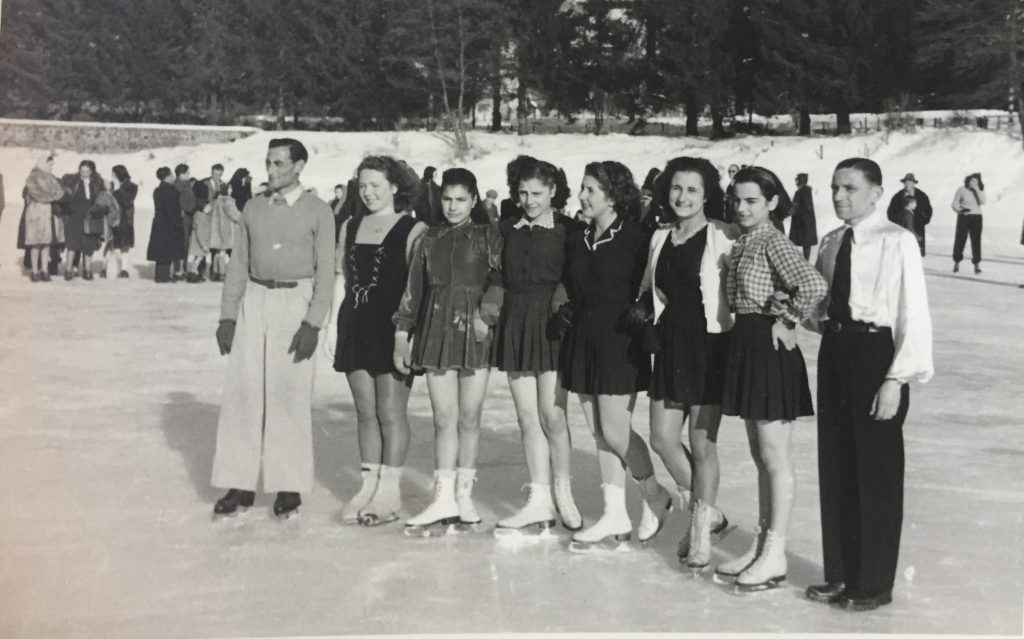
The Milanese skaters. From left: trainer Burghardt (1st); Ciacia Vigorelli (4th); Grazia Barcellona (6th)
Probably the days spent in Seefeld during Winter 1942/1943 where the last happy ones …

Giovanna Boccalini Barcellona (2nd) and Grazia’s trainer Mrs. Frenssen (3rd) in Seefeld
(Winter 1942/1943)
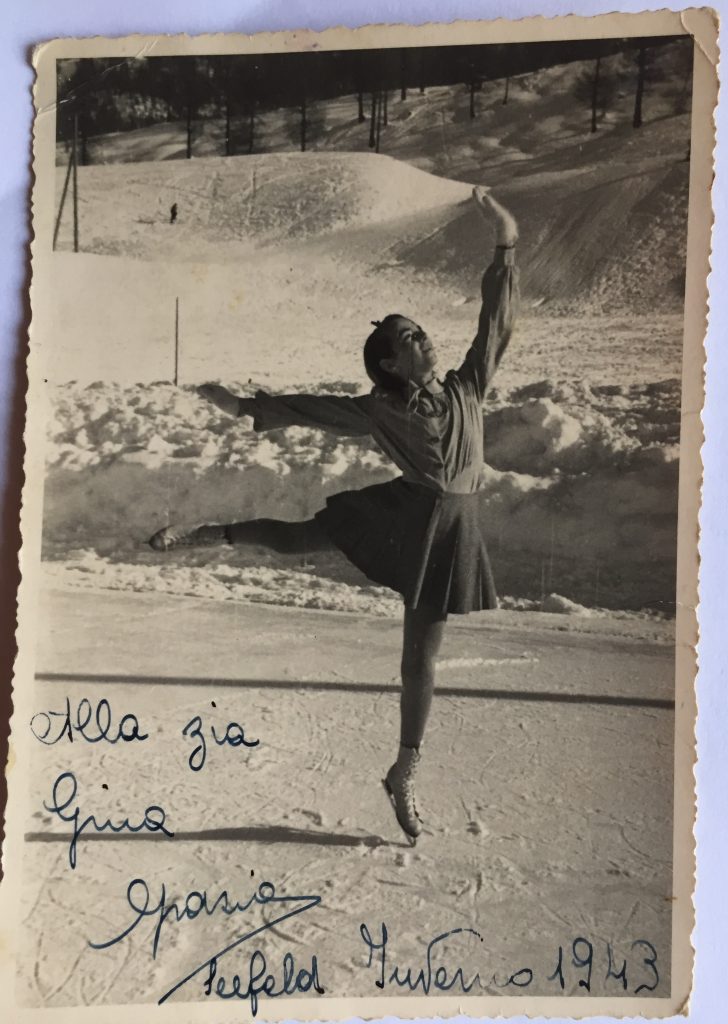
Grazia skating in Seefeld, Winter 1943
Autographed photo to her aunt “Gina”, aka Luisa Bocccalini
On the back, there’s an handwritten sentence: ‘she’s my cousin, Italian ice skating champion, she was 16 years old’
We must assume that it was written by Luisa’s first daughter, Gioia Mottino (see http://bit.ly/3hs9yBl ), in 1945, when she was 8 and Grazia 16
Source: Archivio private Rosa Mottino
For this and the previous image, thanks to Rosa Mottino Femora
Then, during 1943, everything collapsed, and Italy was invaded by the Allies and Nazi forces: Grazia was displaced with her family to the small village of Lacchiarella, in the Milanese countryside. Yet she was still a skater, and she had to train … Since she and Carlo couldn’t use the Palazzo del Ghiaccio, they went to the small frozen lakes to the north of Milan …
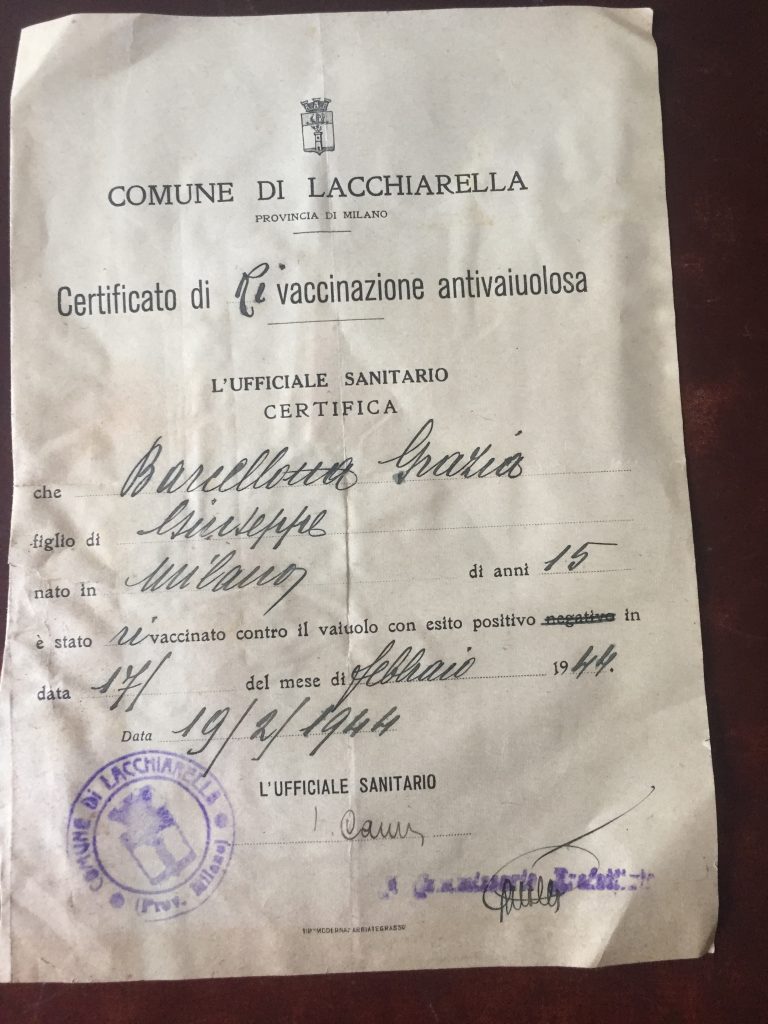
In February 1944, while she displaced in Lacchiarella, 15-years old Grazia had her smallpox vaccination booster
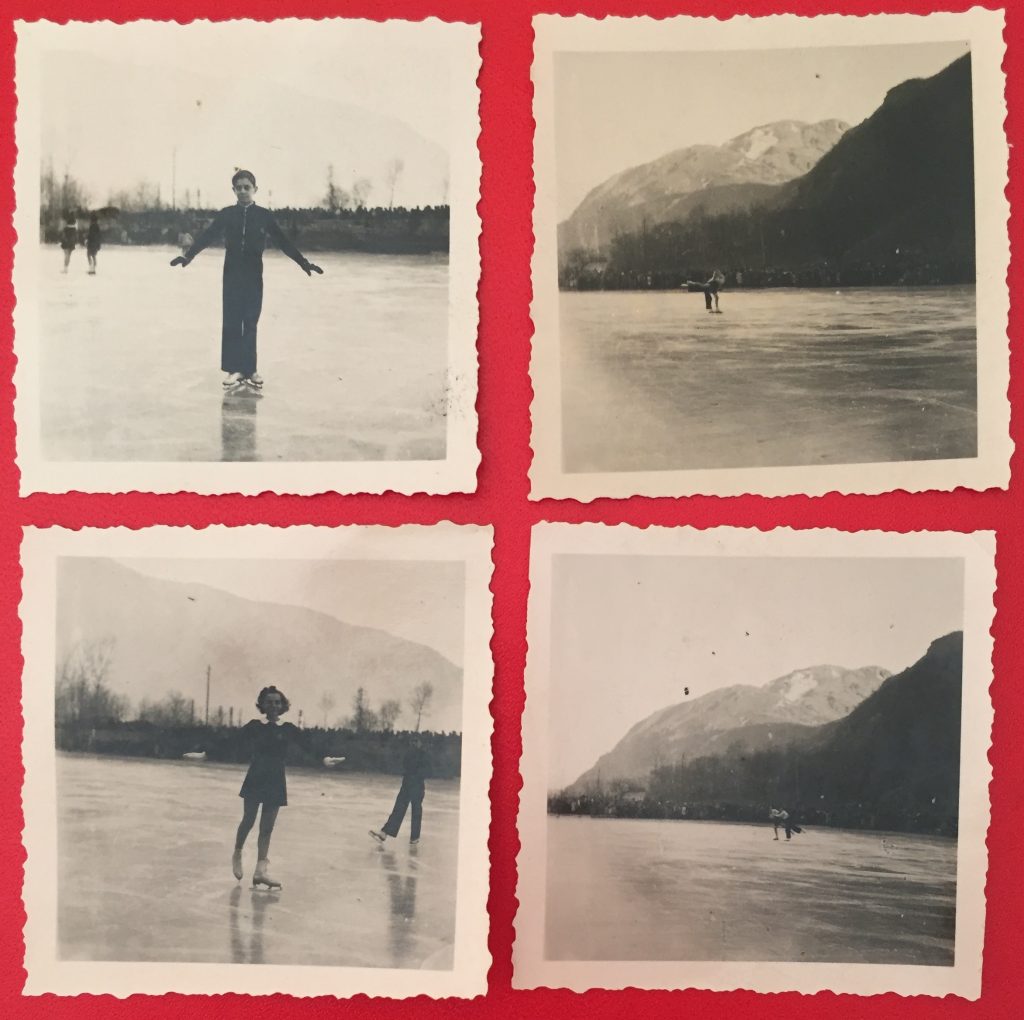
Carlo and Grazia training at Gravellona Toce (1944)
On 26 February 1944 Remo Vigorelli wrote to Grazia from Ivrea, where Vigorelli was probably displaced to, he sent these photos (one of it which has already been published in Part 2), adding that since Grazia has left, his daughter Ciacia had stop skating, because she wasn’t interested in skating all alone …
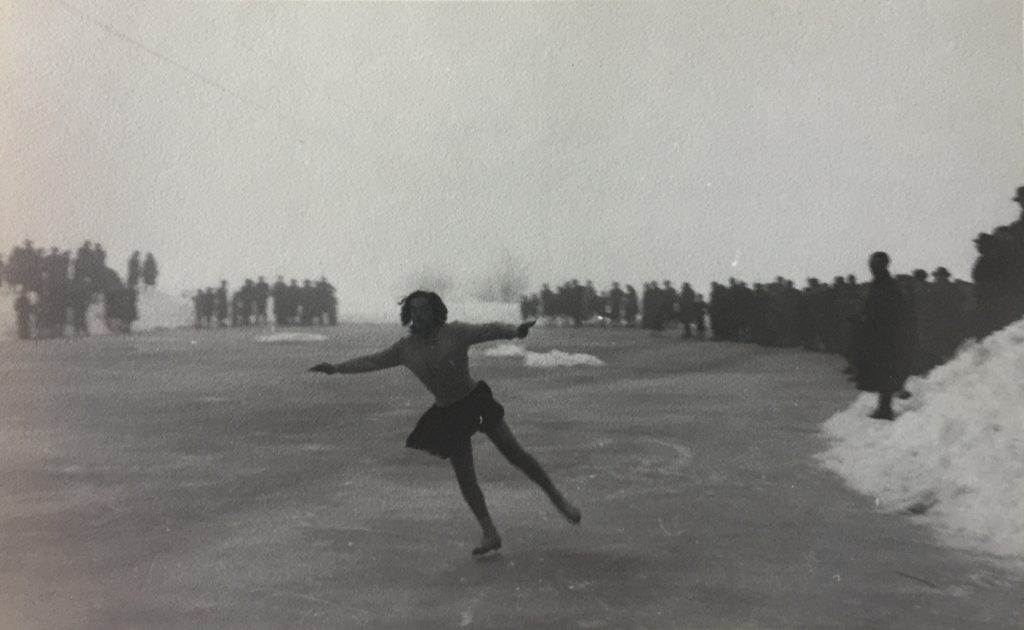
Grazia training in January 1945, in very dark conditions …
On 25 April 1945, Milan was liberated from the Nazi-Fascist forces by local partisans: the war was finally over. Giovanna worked hard as leader of Gruppi di Difesa della Donna (the national inter-parties women’s Resistance group) to help the Milanese people, and as a Partito Comunista Italiano (PCI) member in order to reconnect the Northern Italy Communist Party and the Central-Southern part of it, which stayed divided during the war. During the last months of 1945, the Barcellona-Boccalini family hosted a daily lunch for 18-years old Giuseppe Longo, 2nd son of Communist chief Luigi Longo (who had been secretly looked after by Giovanna during the war, while he was wanted by the Nazis) and Teresa Noce. Raised in France and in the USSR because of the political exile of his parents, Giuseppe didn’t speak Italian: as he told me in an interview in January 2020, spending some time with Giovanna, Giuseppe (who he still remembered as a very funny man) and Grazia (they were both born in 1929) was a good way … to learn Italian!
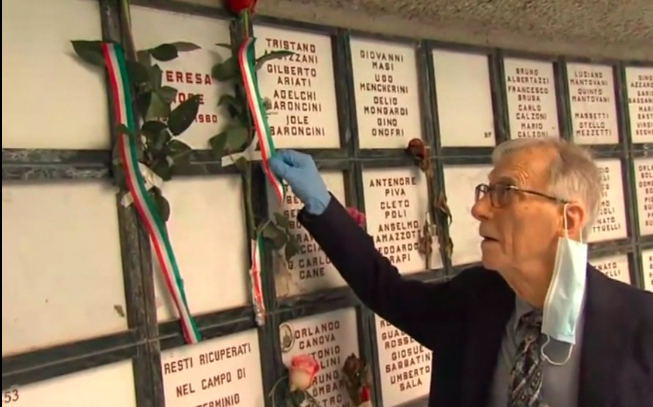
Giuseppe Longo placing a rose on the tomb of his mother Teresa Noce, on 2 June 2020, in Bologna
on the occasion of ‘National Day’, which commemorates the institutional referendum held in 1946, which led to the birth of the Italian Republic
Teresa (1900-1980) was not only Giovanna’s friend but also a very important labour leader and feminist, member of Italian Constituent Assembly of Italy (1946) and PCI deputy from 1948 to 1958
Thanks to her, some laws for protecting working mothers were approved by the Italian parliament
Source: https://www.patriaindipendente.it/idee/cittadinanza-attiva/le-rose-alle-rose/
The return to daily life and to both her studies and sports, was not easy for Grazia, as we gather by reading her 1945/1946 report card. The teachers of the prestigious Liceo Giovanni Berchet (a Milanese public high school attended mostly by upper-class students) didn’t care about the war that had ended some months before: at the end of the scholastic year, they failed Grazia, with seemingly no remorse. In 1949 she enrolled at university, the first in the family to do so and chose to study Foreign Languages. However, since her academic achievement was so poor and, as she raced under the colours of CUS (the university team) in the early Fifties, we can perhaps surmise that Grazia enrolled at university in order to join a better sports club, one which was able to support her. In a similar fashion a lot of other sportsmen (i.e. skier Alberto Tomba) and sportswomen (i.e. skater Carolina Kostner ) did the same towards the end of the century, by enrolling in the Italian Armed Forces in order to take advantage of the superior sports team. Grazia’s university adventure would however end very soon, as the peak of her sporting career approached …
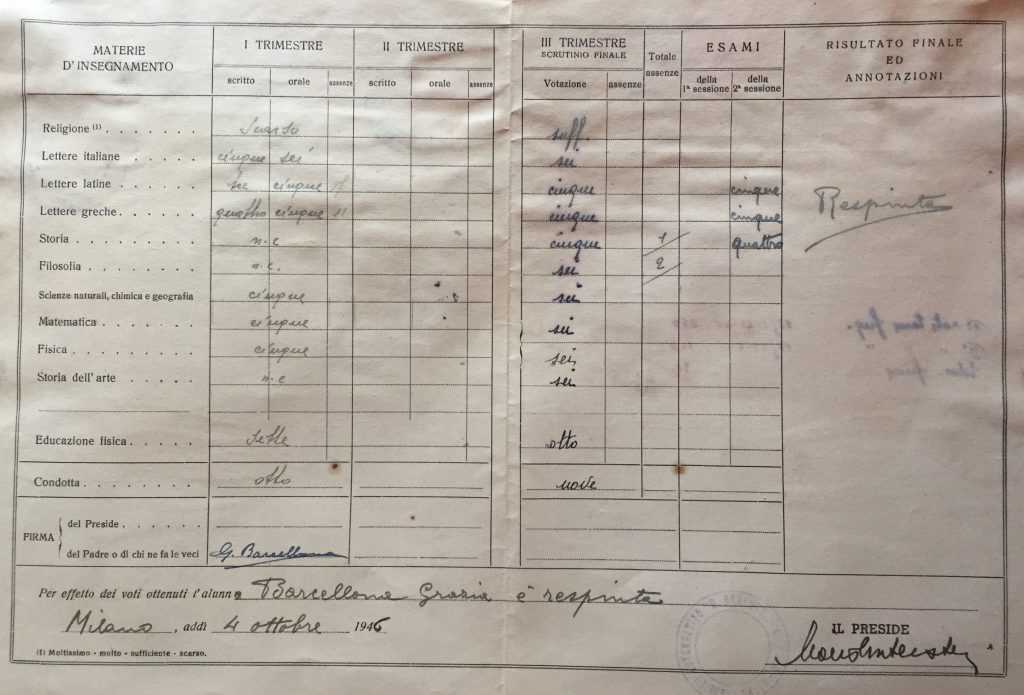
In particular, Grazia failed Latin, Greek and … History (!)
on the other hand, PE was the only subject in which Grazia was able to get a good grade …
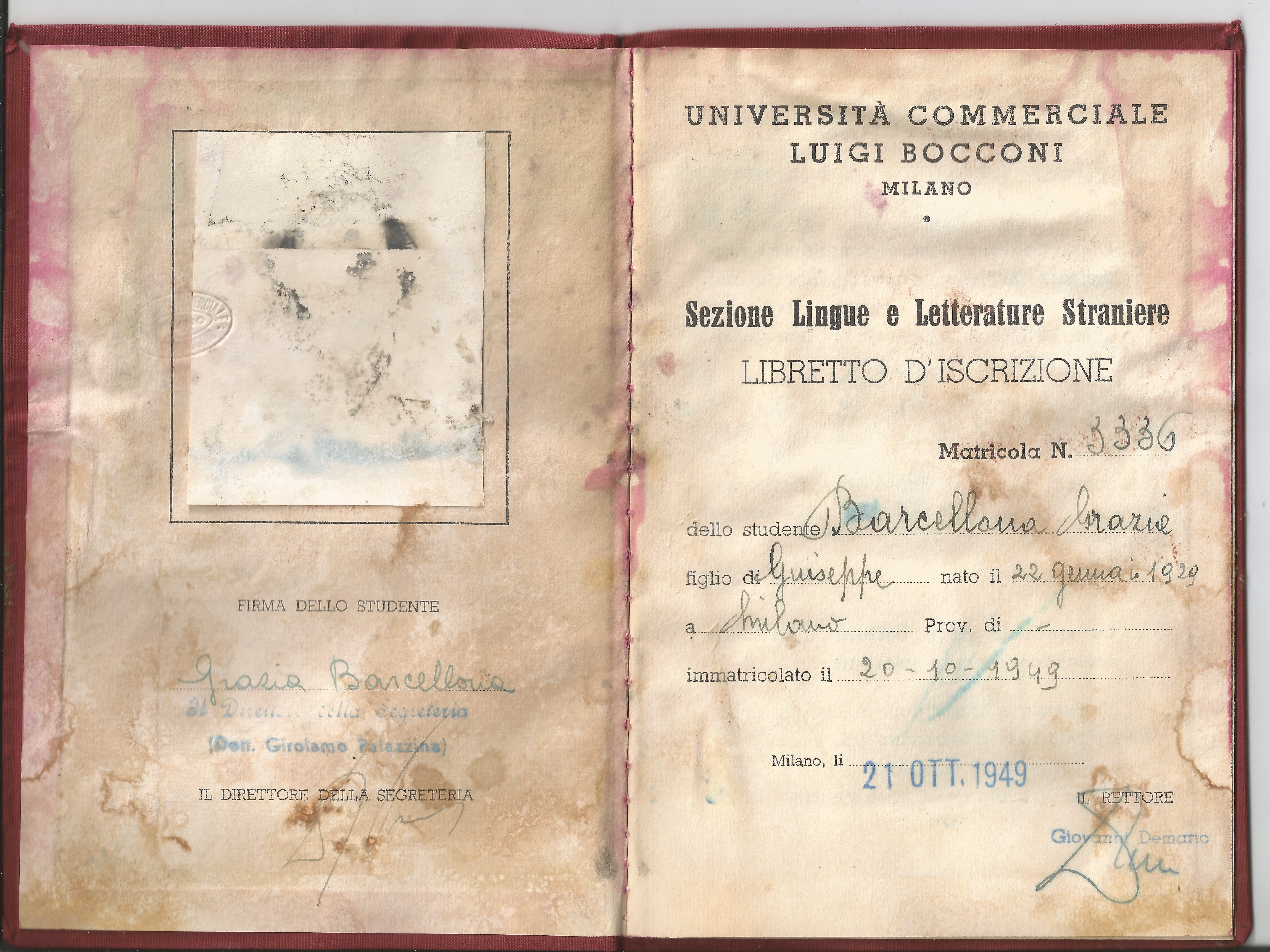
Grazia’s university transcript. She enrolled Bocconi University, a very prestigious private university in Milan.
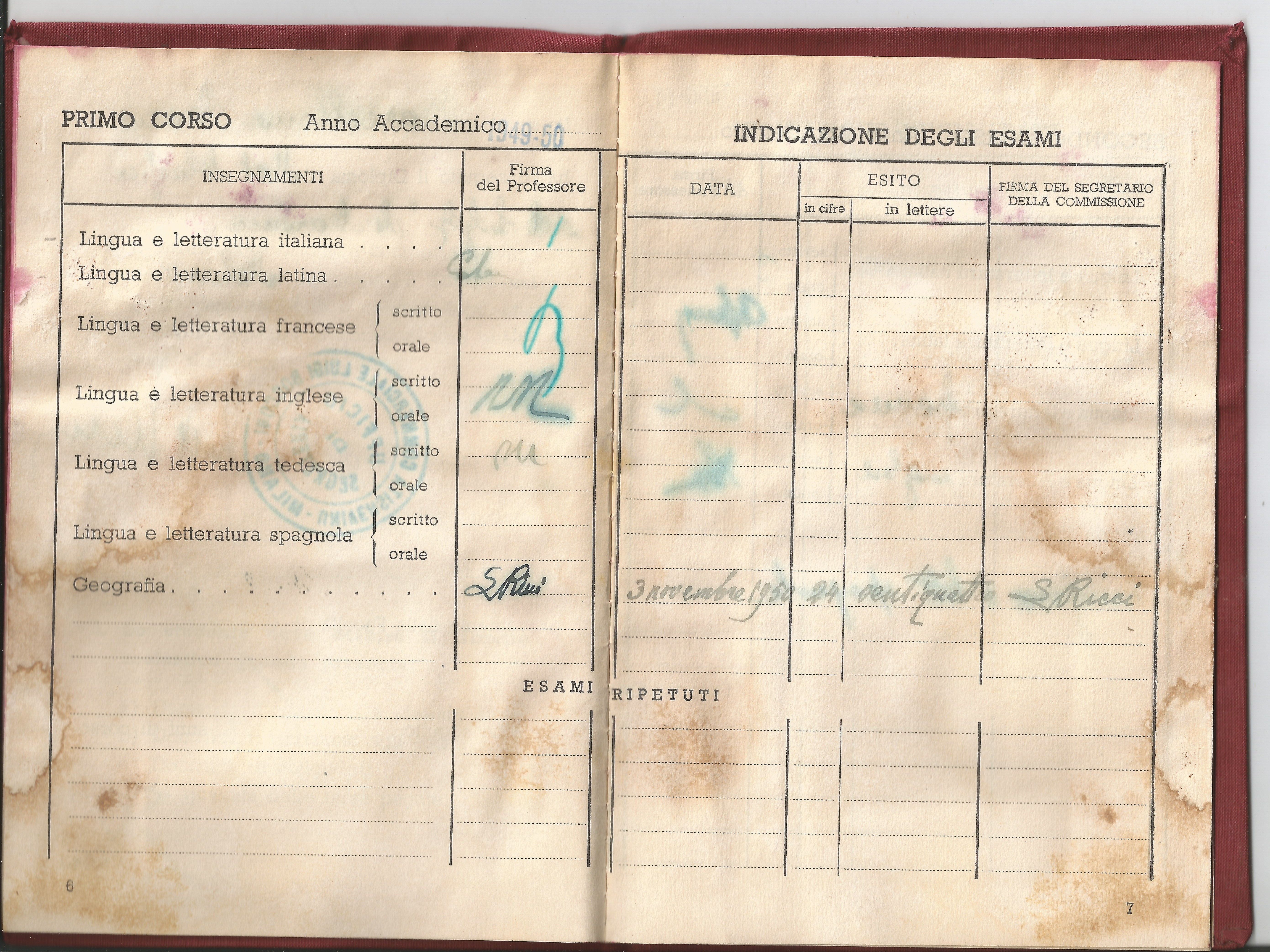
The only exam success of Grazia’s career was Geography: probably, she had learnt it by herself, thanks to her sports trips …
Meanwhile, sport was calling Grazia, with the great adventure of the 1948 Winter Olympics in St. Moritz. As her daughter Cristina told me, those Olympics days were firstly a significant formative experience: despite her disappointing results (see Part 3), the 18-year old girl had the unique opportunity to attend every sports event she wished to, spending a lot of time with her teammates and with many other athletes from all over the world.

Grazia (2nd), Ciacia (3rd) and Carlo (6th) during the opening ceremony

Zooming into this photo of the Italian athletes during the opening ceremony (previously published in Part 3), we can identify not only Grazia (3rd from left) but also two the Italian skiers Renata Carraretto (1st) and the famous Celina Seghi (2nd).
From 7:07 you can see the opening ceremony. Barbara Ann Scott is carrying her skates … the Italian team can be seen from 10:17 to 10:37, yet unluckily the director decided to change the view at the very moment that the line of the 4 Italian girls appeared! From 13:34 to 14:53 there’s’ a good explanation of what figure skating is, and of the role of judge in this sport. Source: https://youtu.be/usoC-trZYTE?t=427
- Grazia’s Olympic ID at the 5th Winter Olympic Games in St. Morit
This rare colour video could bring us back the atmosphere of the figure skating event in St. Moritz. Source: https://youtu.be/46bHRVndot0 .
After the Olympics, Grazia and Carlo came back to Italy, where no one was able to break their domination: they won the Italian pair skating title from 1946 to 1954! In the single’s event, especially after Ciacia’s retirement (1948), Grazia had no real competitor …
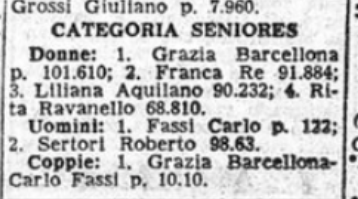
Let’s look at the results of 1949 National championship
held in Merano/Meran
In the women’s figure skating event, Grazia was 1st with 101 points, 10 more than the 2nd (her friend Franca Re), 11 more than the 3rd (Liliana, one of the Aquilano sisters), and 42 more than the 4th ranked skater!
In Part 2 we have already seen an autographed photo to Grazia by a roller skater (Piero Barresi): but there is a further link in the connection between Italian ice and roller skaters … and the link is Harry Burghardt! In the library of the Barcellona-Boccalini family, I found a 1936 copy of the romantic novel “Mi piace questo amore” by Mura, one of the most popular Italian female writers of the Interwar age. We can argue it was owned by (or at least it was read by) Grazia, because inside was a bookmark, in the form of a postcard, written to Grazia and Carlo by Harry Burghardt, who was also the trainer of the Italian national rolling skating team, who were in Sanremo for the European Championships. Among the other firm, we can identify the one by Franca Rio, who some days later would win the title … in 1949 she would become World Champion, in Barcelona!
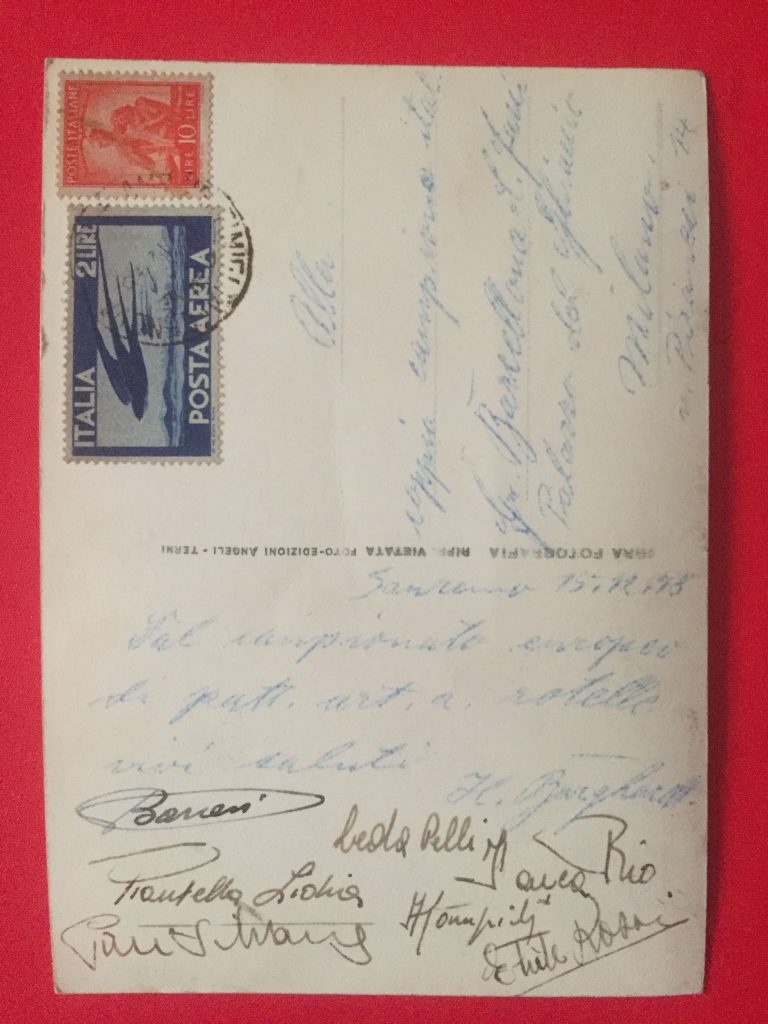
Harry Burghardt’s postcard, written in Sanremo on 15 December 1948
for more details see http://bit.ly/2KqsOmu
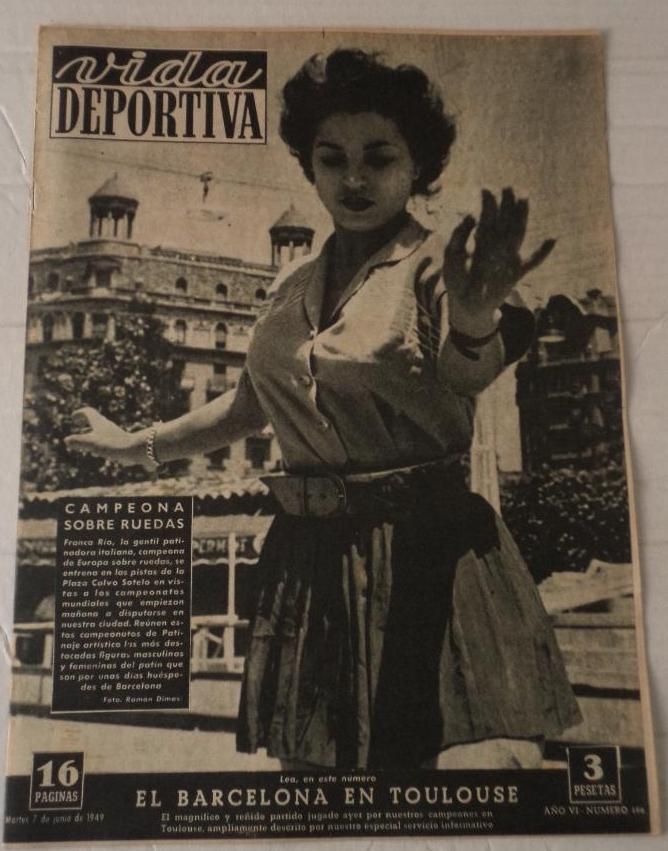
Franca Rio on the cover of a Spanish sport magazine on the occasion of her World Champion title (1949)
Source: http://bit.ly/3o1fVNw .
Grazia’s fame is further witnessed by a peculiar object, a very little 1950 calendar, even smaller than that calendarietto given by Giovanna to Giuseppe in 1933: see http://bit.ly/3a8bNrH . This calendar, published by the Masera distillery, alternates the months and the photos of famous sport champions … and for January and February we find the only two women of the whole calendar …
The 1950 Sports Calendar, by Masera distillery. In the third picture, you can see a gallery of footballers (the first is Valentino Mazzola, captain of FC Torino). In the fourth picture: discus-throwers Alfonso Consolini and Giuseppe Tosi (respectively gold and silver medal at 1948 London Olympics); Marcello and Rolando Del Bello, two brothers who played tennis.
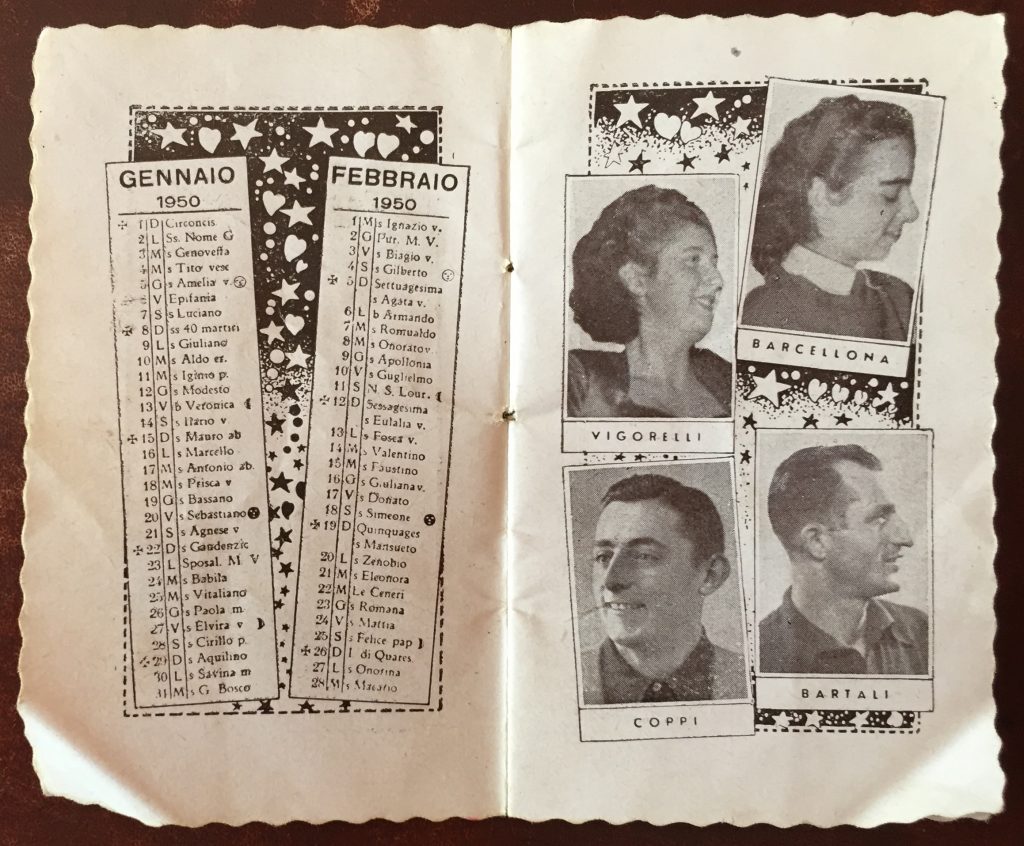
January and February
Ciacia Vigorelli and Grazia Barcellona on the same page of cyclist Fausto Bartali and Gino Bartali
the two most important and famous Italian sportsmen of their age
One year later, even Noi Donne, the magazine of Unione Donne Italiane (UDI), the most important women’s association (her mother Giovanna was among its leaders), devoted a cover to Grazia!

Noi Donne magazine cover, 11 February 1951
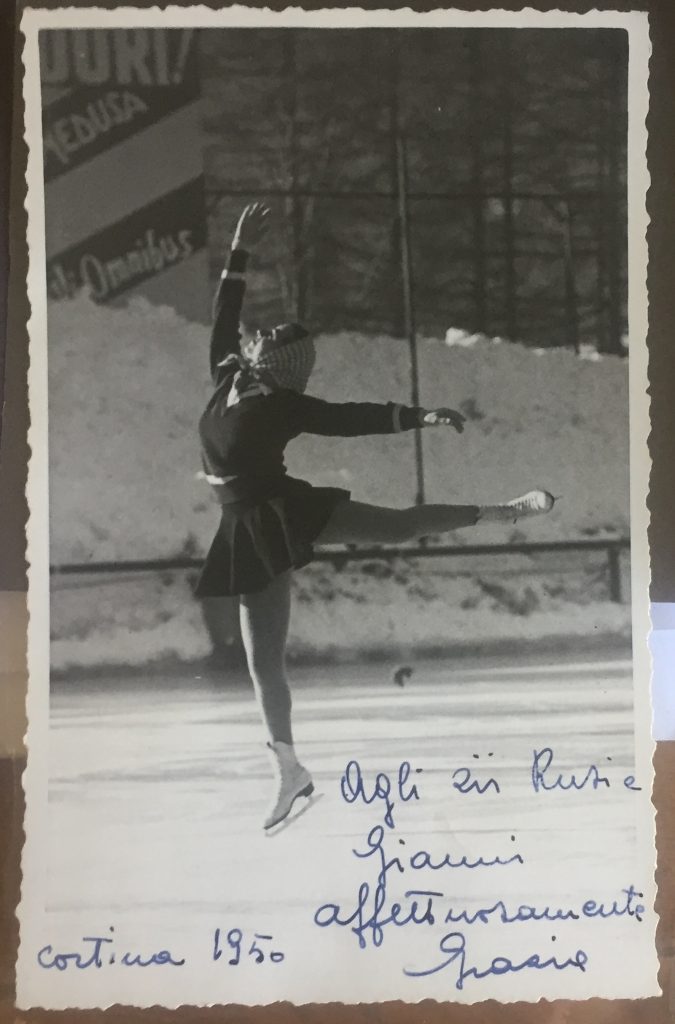
Another copy of the same photo (taken in Cortina, 1950)
autographed to Rosetta and Giovanni Gilardi, Grazia’s ‘beloved aunt and uncle’
Also those beautiful photos taken at Sestriere, depicting Grazia skating with her life-long friend Franca Re, date back to 1951 …
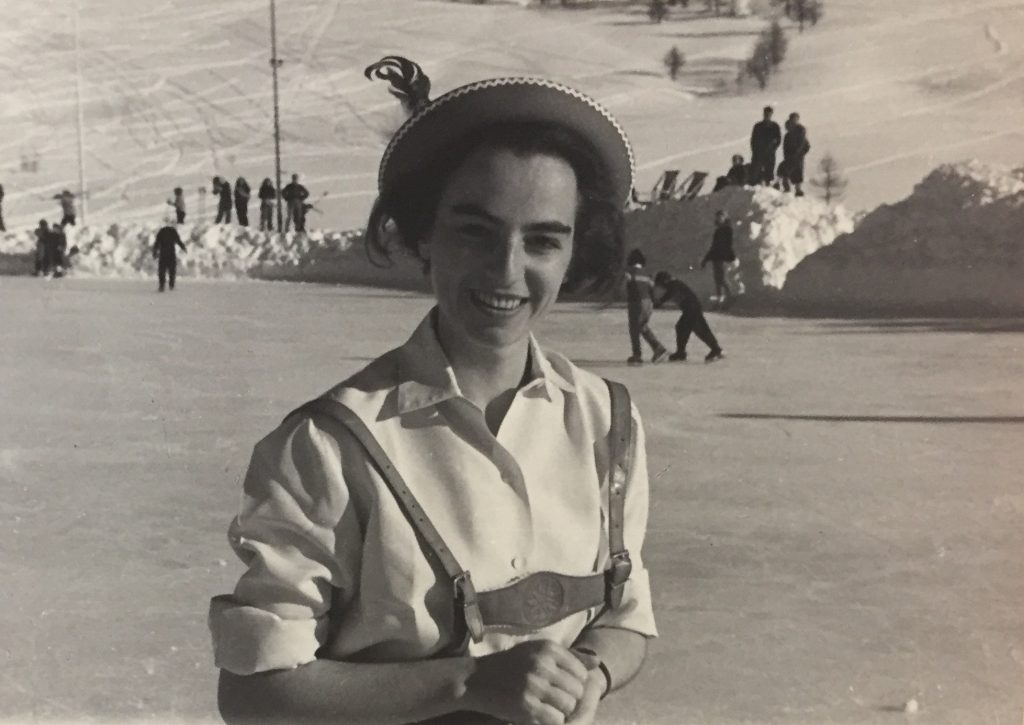
Those were year full of victories …
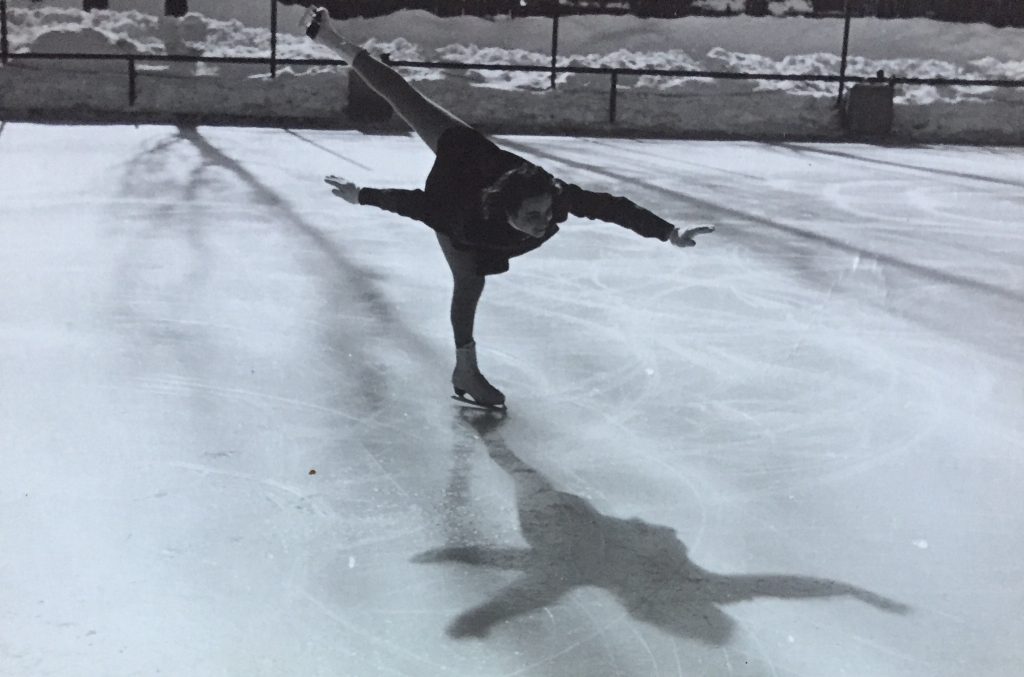
… of friends with whom to share all those sporting events …
… yet a big delusion was to come. Despite her national success, the Italian Federation (ruled by Remo Vigorelli) decided that she not enough good to compete with her international colleagues: Grazia wasn’t chosen to go to Oslo for the 1952 Winter Olympics …
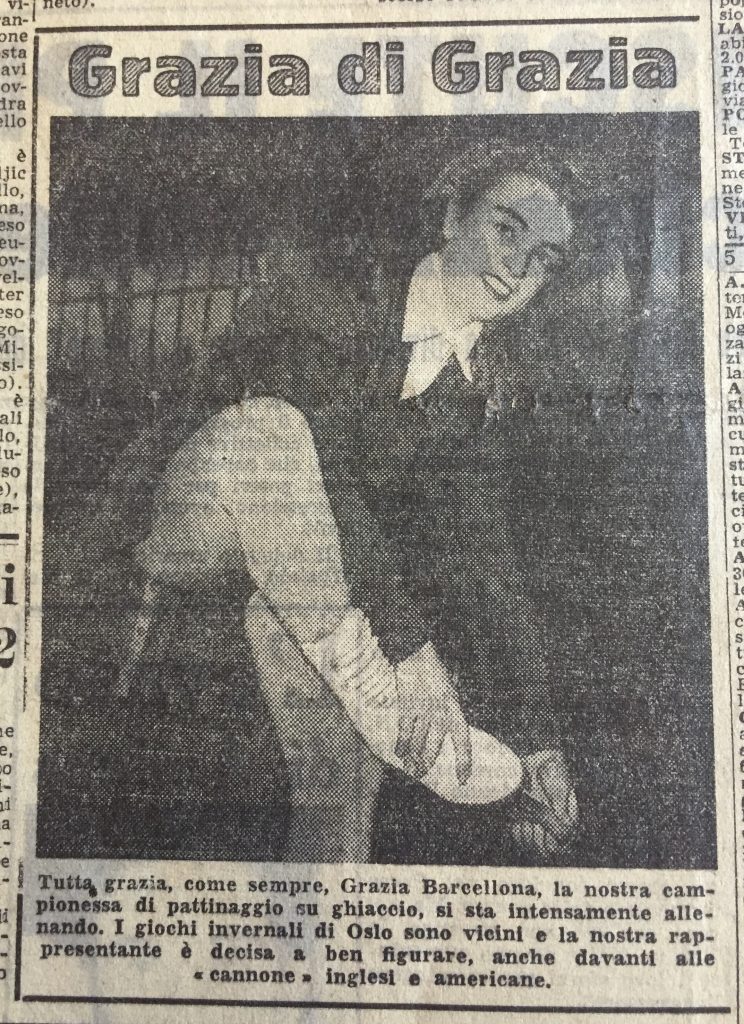
At the very beginning of January 1952, the Italian press was sure that Grazia was going to represent her country at the upcoming Oslo Olympics
Source: Corriere Lombardo, 2 January 1952
Then, Grazia started to need some rest … In 1954 she won her last pairs title with Carlino, whose best results were during the days of the mid-1950s, but in men singles figure skating, without her …
Grazia during her summer holidays with Franca Re, on a beach
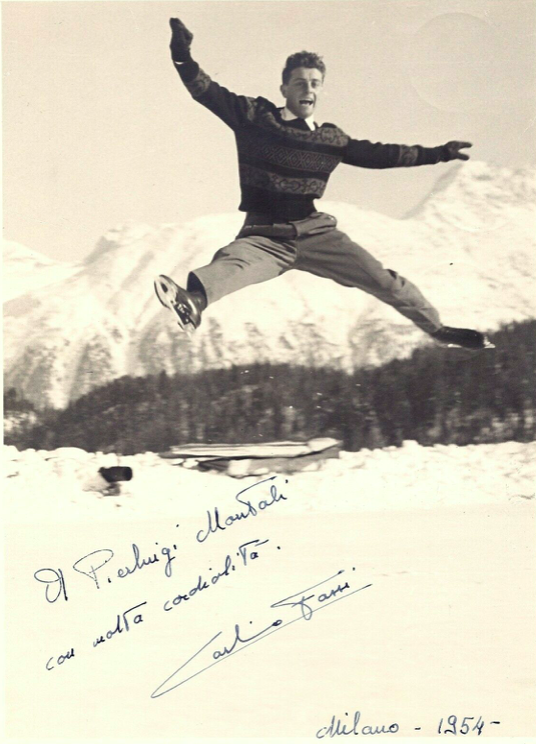
Carlo Fassi skating (1954)<br>Source: http://bit.ly/2LQU3ah
In 1960 Grazia married Tullio Ferrari, and in 1962 their first daughter Cristina was born … Quite surprisingly, Grazia never taught her, or Luigi (b. 1966) or Francesco (b. 1967) to skate: they still all remember the only time when, during a school skiing week, their mother announced that she was going to give a small performance for all the children and their parents. Cristina was among those who thought that she was going to fall down … She was wrong, of course!
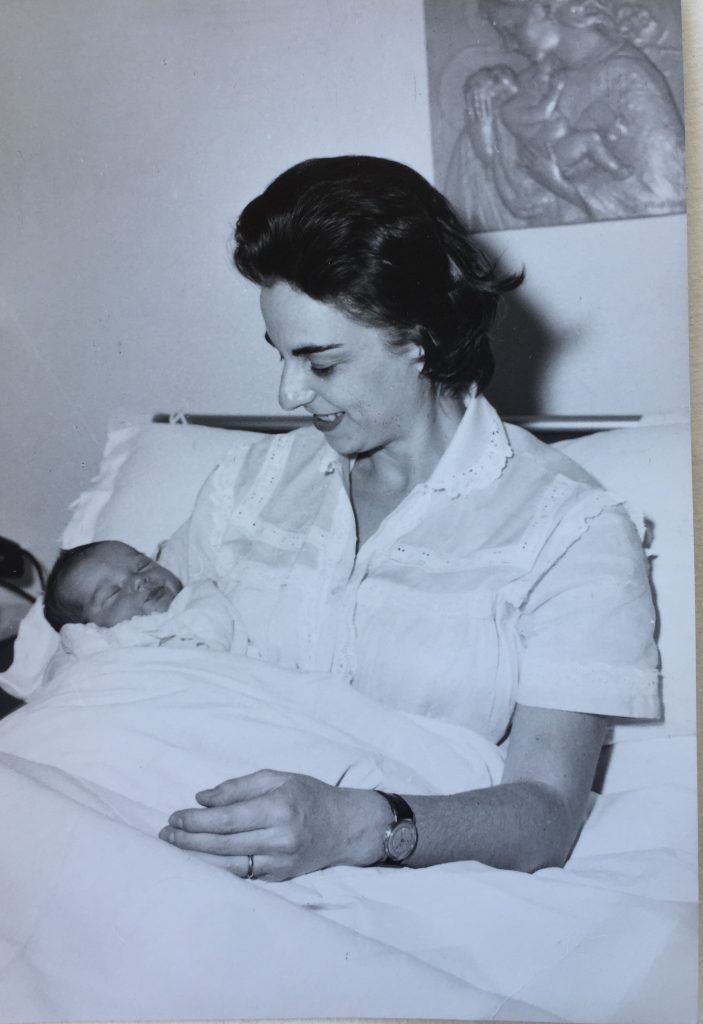
Grazia and Cristina (1962)
Source: Archivio privato Marta Boccalini (thanks to Paolo Gilardi)
A card by the Italian Ice Sports Federation to Grazia, on the occasion of the birth of her first child (1962).
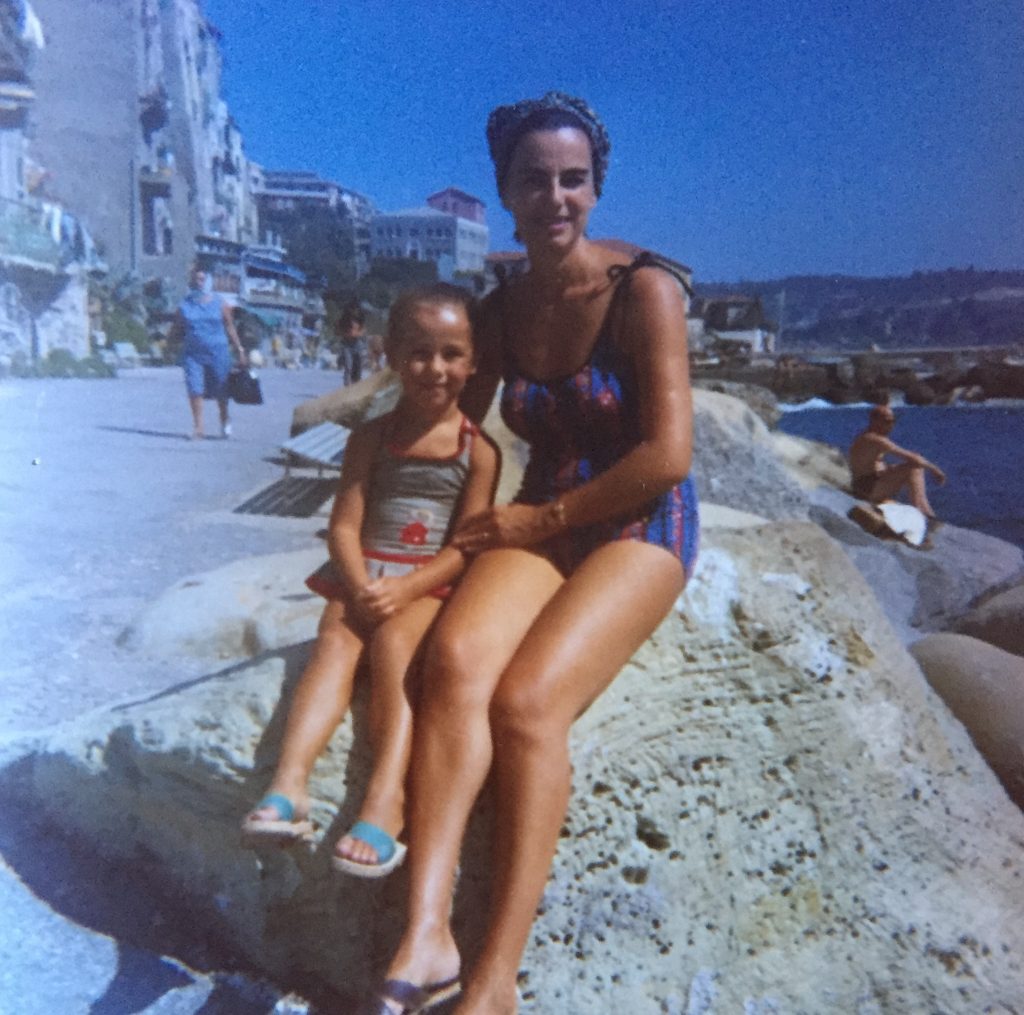
Cristina and Grazia in Portovenere, Liguria
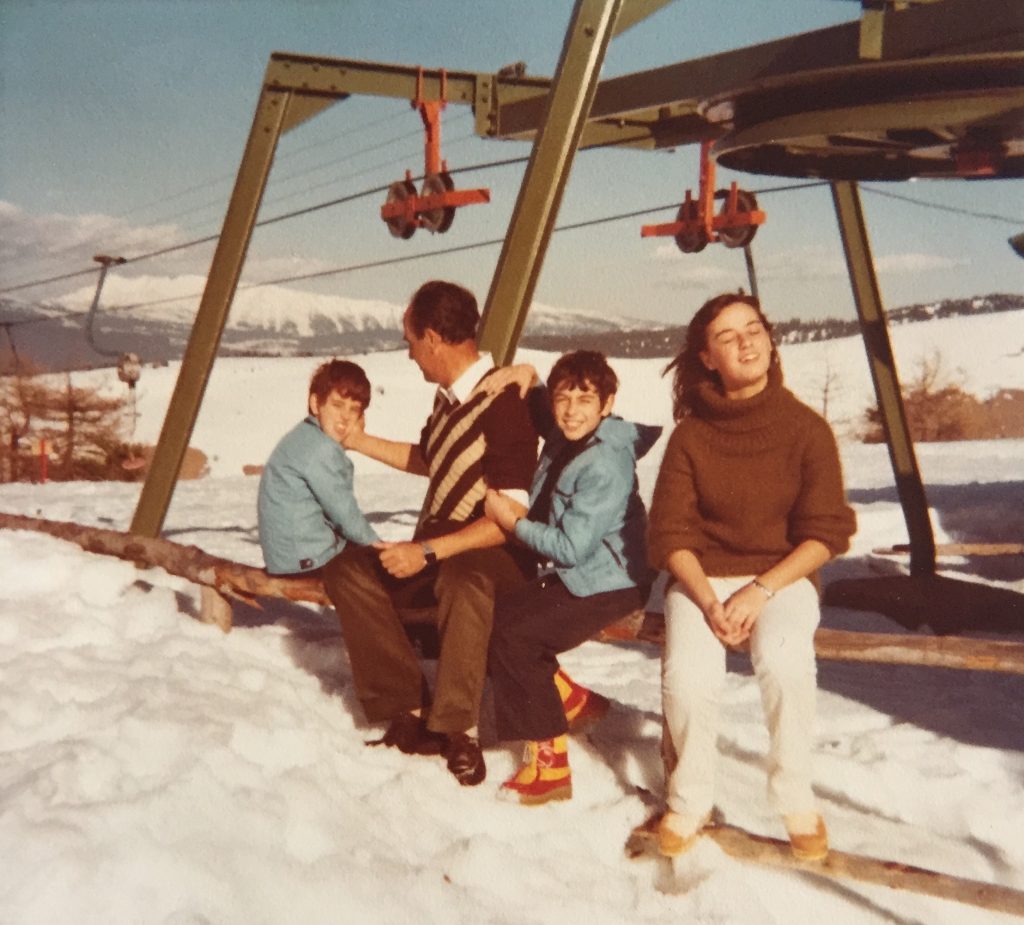
Luigi, Tullio, Francesco and Cristina Ferrari, all together on the snow (early Seventies)
As a little girl, Cristina practiced figure skating: probably a very old Mr. Burghardt was among her teachers! Following her training sessions with all the other girls she could stay and watch the male hockey teams training, she started to have a strange dream: to practice it! Such an heir of Boccalini’s tradition: playing as a girl, a boys’ game! Even in late Sixties, she could not find any support within the local sports club, so she had to give up, retreating to the more female disciplines such as artistic gymnastic, judo, ski and tennis …
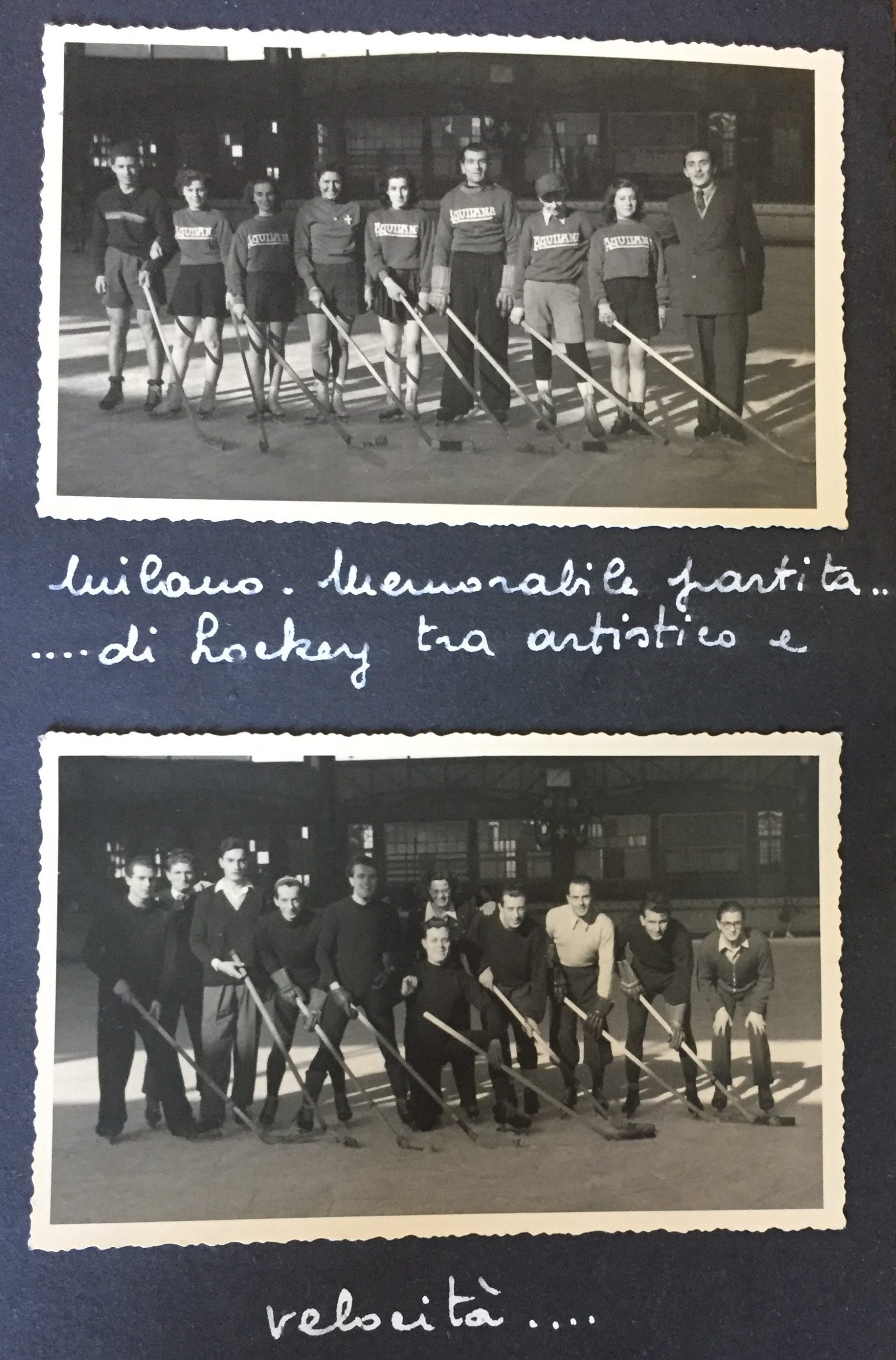
Just for one day, in 1946, Grazia was able to play ice hockey
She and her figure skating teammates (both male and female) played against an all-male speed skating team at the Palazzo del Ghiaccio, just for fun …
Meanwhile, Grazia hadn’t completely given up skating: she began her career as a judge! As her reputation grew, she became an international judge, travelling extensively, although there were some problems when travelling to the United States, as the daughter of a PCI leader such as Giovanna. Silvia Bonitta (daughter of her cousin Gioia Mottino) told me that Grazia had to change her surname on her Italian passport, in order not to have difficulties with the US border police …
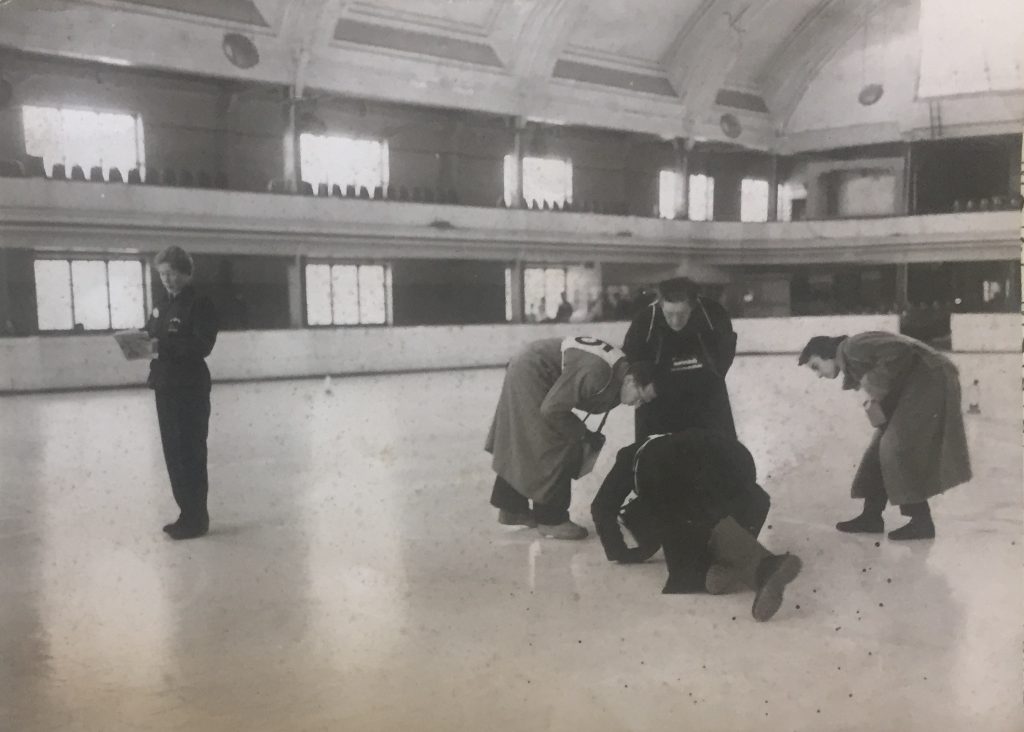
Grazia the judge (1st from the right), observing the marks left by skates on ice …
Giovanna’s archive holds a very rare historical source: Grazia’s judging files from 1965 European Figure Skating Championship, held in Moscow in February.
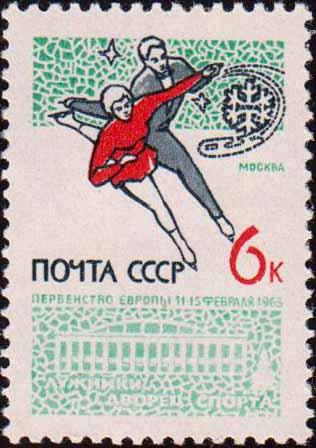
A URSS stamp of 1965 European Championship
Source: https://en.wikipedia.org/wiki/1965_European_Figure_Skating_Championships
A custom declaration signed by Grazia, in the occasion of her arrival in the USSR
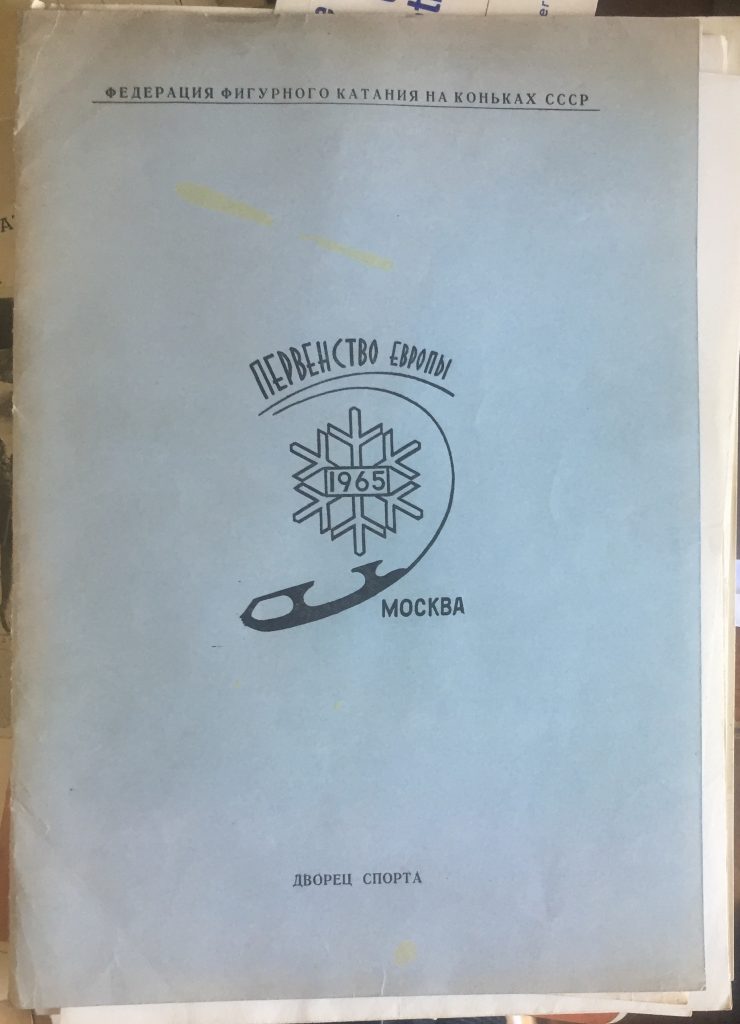
The cover of the European Championship folder
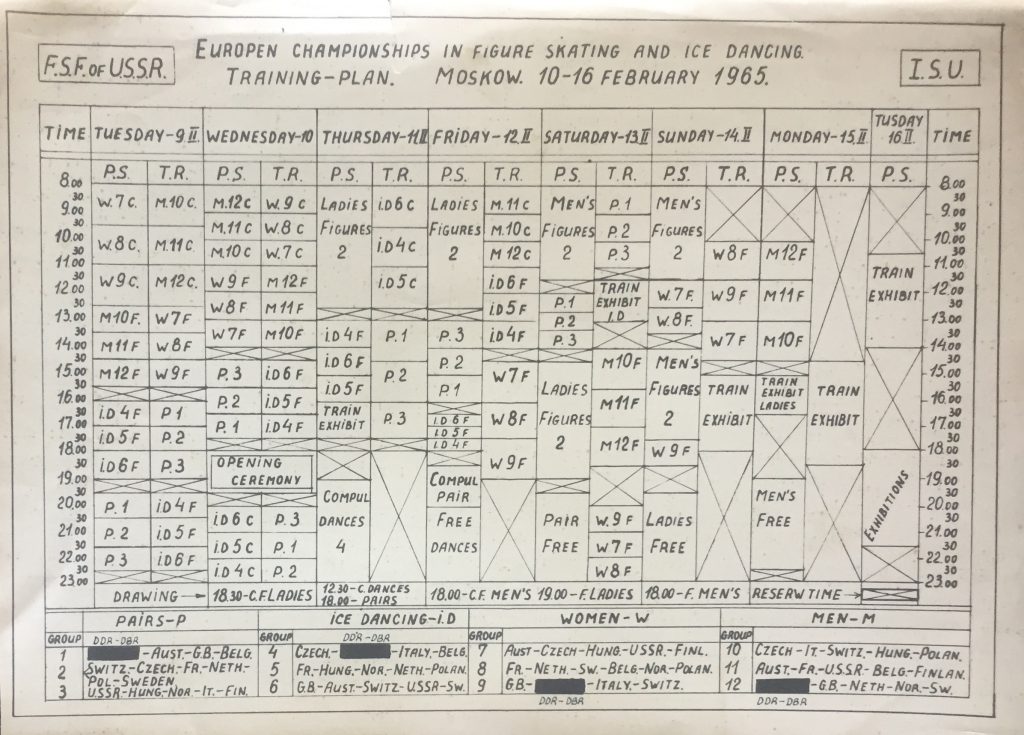
The complete programme of the European Championship, written in English language
Note that Germany was later deleted, and changed to DDR/DBR
These documents are very important, because they demonstrate how the figure skating judging worked.
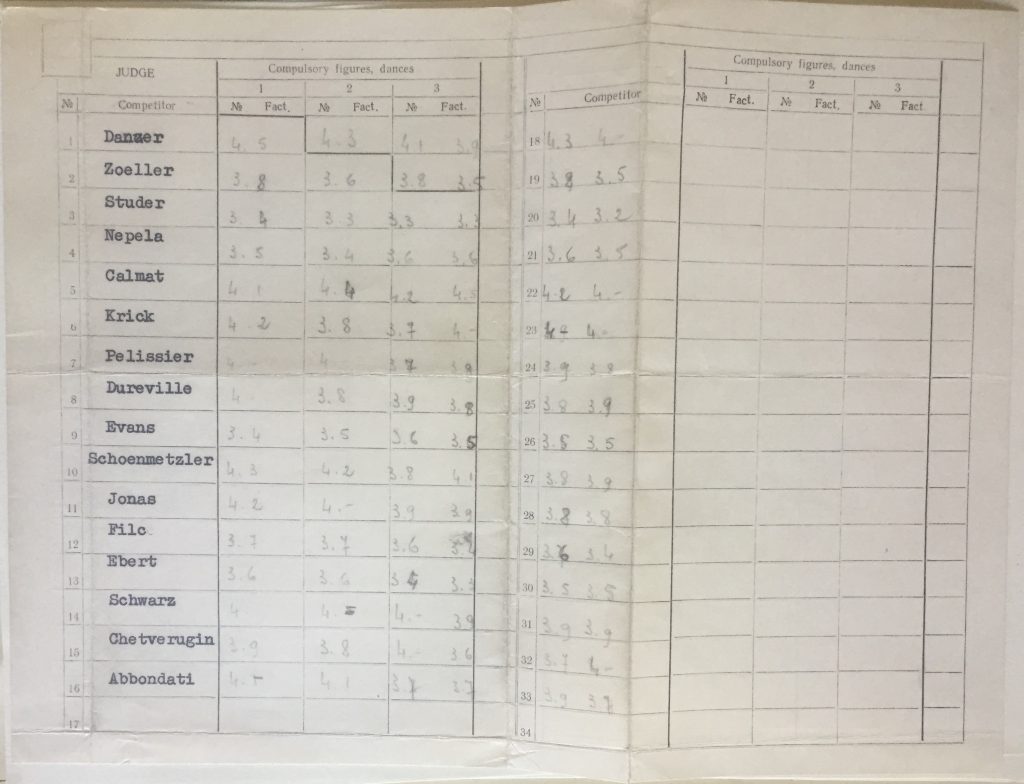
The table of men’s singles, with handwritten numbers: compulsory figures
The final results would be: Emmerich Danzer (1st), from Austria; Alain Calmat (2nd), from France; Peter Jonas (3rd), from Austria
The only Italian, Giordano Abbondati, was only 14th
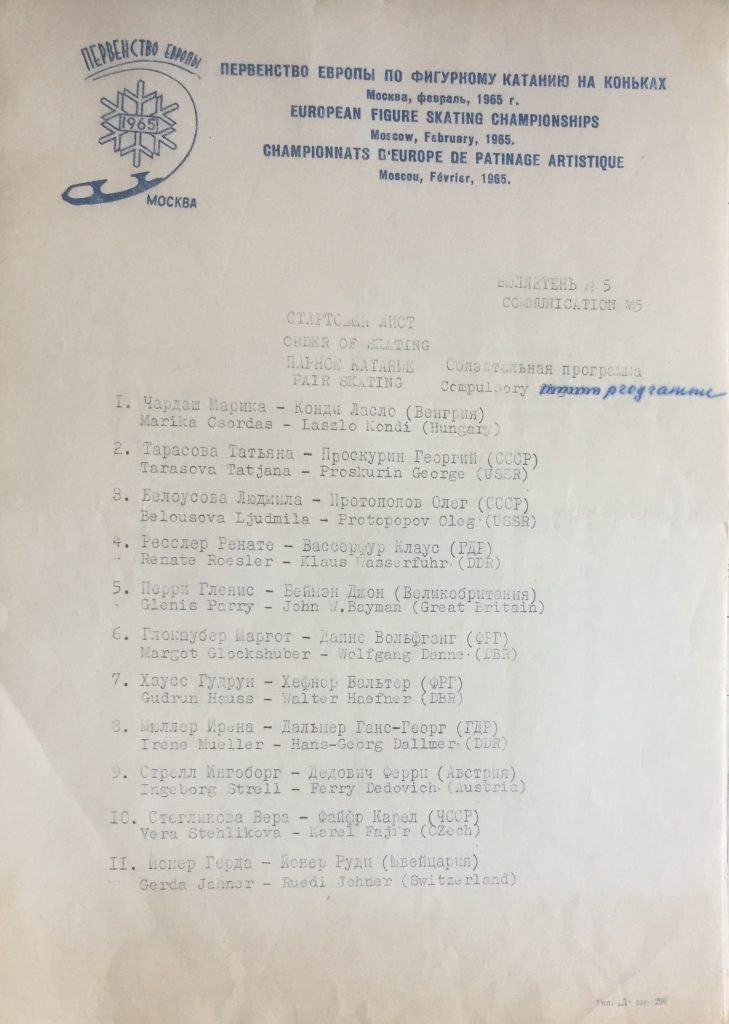
Pair skating compulsory programme, written in both Russian and English
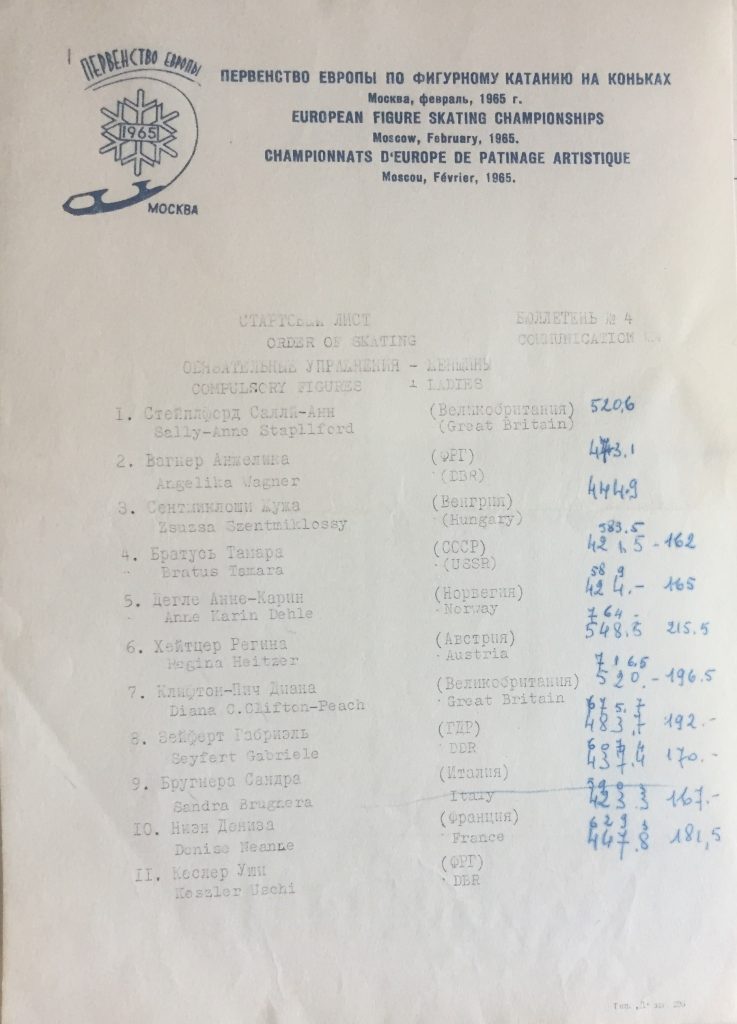
The programme of single ladies’ event, compulsory figures:
On the right, Grazia’s handwritten results
It was won by Regine Heitzer (Austria); Sally-Anne Stapleford (UK) was 2nd, Nicole Hassler (France) was 3rd
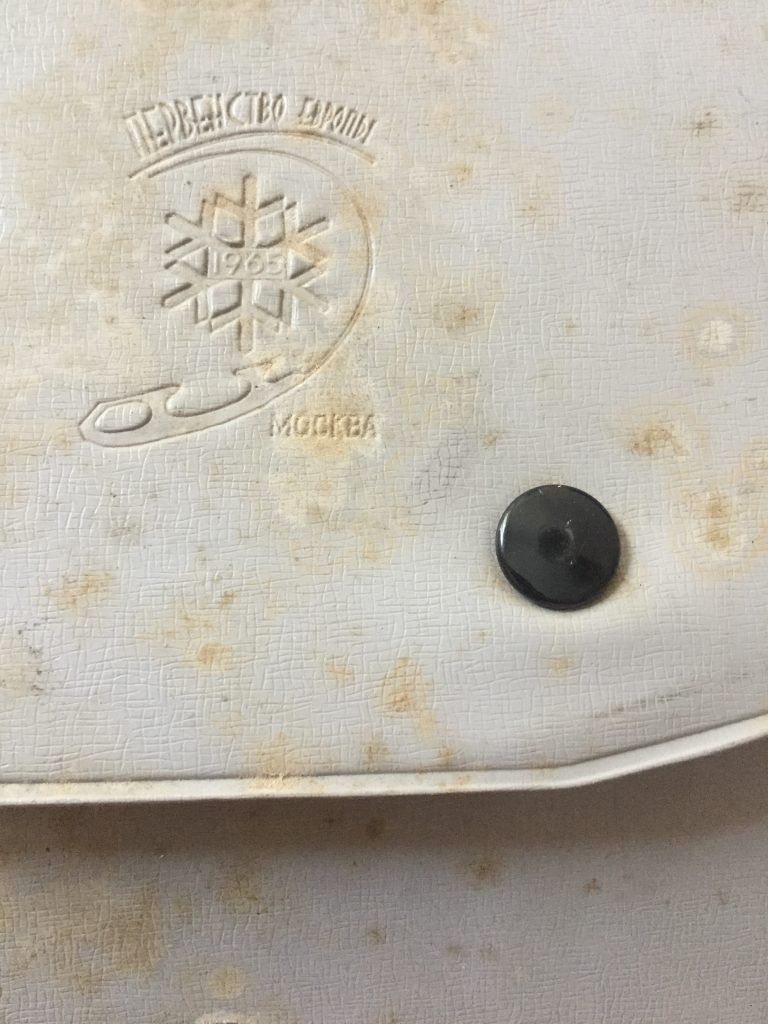
The plastic cover of the folder, and its beautiful logo
Then, even judging activity became too much for Grazia and she was forced to stop: there was no place for skating anymore in her life, except that is for the time she spent with her friend Franca … and for the few times when Carlo Fassi reached Milan: Cristina can still remember him and his family. In the house near the Palazzo del Ghiaccio, where the renowned ice skating trainer, who had helped a lot of athletes to win Olympic and World medals (such as Peggy Fleming, Dorothy Hamill, John Curry, Robin Cousins, and Jill Trenary), had the chance to become Carlino again, for a little while …
Article © Marco Giani
For more sources about Grazia Barcellona’s career, see:
https://sorelleboccalini.wordpress.com/extra_sport_la-pattinatrice-grazia-barcellona/
For more iconographical sources about ice and roller skating in Fascist Italy, see:
https://twitter.com/calciatrici1933/status/1036710349544857600
For the 1950 Sports Calendar by Masera, see:
https://sorelleboccalini.wordpress.com/extra_il-calendario-dello-sport-masera-1950/

